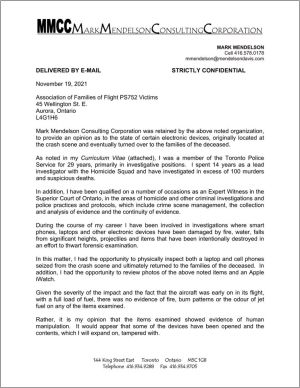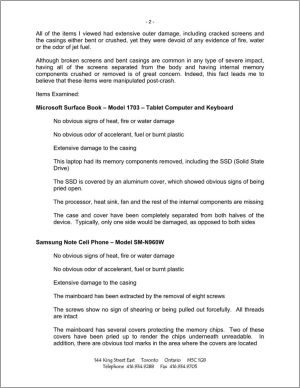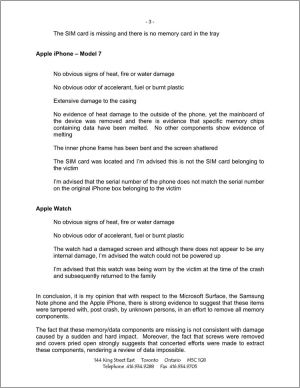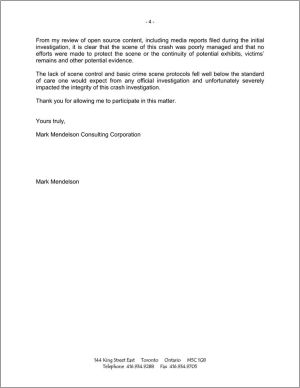DEDICATED TO THE INNOCENT VICTIMS OF FLIGHT PS752
1 UNBORN CHILD
29 CHILDREN
53 UNIVERSITY STUDENTS
8 ENTIRE FAMILIES
4 NEWLYWED COUPLES
176+1 GONE SOULS
11 FAMILIES WITH A SOLE SURVIVING PARENT
THOUSANDS OF BROKEN REMNANTS OF FAMILIES
|
|
|
ACKNOWLEDGEMENT
This report has been prepared by the Fact-Finding Committee of the Association of Families of Flight PS752 Victims. The Fact-Finding Committee was formed shortly after the establishment of the Association in March of 2020. The committee, composed fully of the families of victims, have closely collaborated with various military and aviation experts in discovering the truth and reasons behind the downing of Flight PS752.
This report is the result of over 20 months of painstaking labour by numerous individuals, including families of the victims as well as other friends of the Association. The production of this report was an initiative endorsed by the board of directors of the Association who have strived to lead the families’ efforts for honouring the victims of Flight PS752 and seeking justice for all those affected by this atrocity. The Association is profoundly grateful to all who contributed to the preparation of the report and embarked on this difficult and wearing path with an iron will.
First and foremost, the Association is thankful for the continued dedication and solidarity of the vast majority of the families of victims of Flight PS752, who gave meaning to the existence and integrity of the Association. We are also thankful for the immense support from the public all around the world who stood by the side of the families and amplified the voice of justice in various ways. There have been a number of experts and advisors who have worked alongside the Association, with a remarkable compassion like the families themselves, who empowered the families on all fronts and became a spark of light in this dark passageway of grief. Particularly, the Association is thankful for the valuable help and guidance given by our military and aviation experts, the names of whom are listed below:
Amir Kasravi, Shahrouz Jahanbin, Mehran Jannat Seresht, Farzin Nadimi, Iman Sadeghzadeh.
As the facts of the case lend themselves to the legal implications for the perpetrators of the downing of Flight PS752, the Association has been fortunate to have the generous support of expert lawyers in the field. We are thankful for the contributions made by our lawyers and legal advisors in the preparation of the report, namely:
Ryan Lax, Yonah Diamond, Sarah Teich, Kaveh Shahrooz, and David Matas.
The Association would also like to express its gratitude to Mr. John Thompson for the significant contribution he has provided by reviewing and editing this report.
Lastly, this report would not be possible without the night and day efforts of Ashkan Davoodpour, a family member of one of the victims and a key member in the Fact-Finding Committee. Many of the victims’ families directly assisted in preparing this report, whose names are mentioned below as a sign of gratitude:
Amirali Alavi, Neda Sedighi’s son; Salmeh BaniSadr, Niloufar Sadr’s daughter; Ashkan Davoodpour, Ghazal Nourian’s brother-in-law; Navaz Ebrahim, Niloufar’s sister and Saeed Tahmasebi’s sister-in-law; Hamed Esmaeilion, Parisa Eghbalian’s Husband and Reera’s father; Daniel Ghods, Saba Saadat’s partner; Javad Soleimeni, Elnaz Nabiyi’s Husband, and Jane Doe, a victim’s sister.
Notably, many individuals have helped the Association collect first-hand evidence and documentation, prepare various reports, and assist in the important tasks of translation, subtitling videos, and other critical duties. For their security and safety, we will refrain from mentioning their names. From the bottom of our hearts, we appreciate their courage and humanity.
Javad Soleimani
Chair of the Fact-Finding Committee
LIST OF ABBREVIATIONS AND ACRONYMS
| Abbreviation/Acronym | Meaning |
| AAIB | Air Accident Investigation Board |
| ACC | Area Control Centre |
| ADD | Air Defence District |
| ADOC | Air Defence Operations Centre |
| ADS-B | Automatic Dependent Surveillance - Broadcast |
| ADU | Air Defence Unit |
| AFM | Aircraft Flight Manuals |
| AFV752 | Association of Families of Flight PS752 Victims |
| AGL | Above Ground Level |
| ALCM | Air-Launched Cruise Missile |
| AMM | Aircraft Maintenance Manual |
| AM | Ante Meridiem (Latin), Before Noon |
| AoA | Angle of Attack |
| ARINC | Aeronautical Radio Inc. |
| ATC | Air Traffic Control |
| ATD | Actual Time of Departure |
| BEA | Bureau d'Enquêtes et d'Analyses |
| BHS | Baggage Handling System |
| CAO.IRI | Civil Aviation Organization of Islamic Republic of Iran |
| CBC | Canadian Broadcasting Corporation |
| CCTV | Closed Circuit Television |
| CEO | Chief Executive Officer |
| CMOCC | Civil-Military Operational Coordination Center |
| CP | Command Post |
| CV | Combat Vehicle |
| CVR | Cockpit Voice Recorder |
| DNT | Dinitrotoluene |
| ETKA | Administration of Logistics of Staff Army |
| FAA | Federal Aviation Administration |
| FCOM | Flight Crew Operating Manual |
| FCU | Fuel Control Unit |
| FDR | Flight Data Recorder |
| FFC | Fact Finding Committee |
| FG | Flight Guidance |
| FIR | Flight Information Region |
| FL | Flight Level |
| GPS | Global Positioning System |
| GSAF | General Staff of the Armed Forces |
| HRM | Human Rights Monitor |
| I.R. | Islamic Republic |
| IADS | Integrated Air Defence System |
| IATA | International Air Transport Association |
| ICAO | International Civil Aviation Organization |
| IFR | Instrument Flight Rules |
| IKA | Tehran Imam Khomeini International Airport |
| IKAC | Imam Khomeini Airport City |
| IPA | Iran Prison Atlas |
| IPC | Islamic Penal Code |
| IRGC | Islamic Revolutionary Guard Corps |
| IRIADF | Islamic Republic of Iran Air Defence Force |
| KAADB | Khatam-al-Anbiya Air Defence Base |
| KAJADHQ | Khatam-al-Anbiya Joint Air Defence Headquarter |
| METAR | Meteorological Aerodrome Reports |
| NAVAID | Navigational Aid |
| NM | Nautical Mile |
| NOTAM | Notice to Airmen |
| NTSB | National Transportation Safety Board |
| NVM | Non-Volatile Memory |
| PFD | Primary Flight Display |
| PFLP-GC | Popular Front for The Liberation of Palestine – General Command |
| PM | Post Meridiem (Latin), After noon |
| RCMP | Royal Canadian Mounted Police |
| SAM | Surface-to-Air Missile |
| SAVAK | Sāzemān-e Ettelā'āt va Amniyat-e Keshvar (Iranian Intelligence and Security Organization of the Country) |
| SAW | Istanbul Sabiha Gokcen International Airport |
| SI&A | Serious Incident and Accident Investigation |
| SITA | Société Internationale de Télécommunications Aéronautiques |
| SOC | Sector Operation Control |
| TAR | Target Acquisition Radar |
| TNT | Trinitrotoluene |
| TSB | Transportation Safety Board |
| TT | Tehran Time |
| TTR | Target Tracking Radar |
| UN | United Nations |
| USS | United States Ship |
| UTC | Coordinated Universal Time |
FOREWORD
On January 8, 2020, 176 passengers and crew, and one unborn child on board Ukraine International Airlines Flight PS752 lost their lives. Flight PS752 crashed nearly 6 minutes after takeoff from Tehran’s International Airport. The Islamic Revolutionary Guards Corps (IRGC) of Iran brought down the aircraft by firing at least two missiles at it. I lost my wife, Parisa Eghbalian, and my nine-year-old daughter, Reera Esmaeilion.
The effects of this calamity were felt all around the world. Iran and five other countries lost citizens—Canada, Ukraine, Sweden, Afghanistan, and the United Kingdom. 138 of the passengers had close ties with Canada; fifty-five were Canadian citizens, thirty were permanent residents, and many others were studying at universities and other education centers in Canada, Germany, Sweden, Switzerland, and Great Britain.
Initially, the Islamic Republic of Iran’s government issued a blanket denial of wrongdoing and claimed that the Ukrainian airliner crashed as a result of technical failures. Only after mounting undeniable fact that the IRGC had shot down the airplane.
The government of Iran then pivoted and claimed that the missiles were fired by the IRGC as a result of “human error”. Iran hoped that the victims’ families would accept that narrative of human error, with no evidence, and accept the title of “martyr” for their lost loved ones, claiming those killed died for the Islamic Republic of Iran and obscuring that they were killed by Iran. Iran hoped that the families of victims would line up to receive financial compensation from the hands of the government that had killed their loved ones and move on.
The Islamic Republic of Iran was wrong. The families of the victims were adamant to find answers and would not accept lies. Iran’s government has made several attempts to undermine the truth by publishing highly flawed reports that leave almost all relevant questions unanswered, culminating in an incomplete and flawed “final report” published in March 2020. While there are many questions that remain unanswered from those reports, and investigation of Iran’s military - which launched the missiles - was deemed outside the scope of the report, Iran’s incomplete reports also gave rise to many more questions that need to be answered. All the while, the government of Iran’s judiciary was preparing an indictment to initiate legal proceedings domestically to control information about the incident. This took place while all access to witnesses and evidence were blocked. Anyone who attempted to disclose any evidence was persecuted. There was no sign of the truth in Iran’s technical or judicial reports. The evidence that the government of Iran provided in support of their “human error” theory remains contrived, misleading, self-serving, and unsubstantiated.
The survivors of the tragedy demanded that the International Civil Aviation Organization (ICAO) and the affected states initiate technical and criminal investigations. The ICAO could have participated in managing the technical aspects but refused to engage. By establishing a “Forensic Team”, the Canadian government promised the families to disclose the truth - or at least some of it. A criminal investigation was initiated by the Ukrainian government but as of time of the publication of this document, the families are not privy to the details of such proceedings.
The Royal Canadian Mounted Police (RCMP) refused to directly participate in, or help with, Ukraine’s criminal investigations through a possible joint investigation and, instead, decided to cooperate with Ukraine on the level of collecting and processing some information. Progress and cooperation, by all accounts, has been frustratingly slow.
Meanwhile, the Canadian Prime Minister’s Special Advisor, the Honorable Ralph Goodale, published his report in December 2020, which was Canada’s response to this atrocity. Mr. Goodale’s report posed questions that the Islamic Republic of Iran must answer. Shortly thereafter, Dr. Agnès Callamard, the United Nations former Special Rapporteur on extrajudicial, summary, or arbitrary executions, published a more detailed analysis in her February 2021 report, finding that Iran flagrantly breached the human rights of the passengers of flight PS752, including their right to life, by failing to take almost any reasonable steps to protect them. In addition to the human rights infractions, Dr. Callamard’s report further shed light on the legal aspects of the case. Many unanswered questions were also set out in her report, but Iran refused to respond to them—much like their reaction to those posed by Mr. Goodale. Human Rights Watch, an international non-governmental organization, published a report in the spring of 2021 that further emphasized the extensive human rights breaches of the government of Iran, which continues to claim thousands of innocent victims. Unfortunately, the report published by Canada’s Forensic Team in June 2021 not only failed to reveal the truth or even parts thereof, but it also led to further questions.
Many experts believe that Iran’s claim that their Tor-M1 Surface-to-Air Missile (SAM) system was misaligned by 105-degrees, along with a multitude of other critical “mistakes”, are highly unlikely and fundamentally false. Instead, these claims are part of an attempt to deceive the public and contain responsibility at the level of errors of low-level military officials. The victims’ families believe that the affected countries have a responsibility to pursue and discover the truth behind this heinous crime through all available means. How and why were their citizens murdered?
Immediately after the downing of flight PS752, Canada proactively engaged the affected countries by forming the “International Coordination and Response Group”. This was an effort to unify the parties towards transparency, accountability, and justice. The Association continues to support this initiative as long as the victims’ families remain at the forefront of the decision-making process. The Association firmly believes that the only path to justice is through an impartial, international tribunal that is protected from the Islamic Republic of Iran’s distortions.
Over the past 43 years, the government of Iran has committed countless crimes with impunity both domestically and internationally. Many tragic examples such as Zahra Kazemi, Kavous Seyed Emami, Nazanin Zaghari-Ratcliffe, Ahmadreza Jalali, Niloufar Bayani and Anousheh Ashouri clearly demonstrate the Islamic Republic’s modus operandi. Hundreds of government sanctioned assassinations on foreign soil only add to the severity of the problem. It is based on this historic evidence that the families insist on the importance of forming an impartial, international tribunal to deal with such matters and hold the Islamic Republic accountable.
Canada introduced its “Safer Skies Initiative” in order to address the many shortcomings in international law and ICAO regulations that the downing of flight PS752 has revealed: country that shoots down a civilian airliner cannot be trusted to investigate the incident, especially a government like Iran’s that places no value on transparency or human life. There is a fundamental conflict of interest here that applicable international law fails to address. Furthermore, and in an effort to enhance the legal path forward for the victims of flight PS752, the Canadian government appointed the renowned international law professor, Payam Akhavan, as a senior legal advisor in respect of this issue.
Canada designated January 8 as the National Day of Remembrance of the victims of air disasters, an initiative welcomed by the families. Since January 8, 2020, the Canadian government has actively engaged with the families and with the cooperation of the Association, facilitated consular services to process visas and other related cases to support the victims’ families. Canada also initiated several scholarship programs in honour of the many victims who were students, academics, and researchers in Canadian institutions.
Over the past 22 months, the victims’ families have been inundated with various forms of support from the community and generous human beings around the world. Official organizations and individual experts such as law firms, technical experts, researchers, and many others have volunteered their services to the Association. These heartwarming expressions of solidarity have been a source of energy for all of us.
The Association of Families of Flight PS752 Victims is a community-based organization founded by the families of victims of Flight PS752. While we are grateful for the cooperation received from other governments, we are frustrated by the limited progress achieved to date. Governments like that of Canada have produced several reports in respect of flight PS752, but they are limited in nature. We have established a broad network of supporters in Iran, Europe, and North America, and we have actively engaged that network in accumulating evidence and documentation from a wide variety of sources, including publicly available information, information from technical experts offering to contribute their expertise, and information conveyed confidentially by individuals in Iran. After recognizing the incomplete fact-finding in other reports published in respect of Flight PS752, the Association decided to compile and publish its own findings. It seeks to cover the various aspects of this crime, study similar examples and leave the readers to draw their own conclusions as to what happened in the morning of January 8, 2020. We do not yet have all of the answers. This report includes important evidence not considered by other authorities.
The families of the victims of Flight PS752 are resolute in finding the truth and seeking justice. The hope remains that the governments of various affected countries such as Canada, Ukraine, Sweden, and Britain proceed with more seriousness and utilize all available means, including the International Court of Justice (ICJ) and the International Criminal Court (ICC), to bring the perpetrators of this crime to justice.
Hamed Esmaeilion
President of the Association of Families of Flight PS752 Victims
METHODOLOGY
This report has been prepared by the Association’s Fact-Finding Committee over the past 22 months. In the first 17 months, gathering of information and evidence was carried out. The last five months were utilized in organizing the available information and preparing this comprehensive report.
The objective of this report is to compile and analyze available evidence surrounding the downing of Flight PS752 and make supported conclusions around the hows and whys of the downing of Flight PS752.
In addition to Iran’s final report, we examined and used reports of the Special Advisor to the Canadian Prime Minister, the UN special rapporteur, and the Canadian Forensic team.
Technical books and other forms of literature were utilized and cited in the preparation of this report. Furthermore, the FlightRadar24 website was utilized in assessing the state of Iran’s airspace on January 8, 2020 and comparing these findings with the claims made by Iranian authorities regarding the Iranian airspace.
In the making of this report, the Association collaborated with individuals with expertise and work experience in the civilian and military aviation industry, as well as individuals with expertise in air defence units and systems. The expertise and backgrounds of these individuals include: military and defence analyst, air-safety expert, aerospace system expert, pilot with 50 years of experience in Iran’s civil aviation industry, as well as station chief within Tehran’s international airport.
The Association has also gained access to audio files of Iran’s former Minister of Foreign Affairs, Javad Zarif, Iran’s head of the AAIB, Hassan Rezaeifar, as well as one other top Iranian official. For the protection of our sources, we do not mention the position and name of this top Iranian official. The contents of these audio recordings were utilized and cited as support and evidence for conclusions reached in the report.
Interviews were also conducted with individuals within Iran’s air defence network which provided the Association with valuable insight into the structure and condition of the Iranian air defence system. Testimonies of family members based on their last conversations with Flight PS752 passengers and with Iranian judiciary officials were also used.
Public interviews and speeches of Iranian officials were gathered, archived, closely analyzed, and utilized in this report. This includes statements made by military officials both prior to and following the downing of Flight PS752. Specifically, these claims were assessed in relation to the conditions of Iranian airspace on January 8, as well as assessing the motivations of the government of Iran for shooting down Flight PS752.
Prior to publication, this report has been reviewed and approved by various military and aviation experts. The legal components of this report have also been assessed and approved by renowned lawyers.
EXECUTIVE SUMMARY
The downing of Ukraine International Airlines Flight PS752 by military forces of the Islamic Republic of Iran, minutes after taking off from Tehran’s Imam Khomeini International Airport (IKA) is unprecedented. The Flight was shot down by Tor-M1 surface-to-air missiles in the hands of the Islamic Revolutionary Guard Corps (IRGC).
This incident took place in a state of heightened military tension in the region. The missile strike on Flight PS752 occurred four hours after Iran launched retaliatory missile strikes on US positions in Iraq for the killing of Major General Qassem Soleimani.
Iran’s Aircraft Accident Investigation Board (AAIB) published a Final Report on March 17, 2021, yet this was deemed to be incomplete and confusing by the other affected countries—Ukraine, Canada, the United Kingdom, Afghanistan, and Sweden—as well as various aviation and military experts, and the victims’ families. Iran’s report excluded from its scope investigation of the very military that shot down the plane. It did not provide any credible explanation of the downing of Flight PS752 by the IRGC and raised further questions.
Various reports have been published since, such as the one written by the Honourable Ralph Goodale, the Prime Minister of Canada’s special advisor on the downing of Flight PS752; the one prepared by Dr. Agnes Callamard, the United Nations (UN) Special Rapporteur in February 2021; and the report published by Canada’s Forensics Team released in June 2021. These reports attempted to reveal elements of the truth behind the downing and answer many of the unanswered questions surrounding this case. As a result of the lies and obfuscation of the government of Iran, many questions remained unanswered.
The Association of Families of Flight PS752 Victims, which represents 140 of the victims, has compiled this report to take an important step towards discovering the truth surrounding the downing of Flight PS752 and bringing the perpetrators to justice. In preparing this report, various resources have been used, including publicly available information, audio files recording conversations with high-ranking Iranian officials, testimonies of the families of the victims, and numerous other published reports on this case. We have also consulted several experts in aviation and relevant military systems as well as lawyers with expertise in applicable law.
We cannot blindly accept Iran’s assertions. It is the belief of the Association that high-ranking officials of Iran are responsible for the downing of Flight PS752 and not just a handful of low-ranking IRGC members as per the claims of the government of Iran. Some of the conclusions made in this investigative analysis have not been mentioned in any of the other previously published reports, and others are based on information publicly available thus far. There is no doubt that many questions still need to be answered. Some key conclusions made in this report are highlighted below:
- 1. Airspace Left Open: Following IRGC’s missile strike on American bases in Iraq and only hours prior to the downing of Flight PS752, Iranian authorities kept the airspace open and used civilian air travelers as human shield.
This finding is based on statements made by the IRGC and Iranian officials. The Aerospace Force Commander of the IRGC and the Commander-in-Chief of the Revolutionary Guards explicitly declared the situation in Iran as a state of war after the attack on American bases in Iraq. Following the assassination of the commander of the Quds Force in Iraq by the United States, US President Trump explicitly warned that 52 different points in Iran would be attacked if Iran would retaliate. According to Amir Ali Hajizadeh, the Aerospace Force Commander of the IRGC, one of these 52 points was the residence of the Supreme Leader of the Iranian government. Moreover, during a press conference on January 11, 2020, Hajizadeh explicitly stated that the country was in a war situation and mentioned that a request to close Iran's airspace was not approved by the “relevant authorities.”
Details on the decision to keep Iran’s airspace open despite the clear risks to civilian air travel are further explored in Section 5.1 of this report.
- 2. Iran's False Claim Regarding Evacuation of Airspace in West of the Country
Iran’s Final Report presents claims that the country's western skies were gradually evacuated for passenger planes as a preventive measure and in anticipation of a “conflict.” However, examining the airspace over western Iran at different times in early morning of January 8, 2020, before and after Iran’s attacks on American bases in Iraq shows that Iran's skies were not evacuated even in the claimed western corridors of the country. Western corridors were not evacuated until 20 minutes prior to PS752’s downing. In fact, all flights in the western corridors of the country were at risk from the time of attacks on US bases until shortly before the downing of PS752.
Details of keeping the Iranian sky open in the west of the country based on the information of FlightRadar24 can be seen in Section 5.1.2 of this report.
- 3. Highly Experienced Tor-M1 Operator: The operator of the Tor-M1 system that shot down the aircraft had vast experience and expertise with short range missile systems including his service in Syria.
This finding is based on comments made by the authorities of Tehran’s military court, including the prosecutor of the case in meetings with the families of the victims. In fact, the operator had significant expertise with short-range missile systems, including from his service in Syria.
Given the experience of the operator, it is difficult to imagine that the operator could not distinguish between an alleged cruise missile and PS752.
- 4. No Evidence of Communication Disruption: The government of Iran has not provided any evidence to prove that the Tor-M1 missile system was not able to communicate with the country's integrated defence network when deciding to fire a missile at Flight PS752.
Given Iran’s claims with respect to communication disruptions, the question remains on how the same system was in contact with the integrated defence network to receive the news of the supposed cruise missile attacks yet was absent for receiving confirmation for the firing at the aircraft. Iran has not provided any evidence suggesting communications were in fact disrupted between the involved missile launcher crew and their commanders.
It is probable that this system may have been added to Tehran’s air defence ring by the IRGC independently from the integrated defence network and was only in contact with top IRGC commanders who, with a false warning of incoming cruise missiles, permitted the shoot-down of Flight PS752.
The black box of this air defence unit records all data with time stamps including the conversations between the unit’s operators and their commanders. The Tor-M1 black boxes must be disclosed, and analyzed through an independent investigation, which must also have access to the operator, the senior commanders of the country's defence network, and the IRGC in order to reveal who ordered the downing of the plane.
More details in this regard are given in Section 5.5 of this report.
- 5. Implausibility of Misidentification: It is highly unlikely that the Tor-M1 missile system operator could not distinguish the aircraft from a cruise missile, as claimed by Iran.
This finding is based on the technical capabilities of the Tor-M1 system and its proximity to the two international airports in Tehran, namely IKA and Mehrabad.
Cruise missiles and the Boeing 737-800 series have major differences in various parameters such as length, Radar Cross Section (RCS), speed, altitude, and motion profiles, which make them appear differently on the Tor-M1 system display. It is implausible that the missile system operator simply confused a much larger civilian aircraft, moving in more gradual patterns and at a slower speed, for a cruise missile.
More information on the capabilities of the Tor-M1 system to distinguish between the Ukrainian civilian aircraft and a cruise missile is provided in Section 5.2 of this report.
- 6. Implausibility of a 105-Degree Misalignment: The alleged 105-degree calibration error in finding true north orientation of the Tor-M1 missile system is highly unlikely and appears to be fabricated.
This finding is based on the technical features of the Tor-M1 Missile system and inconsistencies within Iran’s Final Report. After 7 months, Iran propagated this so-called 105-degree misalignment to demonstrate that in the eyes of the Tor-M1 operator, the plane was not moving from south to north, but rather from west to east. Our thorough analysis suggests that the alleged 105-degree error was an act of falsification carried out by Islamic Republic of Iran to convince the world that “human error” in re-alignment of the Tor-M1 unit was the cause of the downing.
Detailed explanations about the 105-degree error are given in Section 5.3 of this report.
- 7. Screening For US Citizenship: At the designated security checkpoint at Tehran International Airport, controlled by the IRGC, some passengers were asked about having an American passport.
According to the testimony of a number of families, some travelers were asked if they had an American passport and if the destination of any of the travelers was going to be the United States. The IRGC may have ensured that there were no passengers onboard Ukraine International Airlines Flight PS752 with American citizenship.
- 8. Questionable 57-minute delay: It is possible that a passenger or some passengers disembarked the aircraft within the 57-minute delay.
Iran’s Final Report stated that the reason for the delay was unloading 4 pieces of baggage and replacing them with some passengers’ carry-on luggage to accommodate an overweight issue. According to experts familiar with IKA check-in and Baggage Handling System (BHS), the proposed explanation cannot account for such a long delay of 57 minutes.
In their last contacts with their families, some of the victims indicated seeing some passengers disembarking from the aircraft. To reveal information regarding this question and find certainty, the CCTV cameras of IKA overlooking the plane should be examined in an independent investigation.
- 9. Rerouting of Atlas Global Flight: Flight KK1185 of Atlas Global Airlines was given a different path to bypass military sites from which the missiles were fired at PS752.
Flight KK1185 of Atlas Global had the same scheduled departure time as Flight PS752 (at 05:15 AM) and unlike PS752, it departed IKA without delay. Based on analysis of previous travel paths of this flight, it is evident that KK1185 was routed to use a different checkpoint than what it had used on a regular basis in the past couple of months.
Upon a closer look, it can be seen that on January 8, 2020, Flight KK1185 was routed through a different checkpoint to bypass military sites from which the missiles that shot down PS752 were launched. Releasing conversations of Flight KK1185 with the airport traffic control towers and Iran’s Civil-Military Operational Coordination Center (CMOCC) can help find the true reasons behind this questionable change.
More information on Atlas Global Flight KK1185 is provided in Section 5.10.4 of this report.
- 10. Tactical Movement and Misidentification: The evidence does not support the plausibility of PS752 being the only flight that was “mistaken” for a “hostile target” despite the fact that there were earlier flights with similar speed, altitude, route and other specifications as PS752.
Islamic Republic of Iran has claimed that at 4:54 AM, the ADU was moved for 100 meters due to tactical reasons and this introduced a misalignment error to the system. Iran further claims that after the movement the ADU was on “standby” mode until 6:07 AM when it switched to the operational mode.
The Canadian Forensic team rejects Iran’s claim that the ADU had been on “standby” mode for more than an hour under “war situation” and concludes that after the alleged movement at 4:54 AM, four other flights were tracked by the ADU and could have had the same fate as PS752.
Analysis of the last four flights which departed IKA prior to PS752 shows that the operator(s) would have had multiple chances to realize that there is an error in the system and could have fixed the error if there were any. Instead, they decided to target only Flight PS752. This issue has not been explained by the Canadian Forensic Team, and therefore this scenario remains as an unproven theory unless proven with facts.
Section 5.10.6 of this report explains why this theory is implausible.
- 11. Systematic Cover-up: For three days, with the involvement of senior Iranian officials, the government of Iran systematically and falsely declared that Flight PS752 had crashed due to a technical failure.
This finding is based on the audio file and reports of the meetings of Iran’s previous Foreign Minister as well as the meetings at the Supreme National Security Council of Iran.
The Association has obtained an audio recording of a meeting of Iran’s former Foreign Minister, Mohammad Javad Zarif, highlighting that he was pressured by Ali Shamkhani, Secretary of the Supreme National Security Council, and Mohammad Hossein Bagheri, Chief of Staff of the Iranian Armed Forces, to publicly propagate the narrative that Flight PS752 had crashed due to a technical failure.
Furthermore, bulldozing the crash site and not delivering many electronic devices of passengers and flight crew clearly demonstrate the government of Iran’s attempts to systematically conceal the downing of flight PS752.
More details are given about the systematic concealment of the cause of the downing and the deceitful behavior of Iranian government in Sections 1.3, 1.4, and 6.1.1 of this report.
- 12. Interference with Physical Evidence: Examining some victims’ electronic devices by experts demonstrates that, other than physical damage as a result of the crash, the devices were subjected to systematic destruction.
The victim’s belongings were allowed to be looted and many of the passengers’ personal devices were never returned. The devices that were recovered, however, were subjected to interference including damage that is not consistent with a crash of this kind. A professional inspection of the devices that were returned to the families led our investigators to conclude that key memory and communication components of the electronic devices were damaged in a targeted manner after the crash.
More details on this exclusive finding are presented in Section 5.13 of this report.
- 13. Mishandling of Forensic Procedures: The bodies of some of the victims have not been properly identified.
The Association has obtained evidence that DNA testing on some victims’ bodies did not match their stated identification by Iranian authorities. This neglectfulness on the part of the government of Iran has had serious psychological consequences for families, some of whom did not receive the whole bodies of their loved ones and were given the remains of other victims instead.
More details in this regard are given in Section 6.1.2 of this report.
- 14. Harassment of Families: After the downing of PS752, the government of Iran intimidated and harassed the families of many of the victims in numerous ways. At least one case of physical torture of family members is confirmed in addition to numerous cases of summons and detention.
Calling the innocent victims as martyrs, congratulating the families for the martyrdom of their loved ones, pressuring families to bury their loved ones in the martyrs' plot, hijacking the funerals and memorial services, pressuring families to remain silent, and preventing litigation efforts have been among the cases of harassment of families.
Detailed explanations about the multiple violations of the basic rights of families are given in Chapter 6 of this report.
- 15. Persecution of Peaceful Protesters and Mourners: In addition to cracking down on protesters and mourners of this tragedy, the government of Iran has detained many and issued harsh sentences such as long prison terms.
After admitting that the plane was shot down by the IRGC, many individuals in various parts of Iran began to protest and light candles for the victims. The government responded by cracking down on the protesters and mourners.
More details about severe punishments and sentences of some of these protesters and mourners are provided in Section 6.3 of this report.
- 16. Iran’s AAIB Lacking Legitimacy to Conduct Investigation: Iran's AAIB did not have the legitimacy to conduct an investigation into the downing of Flight PS752. In spite of this, various involved countries, including Canada, allowed the AAIB of the Islamic Republic of Iran to conduct investigations through their inactions in the International Civil Aviation Organization (ICAO) council.
This finding is based on the lack of independence of Iran’s AAIB from the Iranian government, as well as their technical incompetence, collusion of senior officials of Iran’s Civil Aviation Organization (“CAO.IRI”) and AAIB in the initial denial efforts, and their past involvement in terrorist activities.
More details in this regard are given in Chapter 3 of this report.
A Disturbing Conclusion
Based on the findings of this report, the Association of Families of Flight PS752 Victims believes that Flight PS752 was not shot down as a result of a human error of one operator, nor was it a consequence of multiple errors in the defence system as claimed by Iran. At the highest levels of military alertness, the government of Iran used passenger flights as human shield against possible American attacks, by deliberately not closing the airspace to civilian flights.
The downing of the Flight PS752 could not have been a horrific combination of some remote coincidences. The intentional act of keeping Iranian airspace open, the technical capabilities of the Tor-M1 system and Iran's integrated defence network in detecting hostile targets, the positioning of the Tor-M1 system near Tehran’s international airport, the systematic concealment of the root cause of the crash, the destruction of existing evidence, and Iran's misleading reports, all indicate that the downing of Ukraine International Airlines flight 752 was deliberate. The onus was on the government of Iran to be transparent and conduct a full, thorough, and fact-based investigation, and to disclose all relevant facts—which it failed to do. It is Iran’s responsibility to provide evidence that it did not intentionally target the aircraft.'
The families of victims cannot be expected to know the reasons and motives for the deliberate downing of the aircraft. Reading the minds of criminals is complicated and sometimes impossible. However, in sections 7.3 and 7.4, some scenarios and possible motives of the government of Iran to shoot down the aircraft are explored. Preventing a war between Iran and the United States based on the strategy of asymmetric warfare could be one of the main reasons for the downing of the plane. Hossein Salami, the Commander-in-Chief of the IRGC, gave a speech on January 12, 2020, signalling that the Iranian government's decisions at the height of tensions between Iran and the United States could have been based on an asymmetric warfare strategy.
The 43-year history of the government of Iran demonstrates that the intentional downing of a passenger plane by this government is not an inconceivable action and of a different nature from other instances of wanton disregard for human life. It should be noted that the killing of civilians could be rooted in the ideological beliefs of Iranian government leaders. For example, Ayatollah Khomeini, the founder of the 1978 Islamic Revolution stated in a speech in the presence of the military: “If infidels [non-Muslims] … or corrupted Iraqis, took a group of innocent Muslims as human shield … it is obligatory for us to kill both Muslims and non-Muslims. The [innocent] Muslims are martyrs and go to heaven, and the non-Muslims are infidels and go to hell.” (Ruhollah Khomeini, August 18, 1981, Tehran).
In February 2020, by posing a series of unanswered questions and highlighting the contradictions in Iran's Final Report, Dr. Agnès Callamard, the UN Special Rapporteur, correctly demonstrated that the government of Iran has acted in a deceptive manner and that the intentional downing of PS752 must be seriously investigated.
The report of the Canadian Forensic Team, despite recognizing the role of senior Iranian government officials in the downing of the plane, failed to help families find the truth. The report concluded that no evidence of a premeditated attack had been found. We acknowledge that evidence of premeditation is difficult to find. However, we submit that their investigation is incomplete—there are many examples of the tactics that a government like that of Iran can use to deflect or deny an inconvenient external inquiry.
Government of Canada and other affected countries—Ukraine, the United Kingdom, Sweden, and Afghanistan—should defend the rights of their citizens, residents, and travelers with deep ties in pursuing the needs of the victims’ families, contesting Iran’s obfuscation in every available forum, and pursuing the truth and justice.
A proper and transparent investigation is needed to reach the truth and justice for the downing of Flight PS752.
Demands of the Association of Families of Flight PS752 Victims
Despite the gravity of the crimes committed by the Islamic Republic of Iran, the affected countries have not yet been able to adequately hold the Iranian government accountable. This is due to the obfuscation of the truth surrounding the downing of Flight PS752, obstructions in the path to justice, and gaps in the international rules and regulations. The Association has recommended a series of actions by the relevant authorities to address these shortcomings.
The affected countries and the ICAO have repeatedly called for an independent, impartial, and international investigation into this crime. In addition, the families of victims have regularly demanded to gain more exposure to and be involved in the investigation.
Unfortunately, there is no mechanism in international law for affected families to actively participate in truth-seeking and justice. The ICAO rules go back more than seventy years. The country in which the crash took place is responsible for the technical investigation, and the families cannot bring these disputes to the international community independently. International law in this regard is inefficient and cumbersome and is set more in the direction of the needs of governments than those of the victims of the crime and terrorism.
Annex 13 and ICAO rules must change to prevent criminal and authoritarian governments from senselessly taking the lives of innocent passengers. Both technical and criminal investigations must be taken out of the hands of a government responsible for shooting down a plane. In this regard, we demand the following reforms to international law governing these and other similar circumstances:
- Where a country shoots down a plane in its own airspace, it must not have responsibility for investigating the circumstances and causes of the crash.
- The victims’ families must have a formal role as observers in the investigation, and the international community must have an official role in supervising the return of their relatives’ bodies and property.
- All countries of which victims are citizens must have equal rights of participation in the investigation to the country of aircraft registration and the country of the crash.
While such reforms are needed to minimize the chances of similar events happening in future, it is still critical to clarify the truth and circumstances surrounding the downing of Flight PS752. To this end, the following is necessary to shed light on the truth:
- Remedy the fundamental deficiency in Iran’s Final Report by conducting a thorough and transparent investigation of the military aspects of this incident, including investigating the Tor-M1 system, the operator of the system, senior commanders of the IRGC, and the Iranian Defence Network.
- Fully disclose the facts and evidence underlying current non-public military prosecutions of low-level officials in Iran.
- Fully release the contents of PS752’s black boxes with no omissions.
- Disclose the contents of the Tor-M1 unit’s black box.
- Publish communications of the air-traffic control towers with other relevant flights—Atlas Global flight KK1185 and Aseman flight IRC3768—and with the Civil-Military Operational Coordination Center.
- Analyze IKA’s CCTV footage to identify the true reason behind the delay in the take-off.
- Interview the available witnesses and review all available site evidence.
Finally, it is imperative to explore all available legal avenues to pursue justice for the innocent victims. The pursuit of justice is critical not only to the families who have lost loved ones, but also to set an appropriate precedent for the sake of safety of air travellers in future. The Islamic Republic of Iran cannot be allowed to close the PS752 file with mere compensations to the affected states. Instead, the following avenues must be pursued to hold the perpetrators of PS752’s downing accountable:
- Canada and the affected countries should trigger the dispute resolution process without further delay and demand accountability via the ICAO and ultimately the International Court of Justice (ICJ).
- The RCMP should commence a domestic criminal investigation into the PS752 case with respect to acts of terrorism, war crimes, and crimes against humanity.
- The government of Ukraine should continue its criminal investigation with full force and prosecute the perpetrators in Ukraine with support from other affected states.
- The Prosecutor of the International Criminal Court (ICC) should open a preliminary examination into the PS752 case, and the government of Ukraine must lodge the necessary declarations to pursue the case at the ICC.
- The United Nations Human Rights Council should mandate an international and impartial investigation into the downing of PS752 to promote accountability for the serious violations of international humanitarian law.
- Canada and the international community should enlist the IRGC in its entirety as a terrorist entity given the brazen crimes committed by the organization.
- Canada and its allies should impose targeted Magnitsky sanctions on high-ranking officials of Iran who were involved in the downing of PS752 and the subsequent obfuscations.
If there is sufficient political will to pursue justice, all of the abovementioned political and legal tools can be used to reveal the truth and reasons behind the shoot down of Flight PS752. The families seek to utilize this report to file a complaint independently with the International Criminal Court, while supporting the legal action of the affected countries in bringing the case to ICAO, and ultimately the International Court of Justice. In closing, it is necessary to reiterate the Association’s demand that the innocent protesters who were arrested in Iran contrary to basic human rights must be freed forthwith.
1. THE DOWNING OF FLIGHT PS752
1.1 Military Tensions before January 8, 2020
Since the 1979 revolution, the Islamic Republic of Iran and the United States have been in a wavering conflict. These tensions have fluctuated but the animosity has remained constant over the past 43 years.
2019 marked a turning point of heightened tensions between the two countries. On June 20, 2019, Iran’s Islamic Revolutionary Guard Corps (IRGC) air defence unit shot down an American military drone over the Strait of Hormuz, resulting in escalation of tensions between the United States and the Islamic Republic of Iran, and especially the IRGC which was designated a foreign terrorist organization by the US government two months earlier[1][2][3]. The United States refrained from retaliation at that time, but the war of words dragged on to the end of 2019, when a mob of IRGC-backed militia attacked the American embassy in Baghdad and set parts of it ablaze. This attack was in retaliation for the killing of 25 IRGC-supported militia in Western Iraq in a US. air strike which in turn had been in retaliation for the earlier killing of an American contractor in Iraq by militia indirect rocket fire [4].
Three days later, the United States military launched a drone attack on a convoy that was carrying Qassem Soleimani, the head of IRGC’s Quds Force, away from the Baghdad airport. Soleimani, a senior Iraqi militia commander and other IRGC officers were killed in this strike [5].
Cries of a “hard revenge” reverberated among the rank and file of the Islamic hardliners in Iran [6]. The IRGC orchestrated a series of lengthy and dramatic funeral ceremonies for their senior commander, which itself led to the death of at least 56 civilians resulting from several stampedes [7]. The Islamic Republic of Iran’s parliament rapidly ratified a motion to provide 200 million Euros to the Quds Force for taking a “hard revenge” for the killing of their elite commander [8]. The world was bracing for an outbreak of war in the Middle East [9].
1.2 The Morning of January 8, 2020
A few days before the downing of the Ukrainian airliner Flight PS752, the director of the airport, Ali Rostami was removed from his position and was replaced by a former commander of the IRGC, Mohammad Mehdi Karbalaie [10]. On the early morning of the downing of Flight PS752, and while its passengers were getting ready to check in to their flight, a group of IRGC members and clergy had organized a protest rally in the airport terminal [11]. Through inflammatory chants and slogans, they were calling for hard revenge.
A Reuters’ report confirms that nearly six hours before the IRGC ballistic missile attack on the US military bases near Baghdad, the American officials were informed of this operation through the Danish Embassy that had received the information from the Iranian government [12]. As a result, the American military had partially evacuated those bases; fifty aircraft and one thousand soldiers were removed from the bases [13]. Such a mobilization surely required time and logistical resources while the passengers of Flight PS752 were not warned, oblivious to these activities. In contrast, the Americans were aware of what was about to happen and the IRGC had informed them of their plans [14].
Later in a television interview, the IRGC air force commander acknowledged the forewarning of Americans and added that he was unaware which government branch among the foreign ministry or the Quds Force had communicated the intelligence with the United States government [15]. Based on an audio file released by Canadian Broadcasting Corporation (CBC), the head of Iran’s AAIB said the civilian flights were not canceled in the morning of January 8 so that the IRGC attack plans would not be exposed [16]. Although this excuse is not acceptable and against the international norms, he also failed to comment on why the airspace remained in operation after the ballistic missile attack, even once the news broke out globally. It is also notable that these claims are contrary to the Islamic Republic’s official stance regarding a partial closure of the airspace in the west of the country, while in reality, the civil aviation corridors in the western areas of Iran were left open (Discussed in Section 5.1).
The IRGC reportedly launched their attacks towards the Ein-al-Assad American base at 1:20AM local time in the morning of January 8 by short-range ballistic missiles, but this attack left no human casualties. Based on Hajizadeh’s claim, two hours before the attack, around midnight, the IRGC air defence command dispatched an air defence battery of unknown configuration to a location near Tehran’s international airport.
With the airport under IRGC authority, air defence units under IRGC control, and the offensive operation against the United States under IRGC command, all of the pieces of this deadly puzzle were within the internal structure of the Islamic Revolutionary Guards Corps. Although Iran’s air defences are officially under the control of the conventional armed forces (Artesh), the IRGC had deliberately kept the Army (Artesh) out of all decision-making circles. The Supreme National Security Council ordered the Iranian civilian air space to remain open in full coordination with the IRGC. In fact, the majority of the council members have direct or indirect ties to the IRGC [16].
The IRGC air defence unit stationed near the airport launched not one, but at least two Surface-to-Air Missiles (SAMs) against the civilian airliner Flight PS752 within thirty seconds around 6:15 in the morning of January 8, 2020. All 177 innocent passengers and crew lost their lives in the downing of Flight PS752 by the IRGC missiles.
Later that morning and after the downing of Flight PS752, IRGC commanders appeared triumphantly on state media claiming victory for the attacks on the American bases in Iraq [17]. Their propaganda efforts were in cold blood, completely unaffected by their murder of 177 innocent civilians including an unborn child just a few hours earlier.
1.3 Initial Denials
Following the downing of flight PS752, Iran’s state media and various government branches claimed that the downing of the flight was due to technical failure. This pattern of deceit and disinformation continued for three days [18].
Shortly after the downing of flight PS752, the Ukrainian Embassy had published the news of the airplane crashing on their website. This piece suggested mechanical failure to be the cause of the “crash” was likely based on what they were told by Iranian authorities. Shortly after, however, this news was removed from their website. Meanwhile, a photo of a missile warhead at the crash site was circulating on social media [19].
This was suggestive that a missile had struck the plane. Furthermore, a soldier serving in Parandak Garrison tweeted that ‘three’ missiles had been fired at the plane, claiming that he had witnessed the incident with his own eyes. His Twitter account was closed shortly after.
Based on firsthand evidence that has been also filed by the RCMP, an hour after the downing of the plane, an important meeting was held in the office of Ali Shamkhani, the secretary of the Supreme National Security Council of the Islamic Republic of Iran. The exact time of this meeting is unknown, but it most likely took place one hour after the downing of the plane, and definitely on the same morning of Wednesday, January 8, 2020.
Who was at the meeting?
- ● Ali Shamkhani, the secretary and one of Khamenei's two representatives in the Supreme National Security Council
- ● Mohammad Hossein Bagheri, Chief of Staff of Iran's Armed Forces
- ● Hossein Salami, Commander-in-Chief of the IRGC
- ● Amir Ali Hajizadeh, Commander of Aerospace Force of the IRGC
- ● Ali Abedzadeh, former head of Iran's Civil Aviation Organization
Based on the available evidence, the first four people listed above informed Ali Abedzadeh of the downing of the plane by IRGC missiles and instructed him to speak to the media and declare that the cause of the crash was technical problems.
It is up to the officials of Iran to disclose the conversations of this meeting, but the events that took place the following days were exactly according to what was said at this meeting. Ali Abedzadeh appeared several times in news conferences and television programs, denying the firing of missiles at the airplane and insisting on a technical defect [20]. As mentioned above, a copy of this testimony is officially filed in Canada.
The first political leader to discuss the notion that Flight PS752 was shot down was President Donald Trump. On January 9, 2020, in a news conference he said, “somebody could have made a mistake”. He denied his country's involvement in the disaster, saying the crash was not related to them [21].
The next day Justin Trudeau, the Prime Minister of Canada, released more information. As he announced at a news conference, “We have intelligence from multiple sources, including our allies and our own intelligence. The evidence indicates that the plane was shot down by an Iranian surface-to-air missile. This may well have been unintentional.” [22]
On Iranian state television, mechanical failure was being propagated as the narrative for the downing of flight PS752. State TV had invited military and aviation experts, all of whom unanimously stressed the impossibility of a missile strike on the plane. Retired pilots to IRGC military advisers, participated in these programs, talked for hours about MH17 (the Malaysian airliner shot down on 17th July 2014 over the Ukraine by a SAM) and gave similar examples. On the other side, the head of the Civil Aviation Organization and the head of the Iran’s AAIB appeared in press conferences and television programs; they also considered a technical defect as the reason for the crash. At the same time, on the very first day [of the crash] the Leader of the Islamic Republic of Iran and the commanders of the IRGC spoke in public meetings and television interviews about their great victory over the United States. The attack on Ayn-al-Assad had taken over much of the state media coverage, while the plane downing was a small headline in the state newspapers, as if 177 innocent people were not killed hours ago.
Other government officials, including a cabinet spokesman, joined in spreading the lies [23].
Some Iranian state media channels mentioned the crashes of the Boeing 737 MAX and claimed that the rumor about the missile attack was spread by Boeing as a way to prevent a drop in the value of their stock [24]. The supporters of the Iranian government outside of Iran and in cyberspace also endorsed these scenarios. Most of them, without any aviation or military information, ruled out the possibility of SAMs. For Instance, in interviews with the western media, everything went according to the narrative of the Islamic Republic of Iran.
This approach continued for three whole days. However, at 7:00AM on Saturday, (January 11th), a vague and contradictory statement was issued by the Joint Chiefs of Staff of the Armed Forces of the Islamic Republic of Iran, referred to the plane being shot down [25]. The news quickly shocked Iranian society and the world.
1.4 The Role of the Rouhani Administration
There has been a lot of talk about the level of complicity of the Rouhani government in this crime. One famous piece is the New York Times article published a few weeks after the 8th of January that acquitted his government of involvement in the crime [26]. The article claims that the Rouhani government was completely unaware of this incident. Other media outlets also claimed that Rouhani had forced the IRGC to accept the crime. However, the Association of the Families of the Victims strongly considers the Rouhani government, the IRGC, as well as the Iranian judiciary, as complicit in the downing of flight PS752 and deaths of 177 innocent souls.
Firstly, in an audio file released by Canada’s CBC News [16], the head of the Islamic Republic of Iran’s Air Accident Investigation Board (AAIB), Hassan Rezaifar, confesses that shortly after the downing, he was informed by the IRGC Aerospace Force Commander, Amir Ali Hajizadeh, that a missile attack had taken place. This demonstrates that the AAIB, under supervision of CAO.IRI which operates directly under the Ministry of Roads and Urban Development, was immediately informed about the missile attacks on Flight PS752. As a result, Rouhani's administration was well aware of the downing of Flight PS752.
Secondly, in the noted audio file and in the Government of Canada’s recent report [27] it was emphasized that the Supreme National Security Council actively decided to keep the airspace open that early morning. This implies that the government of Iran was using defenceless civilians as unaware human shields to protect military bases. Hassan Rouhani was the Chief of the Supreme National Security Council; military (IRGC and Artesh) commanders, and chiefs of staff, Javad Zarif, Abdolreza Rahmani Fazli, Mahmoud Alavi and Baqher Nobakht represented the government at the council that night. It is important to highlight their roles in this decision-making process.
Thirdly, government officials actively collaborated with the IRGC in their campaign of deception and denial. This includes Ali Abedzadeh, the head of Iran Civil Aviation Organization; Ali Rabiei, the government spokesperson; Hassan Rezaeifar, the head of the AAIB; Hamid Baeidi Nejad, Iran’s ambassador to the United Kingdom; Mohammad Reza Norouzpour, the head of Islamic Republic News Agency (IRNA) and many others. All of these people were and some still are government officials. Iran’s minister of foreign affairs, Javad Zarif actively contributed to the baseless justification for the delay in the handover of the black boxes meanwhile the Minister of Roads travels to Ukraine, refusing to take the black boxes with him [28].
Lastly, the so-called “Factual Report”, which is the third interim report published by Iran’s AAIB on July 11, 2020, is riddled with falsehoods. The government of the Islamic Republic of Iran actively corroborated with the IRGC in their campaign of lies and deceit following the downing of flight PS752. Iran’s then Minister of Foreign Affairs, Mohammad Javad Zarif, offered to negotiate compensation with the Ukrainian government if they abandoned the search for truth and justice [29].
On top of the IRGC and the Islamic Judiciary, a special commission was set up by the Ministry of Roads to contact the families to pressure them into accepting compensation [30]. The Rouhani government was complicit in this crime and tried hard to block the path towards truth and justice. After a sham election, he handed over his position to Ebrahim Raisi, the former head of the judicial system, who has been involved in different cases of human rights violations including the 1988 massacre of thousands of political prisoners [31].
Without the persistence and unity of the families of the victims, this story would not have lasted to this day and would not have received the necessary international attention.
2. IRAN’S INVESTIGATION AND OBFUSCATIONS
2.1 Failure to Secure the Crash Site
Securing the crash site is one key step in any air crash investigation. In the 1988 Lockerbie disaster, 400 square kilometers were completely isolated and investigated, allowing tiny parts from a Toshiba record-player or small shreds from a shirt to be found and used as evidence to help find the perpetrators of the bombing. Similarly, 50 square kilometers were enclosed around the MH17 crash site in Eastern Ukraine in 2014 despite its location in an active conflict zone, and the wreckage was thoroughly investigated by the international technical and criminal investigation team. In other cases of air disasters, such as Flight 302 of the Ethiopian Airlines, similar protocols were implemented [32].
Following the downing of flight PS752 and its crash in Shahedshar, Tehran, these protocols were not followed whatsoever. Based on a report available to the Association, the first people who reached the crime-scene were residents of the villages of Khalajabad, Ferdowsieh and Adran. Some thefts have been reported in those early minutes, but firefighters arrived from Saba Battery’s Company and Sabashahr at 6:45AM. This was followed by the arrival of police forces at 6:50AM, who were responsible for securing the area. Due to the scale of the disaster, more firefighters were called in for help and rescue workers were also deployed around 7:30AM, meanwhile the crime scene was full of unidentified people, many of whom were security officers in plain clothes.
The road to the site was closed and the present forces were assigned various responsibilities: Firefighters and Red Crescent workers were in charge of collecting the bodies, and police officers were collecting the belongings of the passengers and crew. In photos and videos of the site, police officers are seen searching through passengers' belongings, while many ordinary people are still present at the scene. All the passengers' belongings, including luggage, handbags, healthy or damaged cell phones, money, and valuables, were reportedly handed over to the law enforcement, most of which were confiscated or stolen and never returned to their families.
About 11:00AM, less than five hours after the disaster, bulldozers and riot police arrived in the area. From available photos at least two bulldozers can be seen moving parts of the plane, and anything left on the ground (Figure 2-1 and Figure 2-2).
Based on "The Secret of Romeo's Death", Ukrainian documentary regarding the Flight PS752, Ukrainian investigators were escorted out of the crash site once they deduced that the downing of PS752 was caused by a surface to air missile [33] ¹.
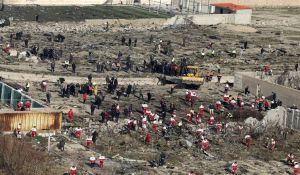
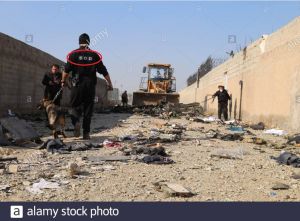
Some families who were at the scene complained about the presence of bulldozers, but the authorities did not pay attention. The aircraft wreckage was moved to an open-air location, visible via Google Maps, in IKA airport near Salam International Terminal and it appears still being kept there.² While in many air accidents, aircraft parts are re-assembled by investigators as part of their inquiry this was never done for PS752.
On the second and third days after the disaster, as can be seen in (Figure 2-3) the crash site was open to the public, and not only ordinary people were walking around, but garbage collectors were also there taking the rest of the airplane parts with them. There were rumors that this happened even on the day of the downing and many pieces were taken by ordinary people.
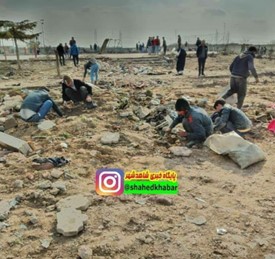
Figure 2-4 shows a health insurance card of one of the victims that was found by strangers at the crash site seven months after the disaster. Travelers' belongings remained in the area for months. Reports indicate that municipal officials went to the area at least three times to set them on fire.
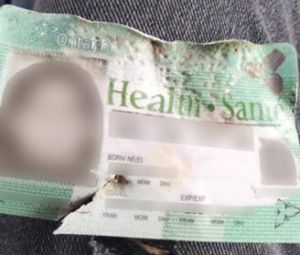
¹ https://www.youtube.com/watch?v=igDAFtwPe-s
² At the time of publishing this report, the PS752 wreckage is still located at 35°25'57.6"N 51°08'03.8"E in IKA airport.
2.2 Delay in Analysis of Black Boxes
Analyzing flight recorders, also known as black boxes, is one of the first steps in an air crash investigation. This includes the Cockpit Voice Recorder (CVR) and the Flight Data Recorder (FDR).
As an example, the black boxes of Pan American Airlines flight 103, which crashed in 1988 due to a bombing, and Flight 302 of Ethiopian Airlines, which crashed due to a technical issue, were found and examined in less than five days [34] ; [35]. In the case of Air India flight 182, which was bombed in 1985, submersibles searched 2000m deep in the Atlantic for 32 days to find the black boxes [36]. Even in the case of Malaysian Airlines flight MH17, which was shot down by separatists in eastern Ukraine, it took only four days for the separatist forces to hand over the black boxes to the investigators [37]. No information is available on the Flight IR655 black boxes that were shot down by the Americans in 1988. Some believe they are still deep in the Persian Gulf, and some think that they were discovered and examined by the United States.
Two days after the downing of Flight PS752, Iran’s state television showed the black boxes and confirmed that they are undamaged [38].
Contrary to the initial promise made to the Ukrainian delegation and the Ukrainian ambassador to Iran, the Islamic Republic of Iran did not hand over the black boxes. Instead, they requested other countries to provide equipment in order to examine the black boxes in Iran [39]. Other countries believed that it was not possible to transfer the required equipment to Iran. In this conflict, the Minister of Foreign Affairs of the Islamic Republic of Iran publicly stated that they do not have the technical capacity to read the black boxes, but they will not hand them over either.[40] In February, Iran's defence minister said that the black boxes had been damaged and that the Ministry of Defence was repairing them, without any transparency on what the repair process can look like [41]. On March 11, Canada's Minister of Transportation requested at the ICAO meeting that the black boxes be delivered, and the Islamic Republic of Iran promised to do so within fourteen days [42].
Fourteen days passed, but Iran did not hand over the black boxes. Neither the ICAO reacted, nor did Canada’s Minister of Transportation. As time went on, the narrative within the Islamic Republic of Iran changed and the delay in handing over the black boxes was claimed to be due to travel restrictions brought about by the COVID-19 pandemic. In an email, Iran requested the transportation safety organizations’ representatives of the affected countries to attend the download of the flight recorders on Europe, and those countries with Covid-19 and travel restrictions did not see it as a possibility [43].
On June 29, Canada's Foreign Minister and the Foreign Minister of Iran had a telephone conversation [44]. As a result, the 20th of July was announced as the date for the delivery of black boxes. Prior to handing over the black boxes, Tehran military prosecutor said that the black boxes were considerably damaged, and by July 20th, more than seven months after the crime, it was still unclear whether the Islamic Republic of Iran had the intention to hand them over.
On July 20, the black boxes were downloaded at the laboratory of France's BEA air accident investigation agency without any problems [45]. Less than a month later, a selective and incomplete report of this readout was published. It was reported that the FDR stopped functioning immediately after the first missile hit and the CVR was broken 19 seconds after.[46] No information was released on the pilot's conversations recorded in CVR before Takeoff. Conversations prior to takeoff are crucial in routine investigations; in PS752 as they may explain reasons for the 57-minutes delay in takeoff or the unusual situations reported by some of the passengers prior to takeoff.
2.3 ICAO and TSB Roles in the PS752 Investigation
The Serious Incident and Accident (SI&A) investigation was developed and adopted by United Nation members in 1944. ICAO published the 1st edition of Annex 13 per Article 26 of the Chicago Convention. The primary purpose of uniform air safety investigation, under Annex 13 by ICAO, is to harmonize the best approach in SI&A investigation and apply lessons learned to prevent similar events and conditions in future. Also, the member states actively adopt the best practices in Annex 13 provisions to improve aviation safety. Investigations conducted in accordance with the provisions of the Annex shall be separate from any judicial or administrative proceedings to apportion blame or liability.
However, the ICAO Annex 13 was not designed to investigate the SI&A caused by unlawful acts committed by governments. Yet in the case of PS752, Annex 13 safety investigations was still granted to Iran without consideration of the unlawful acts committed and regretfully agreed upon by the other affected countries. The latest revision of Annex 13, published in November of 2020, is developing a framework on paragraph 5.11 for cases such as MH 17 and PS752. This provision is in work by the ICAO’s Air Navigation Council (ANC) and Accident Investigation Group (AIG). The subject of section 5.11 has to do with Informing aviation security authorities and states:
- “If, in the course of an investigation it becomes known, or it is suspected, that an act of unlawful interference was involved, the investigator-in-charge shall immediately initiate action to ensure that the aviation security authorities of the State(s) concerned are so informed.”
This has been a unique case where the state of occurrence is Islamic Republic of Iran involved in an “unlawful interference” in the downing of Flight PS752 with its military missiles but is still appointed as the lead investigator. The investigator-in-charge was AAIB which operates under CAO.IRI. As a result, the members of CAO.IRI, with close ties to IRGC who committed the shoot down, handled the investigation of PS752 (more details in Section 3.2).
The roles and responsibilities for stakeholders in SI&A have been defined and evolved in Annex 13 since 1951. Initially, the primary responsibility for investigations were assigned to the aircraft manufacturers. Gradually other factors such as states of design, operation, certification, and occurrence were added to investigations. There is also a definition for those states which suffered the most fatalities or serious injuries to their citizens, which is Canada in the case of PS752. In a similar tragedy of MH17, most victims were Dutch so the State of Occurrence (Ukraine), delegated the investigation to the Netherlands. However, CAO.IRI and AAIB refused to delegate the investigation to Canadian Transport Safety Board (TSB) and TSB also failed to request and insist for such delegation in conducting the investigation as if it had no rights or entitlements by ICAO. According to ICAO, the rights and entitlement for TSB Canada acting as representatives of a State which has a special interest in an accident by "virtue of fatalities" or serious injuries to its citizens include appointing an expert who shall be entitled to [47]:
- a) Visit the scene of the accident
- b) Have access to the relevant factual information which is approved for public release by the State conducting the investigation, and information on the progress of the investigation
- c) Receive a copy of the Final Report.
This will not preclude the state from also assisting in the identification of victims and in meetings with survivors from that state. There is also guidance related to assistance to aircraft accident victims and their families, provided in the Manual on Assistance to Aircraft Accident Victims and their Families. The recommendation for the state which has citizens who fell victim to a civil aviation incident is to monitor the investigation process. The state conducting the investigation should release, at least during the first year of the investigation, established factual information and indicate the progress of the investigation in a timely manner. As it is discussed in Section 5 of this report, factuality of information provided by Islamic Republic of Iran is under serious questions in several areas.
According to Manual of Aircraft Accident and Incident Investigation (Document 9756): “Many States have achieved this objective (independence) by setting up their accident investigation authority as an independent statutory body or by establishing an accident investigation organization that is separate from the civil aviation administration.[48]”
The Islamic Republic of Iran has a bad reputation in aviation safety investigations and lacks transparency due to dependency of its AAIB to the country’s “civil aviation administration” known as CAO.IRI. AAIB, under the CAO.IRI control, did not conduct proper investigation per Annex 13 standards and recommendations and appears to have abused loopholes within Annex 13 by pressure from CAO.IRI, IRGC, and the Islamic Republic of Iran. The evidence of non-compliance in interim reports and the Final Report as well as nonfactual information provided in those reports are discussed in Section 3.2 and 5 of this report respectively.
In addition to ICAO’s failure to dedicate proper rules for such events, the Canadian TSB also failed to investigate properly and diligently. The TSB failed to follow the recommended path in Annex 13 chapter 5, section 3 or try to find legal avenues to better engage since as a matter of fact the state of occurrence, Iran, was involved in "unlawful interference" in shooting down PS752 and special interest of Canada by the virtue of fatalities. The section states:
- ”If the State of Occurrence does not institute and conduct an investigation, and does not delegate the investigation to another State or a regional accident and incident investigation organization, as set out in 5.1 and 5.1.2, the State of Registry or, in the following order, the State of the Operator, the State of Design or the State of Manufacture is entitled to request in writing the State of Occurrence to delegate the conducting of such investigation. If the State of Occurrence gives express consent or does not reply to such a request within 30 days, the State making the request should institute and conduct the investigation with such information as is available”.
Iran’s AAIB not only failed to conduct a proper investigation for PS752, but also violated the Annex 13 provisions, abused the failure of Canadian TSB investigators in conducting a credible investigation, and deliberately misrepresented outside involvement in the PS752 investigation. ICAO and involved countries failed by accepting a heavily flawed "investigation" report drafted by a non-independent and biased entity under a country's "civil aviation administration" called CAO.IRI.
The Association’s fact-finding committee is working closely with the regulatory agencies to remind the authorities on their obligations, concerning PS752, and any event in future. The Association has been actively following and offering the fact-finding assistance for amendments to provisional regulations. However, the mechanism for investigation delegation has not been effective to this date, and the Association continues to push for a proper rulemaking process, to handle future criminal acts, such as PS752.
3. IRAN’S CIVIL AVIATION
3.1 Iran’s Civil Aviation Organization (CAO.IRI)
CAO.IRI, in accordance with international obligations and domestic regulation of the Islamic Republic of Iran, is in charge of monitoring the proper implementation of the laws and regulations and standards of flight in the civil aviation industries of the country. In order to identify the sources of threats on flight safety, based on the International Regulations of the ICAO Annex 13, the AAIB office institutes the investigation of the civil aircraft accidents/incidents under CAO.IRI supervision. The goal is to determine the main cause and contributing factors through impartial and independent investigations and ultimately issue safety recommendations to prevent such accidents or similar events in the future.
In 2010 and as part of ICAO Universal Safety Oversight Audit Programme on civil aviation system of Islamic Republic of Iran, ICAO found that the basic civil aviation legislation in the Islamic Republic of Iran dates back to Civil Aviation Act of 1949 (the Act), which was promulgated by Parliament on 19 July 1949. Based on Article 5 of the Act, the Civil Aviation Organization (CAO) of Iran is “affiliated to the Ministry of Road and Transportation” and headed by a “President who is Vice Minister of Road and Transportation.” “The President of the CAO shall be appointed for a maximum term of three years, after recommendation by the Minister of Road and Transportation and approval by the Cabinet.” The Act also recognized CAO as the agency responsible for conducting investigations. Through the years, countries around the world have improved their domestic legislations towards achieving a fully independent agency for aviation safety investigations. For instance, the United States Congress passed the Independence Safety Board Act for National Transportation Safety Board (NTSB) to become a fully independent agency on April 1, 1975. The CAO of Iran, however, changed to CAO.IRI after the Islamic revolution in 1978 and amended in 1999 with no tangible effort towards the goal of independence.
Aircraft Accident Investigation Board (AAIB) is the authority that is designated by CAO.IRI for investigation. This office within the CAO.IRI which drafted the Final Report for the downing of PS752. The ICAO audit programme found that the current legislation in the Islamic Republic of Iran “does not provide for the independence of the organization in conducting aircraft accident and serious incident investigations [SI&A]” and recommends “the Islamic Republic of Iran should, in its legislation, provide for the independence of the authority designated to conduct aircraft accident and serious incident investigations.” CAO.IRI response to this recommendation was basically confirming that the entity is “supervised” by the Ministry of Transportation as well as Supreme National Security Council. This is obviously not acceptable and is against provisions of ICAO on independence of accident investigation authority. Therefore, ICAO’s response to CAO.IRI explanation was that this “does not address this ICAO finding and recommendation.”
Therefore, the current organizational structure of Iran’s AAIB has demonstrated the lack of impartiality for the fulfillment of SI&A requirements per Annex 13 standards. The dependency of accident investigation by military related entities, has been a common practice in the Islamic Republic of Iran and was even objected by Iranian parliament. Additionally, there has been several civil and military aircraft crashes in Iranian aviation history, after Islamic revolution, with no reliable investigation on the cause and corrective actions to improve safety records. Probably the unique and unusual position of CAO.IRI and AAIB office was in absolute denial. The President of CAO.IRI never recognized the downing of the Ukrainian International Airliner by a military group, responsible for the security of airports and aircrafts in Iran. According to ICAO’s audit there is additional legal provision promulgated by Islamic Republic of Iran in 2008 which states that the President of the CAO.IRI is granted full authority by the Board of Ministers and may delegate such authority to his representatives at the provincial airports.
Shortly before the downing of the Ukrainian airliner PS752, on December 21, 2019, Ali Rostami was replaced by Mohammad Mehdi Karbalaei as the CEO of the IKA Airport City Corp [49]. He was introduced by Mohammad Eslami, Minister of Roads and Urban Development.³ Karbalaei has an extensive background of working in military organizations. The previous roles of Karbalaei in the government include being an adviser to the Minister of Roads and Urban Development, CEO of ETKA organization, CEO of the Maritime Industries Organization, advisor to the Minister of Defence on maritime affairs, and the Deputy Director of Ministry of Defence’s Aerospace Industries Organization.
ETKA organization is a subordinate to Iran's Ministry of Defence. Maritime Industries Organization is a subsidiary of Defence Industries Organization which operates under the Ministry of Defence and Armed Forces Logistics. They produce military and civilian vessels, and supply vessels such as speedboats to the IRGC as well as Iran’s Navy and police forces, have undertaken a project to design and produce an anti-ship cruise missile, and have produced submarines [50].
According to reliable sources, after the downing of PS752 there were many structural changes taking place at Tehran International Airport with IATA code IKA i.e., Imam Khomeini Airport. A group of employees were relocated. They were either getting sent on mandatory unpaid leave, getting fired, or even getting moved to Mehrabad airport. They were replaced by individuals with closer ties to the intelligence services and the IRGC. This can be a warning for the near future.
The representative of Islamic Republic of Iran in the International Civil Aviation Organization (ICAO is Farhad Parvaresh. In a leaked audio file released on April 25 2021, former Iran's Foreign Minister, Mohammad Javad Zarif explicitly explains that after the 2015 nuclear deal, Quds Force Commander Qassem Soleimani, in collaboration with Farhad Parvaresh who was CEO of Iran Air at the time, used civilian flights for military purposes to travel to Syria [51].
The Quds Force of the IRGC is a known terrorist group in Canada. Farhad Parvaresh is based in Montreal, Canada, the headquarters of ICAO. According to Javad Zarif, he participated in the terrorist activities of the Quds Force.
In August 2020, the Iranian government replaced the country’s Civil Aviation Organization (CAO.IRI) chief [52]. The appointment came hours after the Shargh newspaper claimed that CAO’s previous chief, Ali Abedzadeh, had faked his academic credentials [53]. Moreover, Abedzadeh has also been charged with corruption in a case related to purchase of airplanes during his time as head of Aseman Airlines.
In the days following the downing of PS752, Ali Abedzadeh and Hassan Rezaeifar, the head of Iran’s AAIB, vehemently rejected missiles as the cause of the crash. Abedzadeh even claimed that the theory of missile attacks was “scientifically impossible”[54]. Available evidence suggests that Ali Abedzadeh and Rouhani’s administration were aware of the downing of PS752 by IRGC missile within a few hours of its occurrence.
On July 3, 2020, the CBC reported on a 90-minute conversation that Javad Soleimani, who lost his wife Elnaz Nabiyi in the downing of Flight PS752, had with Hassan Rezaeifar, Iran’s lead investigator for the downing of PS752 [16]. More information regarding this conversation is available in Appendix C.
In that conversation, Rezaeifar shares that at 6:35AM five minutes after he heard about the plane crash, he called Amir-Ali Hajizadeh, Commander of the IRGC Aerospace Force, who confirmed the fact that the IRGC had missile activity near Tehran’s International Airport. However, at the time, Hassan Rezaeifar, the head of Iran’s AAIB, and Ali Abedzadeh, the Head of CAO.IRI, both refused to share the truth and claimed that the plane had a technical issue. As an organization directly under Iran’s road and transportation ministry, and their responsibility to report this information to Hassan Rouhani’s Cabinet, the Iranian government must have been aware of the fact that the Ukrainian flight had been shot down by the IRGC within the very first hours.
Additionally, on February 2, 2020, less than a month after the downing of PS752, the Ukrainian media published an audio file from a conversation between Aseman Airlines’ Shiraz-Tehran pilot and the control tower [55]. While in the sky, the pilot and his team noticed the missile activity and contacted the control tower. The control tower is under the supervision of CAO.IRI, which is supervised by Rouhani’s government. Therefore, it is virtually impossible for Rouhani and his government to have been unaware of the fact that PS752 was shot down. Additionally, the IRGC and CAO.IRI work cooperatively, especially considering the indisputable power that the IRGC holds over every governmental structure within the Islamic Republic of Iran, which further supports the claim that CAO and Rouhani’s cabinet were both aware of the truth on January 8, 2020.
In August 2020, Abedzadeh was replaced with Brigadier General Touraj Dehghani Zanganeh. Zanganeh was placed on a blacklist by the US Treasury Department in May 2019 for his involvement in terrorist activities, including sending weapons to Syria and Lebanon.
³ Mohammad Eslami, The Former Minister of Road and Urban Development, is a person with extensive background in military-related organization, the current head of Iran’s Atomic Energy Organization
3.2 Breaches of International Regulations by Iran’s AAIB
The AAIB in Iran is an office within the CAO.IRI. In the Air Accident Investigation Regulations, published by CAO.IRI, dated October 16, 2021, the AAIB is defined as: “A department within the Civil Aviation Organization [CAO.IRI] [emphasis added] to perform investigations into accidents, serious incidents, selected incidents or delegated investigation.“ The AAIB has failed in its own mandates and violated following sections of Annex 13:
● Section 3.2 – CAO.IRI is a subsection of the Ministry of Roads and Transportation, which is part of the executive branch of the government of Iran, under the control of the Leader of the government. Therefore, Iran’s AAIB is not “Independent” from the State aviation authorities and other entities that could interfere with the conduct or objectivity of an investigation.
● Doc 9756 Part 1, 2.1.2 – "Organization and Planning, elaborates the investigation authority must be strictly objective and impartial and must also be perceived to be so". Iran’s AAIB, however, does not meet the impartiality due to its dependency to CAO.IRI as explained earlier. This has also been determined by the country’s parliament in 2021. CAO.IRI was requested by the Parliament to recuse itself from any accident investigations but it has refused to do so. The denial and the pretense of ignorance, for three days after the downing of PS752, brings the Iran’s AAIB and its “objectivity” and “perceived” objectivity into serious question.
● Section 3.3 – In section II, there is footage available that AAIB had no control over the wreckage or protecting the evidence in the crash site. The AAIB also failed to provide a "safe custody against further damage, access by unauthorized persons, pilfering and deterioration". Therefore, it was in clear contravention of this section.
● Section 5.1 – "The State of Occurrence … shall use every means to facilitate the investigation." Delays in reading the FDR and CVR, about six months, with no acceptable explanations, is in contravention of this section. According to the recommendation in this section, the State of occurrence must delegate the whole or any part of the conducting investigation to another State to facilitate the investigation. Instead, Iran’s AAIB hindered and delayed the process.
● Section 5.7 – "Effective use shall be made of flight recorders in the investigation of an accident or incident." "The State of Conduction of the investigation shall arrange for the read-out of the flight recorder without delay." For obvious reasons, this is a self-explanatory contravention of this section of this Act.
After the downing of the Malaysian Airlines Flight MH17 in 2014, the Netherlands was delegated to investigate this incident. In 2018, Document 10084 (Risk Assessment Manual for Civil Aircraft Operations Over or Near Conflict Zones) was created to prevent future accidents in conflict zones caused by surface-to-air missiles.
The document is related to several annexes of the ICAO including:
● Annex 6, Operation of aircraft part 1 – International Commercial Air Transport – Airplanes
● Section 11, Air Traffic Services
● Section 15, Aeronautical Information Services
● Section 17, Security - Safeguarding interferences
● Section 18, Safety Management
The State of Iran and Iran’s AAIB failed to observe several sections of this approved document and all of the above-related Annexes. They confessed that they had full knowledge of possible retaliatory attacks following the initiation of any attack by Iran. The USA had announced that 52 predetermined targets within geographical locations of Iran were identified for retaliation. Nonetheless, Iran planned an attack against the US bases in Iraq. Yet, the State of Iran and its agent AAIB intentionally and knowingly ignored all the rules of Document 10084, resulting in the loss of 177 innocent souls. At the time, the risks to commercial airliners were imminent due to the escalated tension in the region.
A Notice to Airmen (NOTAM) dated January 8, 2020, was issued at 00:10 GMT (2:40 am Tehran time) by the FAA (KICZ A0002/20-security). The USA announced that Iranian airspace is unsafe for commercial flights, and this NOTAM is still valid. EASA’s NOTAM, restricting flights over Iranian airspace below FL 250 (25000 feet) was originally issued on January 16, 2020, and was extended on July 16, 2021. However, questionably, without any acceptable explanation from Iran on the sequence of events that led to the downing of Flight PS752 or any explanation to the international community, this NOTAM was withdrawn on October 30, 2021. There are also other active NOTAMs since the incident issued by regulatory agencies.
The Iranian Commission of Constitutional Principle 90, part of the Iranian Parliament, has a mandate to investigate citizens’ complaints against three branches of governments: executive, judiciary, and legislative. In the case of the February 18th 2018 Aseman accident of ATR 72, Flight 3704 from Mehrabad airport to Yasuj, and loss of 66 souls, the Commission 90 investigated the accident due to the complaints made by the families.
According to The Commission 90 reports [56]:
● Iran’s AAIB did not cooperate with the commission as stipulated in Annex 13 of ICAO.
● Iran’s AAIB did not meet the Annex 13 requirement of independence and impartiality.
● One of the root causes of the negligence in CAO.IRI was the lack of expertise in the organization.
● The most striking finding of the Parliamentary commission investigation was that Iran’s AAIB must recuse itself from any future accident investigation.
Appendix D is the translation of an article from Shargh Newspaper published on June 20, 2020. This article explains the legal and judicial process of aviation crash investigations and demonstrates Iran’s AAIB incompetency and its dependency on the government of Iran.
To conclude, Iran’s AAIB was not eligible to conduct the investigation of the downing of PS752 for various reasons.
Firstly, Iran’s AAIB has shown no respect for many of the rules and regulations of ICAO. Iran’s AAIB is not independent from the government of Iran, which is in direct contrast with ICAO’s regulations. AAIB employees are all employees of CAO.IRI and therefore obligated to follow its orders and have no independence.
Secondly, the lack of expertise in Iran’s AAIB has been one of the most important reasons for loss of many civilian lives over the past 40 years. The investigations of 101 air incidents with commercial aircraft since 1980, including 29 fatal ones causing the loss of 2246 lives, attest to their failure in securing air travel in Iran.
Thirdly, Islamic Republic of Iran’s AAIB and CAO.IRI top officials had an active role in covering up the downing of PS752 by IRGC missiles. Ali Abedzadeh and Hassan Rezaeifar, head of CAO.IRI and AAIB, denied the downing of PS752 with IRGC missiles even while they were fully aware of it.
Lastly, CAO.IRI top officials have been involved in terrorist activities. Iran’s representative at ICAO, Farhad Parvaresh, in full cooperation with IRGC, facilitated sending weapons and military to Syria and Iraq on board civilian airliners. The current head of CAO.IRI, Touraj Dehghani Zanganeh is on the OFAC sanction list by the U.S. due to his involvement in terrorist activities.
3.3 Safety of Iranian Airspace
Regarding the unsafe conditions of Iran’s airspace, a petition was run in May 2020, “Do Not Fly Over Iran Airspace”, and raised more than 53,000 signatures in less than two months [57]. This petition raises the questions about the existence of any guarantee that Iran will not repeat a similar crime, and how the safety of passengers can possibly be ensured in such an environment. This petition suggests that the EU Member States should not agree to fly over Iranian airspace until Iran delegates the investigation to an impartial and independent organization.
There is no guarantee that Iran’s airspace is safe for civilian air traffic. On March 18, 2021, the Transportation Safety Board (TSB) of Canada released a statement about AAIB's Final Report [58]. The statement provides the following evaluation on the safety of Iran’s airspace:
- “AAIB's Final Report only partially explains why the airspace remained open and why operators continued to fly, after Iran had launched missiles into Iraq. It does not explain any of the underlying factors behind why the missiles were launched at PS752. In short, the report says what happened, but doesn’t address why. The report indicates that some unspecified safety actions have since been taken to reduce the risk of this happening again. However, the lack of detail means we can’t confirm that these actions will actually reduce the risks to civil aviation operations within Iran’s airspace [58].”
On June 10, 2021, during a hearing at the Canadian federal Parliament, Ralph Goodale, the Special Advisor of the Prime Minister on PS752, stressed that flying over Iran today is as dangerous as January 8, 2020. There are still several active NOTAMs on the Iranian airspace issued by different regulatory agencies, some as early as January 8, 2020, as indicated in Table
Since there has been no mitigation plan in place by Islamic Republic of Iran about the gaps in security of their airspace, it is advisable for civilian airlines to pay attention to any plan to fly within the Flight Information Regions (FIR) with code OIIX for Iran airspace. Despite the high risk of flying into Iran or flying over Iran below 25,000 FT, European airlines such as Lufthansa and Austrian Airlines have planned or begun their flights into Iran since April 2021 [59]. For the reasons stated before, the Association continues to believe that resuming flights to Iran without obtaining any specific guarantees is an irresponsible decision that places civilian passenger lives in danger.
- Table 3-1. Some NOTAMs on the Iranian airspace [60]
| ROW | Country | NOTAM | Description | Date of Issuance |
|---|---|---|---|---|
| 1 | United States | (NOTAM) KICZ A0002/20 Docket No.: FAA-2020-0874 Amdt. No. 91-359 |
SFC -UNL, United States of America flight prohibition against certain flights in the Tehran flight information region (FIR) (OIIX). | 29 October 2020 |
| 2 | EU | KICZ A0050/20 | The risk to operations is assessed to be HIGH for Flight Levels below 250. | 23 April 2021 |
| 3 | Canada | AIC 16/21 | As of January 10, 2020, and until further notice, Canadian Air Operators and owners of aircraft registered in Canada are advised not to enter the airspace of Iran (Tehran FIR (OIIX)), due to the potential risk from heightened military activity and dedicated anti-aviation weaponry in Iran. | 22 April 2021 |
| 4 | United Kingdom | AIP ENR 1.1 | Potential risk to aviation overflying this area at less than 25,000 FT above ground level (AGL) from dedicated anti-aviation weaponry. | 22 April 2021 |
| 5 | Germany | AIC 10/21 | Civil German air operators are advised to take potential risk into account in their risk assessment and routing decisions within FIR TEHRAN (OIIX) including landing, taxiing, parking, and take off. Potential risk to aviation from anti-aviation weaponry. | 20 May 2021 |
| 6 | France | AIC Circular A 07/21 | From 09/04/2020 and until further notice, pilots in command of aircraft performing air services mentioned in paragraph 1.1 are requested not to penetrate in the part of the TEHRAN FIR (OIIX) located west of the 54th meridian and to ensure that their aircraft maintain at all times a flight level above or equal to FL320 in the part of the TEHRAN FIR (OIIX) located east of the 54th meridian. | 20 May 2021 |
| 7 | India | DGCA Notice | All Indian operators in consultation with DGCA have decided to avoid the affected part of Iranian airspace to ensure safe travel for the passengers. They will reroute flights suitably. | 22 June 2019 |
| 8 | UAE | Safety Decision 2020-01 | Operational Risk in Baghdad Fir (ORBB), Tehran FIR (OIIX), and airspace above the Arabian Gulf and Gulf of Oman. | 08 January 2020 |
| 9 | Sweden | Swedish Transport Agency AIC A2/2020 | - Do not enter the airspace of Iran (including Tehran OIIX FIR) below FL 250 - Do not enter the airspace of Iraq (including Baghdad ORBB FIR) at all flight levels with the exception of airways UL602 (to ALPET), UM860, and UM688 when operating above FL 250. |
30 January 2020 |
4. IRAN’S AIR DEFENCE SYSTEM
4.1 Iran’s Integrated Air Defence Network
Over the past two decades Iran has managed to create a fairly sophisticated Integrated Air Defence System (IADS) consisting of a network of mobile and fixed radar stations, command and control and communications (C3) nodes, and overlapping layers of anti-aircraft guns and surface-to-air missile units spreading across the country both along its borders and in depth. The command and control of this system falls under the responsibility of Khatam al-Anbiya Joint Air Defence Headquarter (KAJADHQ) which presides over and coordinates activities of both the national armed forces (Artesh) Air Defence Force (IRIADF) and IRGC Air Defence Command. The KAJADHQ was formed on May 28, 2019, after the previous Khatam al-Anbiya Air Defence headquarter was divided into the IRIADF as a new branch of Artesh, and KAJADHQ as a separate command and control structure. This section discusses the structure and capabilities of Iran’s air defence system, especially with respect to aspects that are relevant to the shooting down of Flight PS752.
The IRGC is a branch of the Iranian armed forces and was founded on April 22, 1979, following the revolution in Iran. It operates both in parallel (as a security measure) and complementary to the Artesh. While the Artesh is primarily charged with defending Iran’s borders, according to the Iranian constitution, the IRGC’s objective is to protect the Islamic revolutionary ideology and the theocratic political system both inside and outside Iran against domestic and foreign enemies.
As such, Iran's military establishment is an amalgamation of a dual, or even a multitude of, subsystems, comprising a national and a revolutionary arm, each practicing largely different tactics, and operational and organizational methods four decades after the 1979 revolution.
On May 28, 2019, Ali Khamenei issued a decree as the Commander-in-Chief of the Armed Forces, appointing Major General Abdul Rahim Mousavi, a commander of the Army, as the commander of KAJADHQ [61].
Irrespective of requirements for close coordination with other elements of IADS, IRGC dispatched a mobile air defence unit to the Bidkaneh site a few hours before the downing of Flight PS752. This action, falling outside the usual norms and standards of the operation of the air defence network of Iran, raises questions. First, was this unit under the command and control of the integrated air defence system? If so, would the relocation of the mobile defence be allowed? Moreover, was the performance of the system under constant surveillance, or was KAJADHQ completely unaware of the existence and the location of this unit? There is also a possibility that this unit was being directed by the IRGC Aerospace Force, which was separated from the KAJADHQ. Lastly, if this activity was not done with the coordination of KAJADHQ, how would the IRGC or part of the IRGC air defence independently deploy a new anti-missile system near the civilian airport without coordination with the superior unit?
Based on the leaked audio file of a top Iranian official, which is discussed in more detail in Appendix A, the Army controls the mid to high altitude systems while the IRGC controls the low to mid altitude systems, and they work in coordination with one another. This top Iranian official further indicates that it is not clear why the Tor-M1 system was placed outside of the airport by the IRGC that night and why it was not linked to the country’s air defence network.
4.1.1 Iran’s Air Defence System Capabilities
One of the important features of Iran’s air defence system is its close coordination with the civil aviation authorities. Farzad Esmaili, who was the Commander of the KAJADHQ from 2011 to 2018, elaborates on this point during an interview with Iran’s state television where he described how the Israeli spy drone, Hermes, was shot down [62]. According to Esmaili, the Hermes drone, which has a very small Radar Cross Section (RCS), was attempting to approach the Natanz Nuclear Center through passenger air routes but was identified by the country's air defence system and shot down by IRGC missiles. He explains that the IADS is in full coordination with both military forces and CAO.IRI, but in certain circumstances, they are allowed to make decisions on their own.
Amir Ali Hajizadeh, the commander of the Aerospace Force of the IRGC, said in a 2015 interview that officers in ADUs, are permitted to fire at will as needed without seeking permission from the KAJADHQ or the Armed Forces General Staff, and if necessary, shoot down a hostile object. This is reportedly what occurred in the case of the claimed shooting down of the Israeli Hermes [63]. It is possible that the Tor-M1 may have been added to Tehran’s air defence ring by the IRGC independently from the integrated defence network and was only in contact with Top-IRGC commanders who, with a false warning of incoming cruise missiles, permitted the downing of flight PS752.
In another interview, Esmaili also stated that it was the domestic defence system that destroyed the Israeli Hermes aircraft and brought down the American RQ-170 Sentinel before Iran took delivery of Russian S-300 air defence systems [64]. Explaining the capabilities of the country's air defence personnel, Esmaili claimed that because of their highly qualified staff, the training period for the Iranian officers on the S-300 system in Russia has been half of what it is normally for other countries that have purchased the system. He also said that during the Damavand maneuver, they were able to shoot down a surface-to-surface missile using S-300, which could prove capabilities of the air defence personnel.
Describing the performance of the Air Defence Operation Centre (ADOC), Esmaili claims that there are 3,600 defence zones in the country that have the authority to independently make decisions in crises. Each of these defence centers have multiple systems that are under the control of both the IRGC and the Army in a cohesive manner. As he states in another interview, “Stealth fighter jets are under our watch [65]. The hostile flying objects first receive a warning, and if the warning is ignored, a designated defence system focuses on them until they leave the area.” Amir Esmail Zadeh, the Commander of the Bushehr defence Center, which is responsible for protecting the Bushehr Nuclear Plant, confirms this statement in another interview as well ([62] at 3:00 minutes).
The commander of the Khondab air defence district, who is responsible for protecting the Arak Heavy Water Reactor Facility, explained in another interview that the country's defence systems make it impossible for any hostile flying object to penetrate ([62] at 3:00 minutes). He says that if an aircraft deviates from its route and goes to sensitive centers, it will be warned and directed to another route.
On September 1, 2019, Deputy Commander of KAJADHQ, Brigadier General Qader Rahimzadeh explained in an interview that the entire space of the country is now covered by the radars of the defence network [66]. He asserted that with a variety of radars in different frequency bands, there is no point in the country [that is not covered by the defence network radars] for which Iran needs to import equipment to cover.
On October 6, 2020, Amir Ali Hajizadeh, in his speech explaining the advanced nature of Iran's air defence systems, introduced Iran as one of the top ten countries in the field of air defence systems radar [67].
On September 1, 2021, the Commander of Army Air Defence Force Brigadier General Alireza Sabahifard said in an interview: “We discover and identify each flying object with any application. The stealth aircraft has lost its meaning. We have the power to detect and identify flying objects and, if necessary, to engage. We have systems that attack targets above 200 km. The enemy knows that if they get close to our red line, they will face a humiliating defeat [68].”
The claims of the senior air defence officials show that the country’s air defence system has a high capability in identifying hostile targets across the country in the most difficult conditions. The claim that such an air defence network was not able to correctly detect a civilian aircraft over an international airport is an important question for which Iran has not been able to provide a clear and acceptable answer.
4.1.2 Intelligence from an Operator of an ADU
The Association had a long conversation with an ADU operator in the Army after the downing of PS752. To protect the identity of this individual, his name will not be revealed in this report.
According to this conversation, on January 8th everyone was on high alert at the operator’s air defence sector, and their commander announced that it is a "3-C situation" (in Farsi: 3-ث) which is the war situation. He says it means that even the enemy may have entered the country in this situation.
He stated that in this so-called "3-C situation" the sky must have been closed but surprisingly he was seeing passenger flights passing through the safe corridors just like nothing had happened and everything was normal.
This conversation raises questions as to whether or not the Tor-M1, which shot down flight PS752, was coordinated with the integrated air defence headquarters (KAJADHQ) at all. It is still unclear whether IRGC deployed the Tor-M1 ADU in the vicinity of Tehran’s international airport without coordination with the integrated air defence network. This operator also suggested that 105 degrees misalignment of the Tor-M1 system and misidentification of PS752 with a cruise missile is very unlikely, if not impossible. Further details of this conversation are available in Appendix G at the end of the report.
4.1.3 Intelligence from an Employee of Tehran Area Control Center (ACC)
The Association had a long conversation with a former Tehran ACC employee. To protect the identity of this individual, his name will not be revealed in this report. Tehran ACC is also referred to as “Tehran Center” among the aviation industry community in Iran.
According to this conversation, various control centers oversee the country’s airspace. Tehran ACC covers a large portion of Iranian airspace, from the Northwest to the southern region of the country. This control center is responsible for coordinating civilian air traffic from various airports in the country as well as international flights departing from or arriving in Iran. This center has direct radio contact with pilots and gives instructions to them. According to this conversation, civilian flights are being closely monitored on the radar system within the Tehran control center and representatives from Iran’s air defence network have access to the same information.
Prior to an aircraft starting its engines at IKA airport, it must obtain permission from Tehran ACC. This means that the representative from KAJADHQ, whose office is in Tehran ACC and appears to be referenced in AAIB's Final Report as CMOCC, conveys this information to the country’s air defence systems which confirms the receipt of this information. This confirmation is conveyed back to the Tehran ACC and then to the air traffic control tower at IKA, which then gives permission to the aircraft to start its engine.
Tehran ACC has multiple screens displaying incoming and outgoing air traffic in Iranian airspace and the representative of the air defence system has full access to these radar screens and has access to all of the information pertaining to these aircrafts (e.g., inbound, outbound, permission status, whether it is just crossing over Iranian airspace, etc.).
4.2 Chain of Commands
In the IRGC, the chain of commands is not enforced in accordance with the standard methods used by militaries around the world. According to a former commander of the IRGC, whose name is protected, at least three IRGC commanders report directly to Ali Khamenei without reporting to the IRGC Commander-in-Chief. These three individuals are as follows:
● Hossein Taeb, Head of the IRGC Intelligence Organization
● Esmail Qaani, Commander of Quds Force of the IRGC
● Amir Ali Hajizadeh, Commander of Aerospace Force of the IRGC
As this former commander stated, the operator may have been linked to Hajizadeh or higher officials outside the standard chain of command and with only one or two middle elements, without many other military officials being aware of the course of events.
The Islamic Republic of Iran itself has also published the names of the following low-ranking subordinates of the IRGC, who have been charged for their involvement in this crime [69]:
● IRGC officer Mehdi Khosravi, Tor-M1 Commander
● IRGC First Lieutenant Maysam Kheirollahi, First Operator
● IRGC Third Lieutenant Seyed Ahmad Miri, Second Operator
● IRGC First Lieutenant Mohammad Majid Eslam Doost
● IRGC Captain Sajjad Mohammadi
● IRGC Major Hamed Mabhout
● Islamic Republic of Iran Army Major Seyyed Mohammad Javad Ahmadi
● Islamic Republic of Iran Army Colonel Mostafa Farati
● IRGC Brigadier General Ibrahim Safaei Kia
● IRGC General Ali Akbar Seydoun
The highest-ranking defendant is Ali Akbar Seydoun, who worked for the IRGC Aerospace Human Resources at the time, but his current position is unknown. It is impossible to prove the guilt or innocence of these individuals, or even their existence, as these names were introduced by the Islamic Republic of Iran itself. Figure 4-1 shows the command structure of the air defence system in the army of Iran.

Tor-M1 Air Defence Unit
A Tor-M1 comes as a launcher vehicle that can act autonomously, as part of an air defence battery, or as part of a network. The vehicle, with its own radar on a folding mast, usually carries eight missiles and under standard conditions, the crew consists of a commander, a system operator, and a mechanic/driver. This structure is dependent on the type of mobile unit and whether it operates independently or in coordination with another unit. The Tor-M1 is sometimes referred to by its NATO reporting name as a SA-15 “Gauntlet”.
Battery Commander
Under standard conditions, for the defence of a stationary object such as a military base, four mobile launcher units may be positioned in the four corners of the military base and a battery command post with a long-range surveillance radar (if assigned to the battery) operates as the central air defence unit. The battery commander is stationed in this command post unit and communicates and provides orders to the four Tor-M1 units under his command. Other air defence weapons systems are structured similarly.
Sector Operation Control (SOC) or Regional ADOC
The SOC is responsible for battery commanders in a given geographic area and will integrate various air defence weapons such as anti-aircraft guns, short range SAMs and other systems. While Tor-M1s can act autonomously against many targets, a fully integrated air defence structure has many layers. If acting autonomously with no battery commander, the Tor-M1 unit will communicate with SOC directly.
Air Defence & Operations Command (ADOC)
The KAJADHQ implements the highest level of control over the country’s air defence systems. It is commonly known as an IADS Coordination Center.
The available information about the details of Iran’s air defence system structure is scarce, but it can be deduced that the KAJADHQ serves as the National ADOC based 250 meters underground west of Tehran. It plans, coordinates, and controls IRIADF's ten Air Defence Districts (ADD), including the Tehran ADD, as an integrated and "smart" air defence system. On September 4, 2015, Iran announced that its "smart" air defence command and control system, named "Payambar-e Azam" (the great prophet), is now online. The system claims to link all air defence districts, their 5,000 air defence nodes in control of radar stations, SAM batteries, anti-aircraft gun positions, and air defence observer posts together. This creates “a unique capability to detect and track targets and allocate weapon systems to engage them.” It was even claimed to have artificial intelligence capability, enabling it to make autonomous decisions [70].
An ADD consists of about a half dozen or more Air Defence Groups, each operating as a SOC. Battery commanders receive orders from their respective SOC. Every battery consists of several units. The number of firing units, their associated radar, and command units differ based on the type and operational requirements.
In general, the SOCs are usually linked to their respective ADDs, but they can also be controlled directly by the ADOC or be operated independently if datalinks are intercepted by enemy’s electronic jamming, cyberattacks or kinetic measures.
There is almost no reliable information available on the structure of the IRGC Air Defence Command and its sectors, as well as their relation with the IRIADF districts and SOCs. They are only reported to have been “coordinated” if not “integrated” under the KAJADHQ, but certain IRGC air defence units reportedly still operate independently.
In the indictment published by the Tehran Military Court, it has been claimed that the commander of the Bidkaneh Military Base was not linked to the IADS. However, two of the defendants are from IRIADF commanders, suggesting the IRGC air defence unit in question was linked to IADS. Therefore, the role of KAJADHQ in the shooting down of PS752 remains a question that needs to be answered. The KAJADHQ, IRIADF and the national armed forces (Artesh) have all remained painfully silent about the PS752 disaster.
4.3 Tor-M1 Surface to Air Missile Specifications
Although it is not known whether the Tor-M1 firing unit that downed PS752 had received any modifications or upgrades throughout its service life, some of basic and general specifications of this system can be found on open-source data including data from military experts. In this section some of the Tor-M1 system capabilities and specifications will be discussed accordingly and the book “Jetliner Down: Tor-M1 missile system which downed Ukrainian flight PS752”, 2020 written by Mike S. Mihajlovic is extensively discussed [71]
The ADU that brought down Flight PS752 was a sophisticated Russian-made air defence system known as Tor-M1 and developed in the 1970s and 80s to defend high value targets mainly against cruise missiles and precision guided munitions. According to Amir Ali Hajizadeh, the commander of the aerospace force of IRGC, this specific unit was dispatched to the vicinity of Tehran’s IKA airport around midnight of January 7. This section examines the history and technical capabilities of these units to the extent that they relate to the downing of Flight PS752.
4.3.1 Purchase of Tor-M1 Air Defence Units from Russia
The purchase contract for the Tor-M1 system was signed between Iran and Russia in the winter of 2004. In February 2006, the Russians announced that they had sold 29 Tor-M1 mobile missile launchers to Iran for about $750 million [72]. On February 26, 2006, Iran announced that it took delivery of the Tor-M1 air defence system from Russia.
Hossein Salami, Commander-in-Chief of the IRGC, who was at the time the commander of the Aerospace Force of the IRGC, spoke on Iranian state television about the benefits of this system for Iran's air defence. Salami asserted that “the Tor system is capable of targeting very low radar cross sections, high-maneuverability aircraft and cruise missiles, and hits them with high accuracy [73].”
4.3.2 Tor-M1 Target Tracking Radar (TTR)
TTR is an engagement and fire-control radar that is specifically designed for use with air defence weapon systems (Figure 4-2). The radar component of the platform measures the coordinates of the intended target or targets in terms of their azimuth, elevation, height, range, and velocity which is used to determine the target trajectory and to predict its future position. These radars provide continuous position data on a single or multiple targets and enable the associated guided weapons to be directed towards targets.
4.3.3 Tor-M1 Target Acquisition Radar (TAR)
The Tor-M1 system has multiple means to distinguish between a civilian aircraft similar to Boeing 737-800 and other targets such as a cruise missile or a fighter aircraft. The target acquisition radar shown in Figure 4-2 detects targets to determine their trajectory. TAR is used to monitor suspicious targets to determine if they are immediate threats. TAR may track the target and then use the track information to react proportionally by using missiles to attack enemy targets.
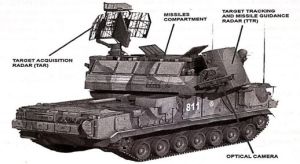
Figure 4-2. General layout of the Tor-M1 units ([71] page 8)
Flight PS752 was climbing toward 2,500-meter altitude at a relatively moderate airspeed of 500 km/h when flight tracking data from its transponder stopped transmitting ADS-B Out signals. PS752 had a normal profile for an airliner gaining speed and altitude after take-off. The TTR of the Tor-M1 should have shown that PS752 was steadily climbing from low to medium altitude, not trying to hide its electronic signature or do any sharp maneuvers which is very common practice for cruise missiles which have a significantly different flight profile from Boeing 737-800 passenger aircraft. Thus, a Boeing 737-800 and a cruise missile exhibit striking and unmistakable differences:
● The passenger aircraft was traveling at approximately half the speed of a cruise missile.
● RCS of the aircraft is several times greater than that of a cruise missile, with the aircraft being several times longer than a cruise missile. In this section, the RCS of a cruise missile and a Boeing 737-400, which is even smaller than PS752, are compared. ⁴
● The heat signature of the aircraft would be seen at two points given the double engines, as opposed to a single heat mark that would be associated with a cruise missile. The Tor-M1 has an optical tracker attached to its target acquisition radar.
● The flight profile of the aircraft was clearly distinguishable from a cruise missile. For instance, the aircraft was ascending, which would not be a typical trajectory for a cruise missile moments before striking its target in the city. While jetliners try to avoid terrain features and fly above them, cruise missiles fly low and use them to hide from radars and air defences.
Given the above differences, it is very unlikely that the sophisticated Tor-M1 system could misidentify a large, slow-moving, and climbing jetliner as a cruise missile. Moreover, since this unit was stationed near the airport, it must have been able to see Flight PS752 on its radars shortly after takeoff. Under these circumstances, it is inconceivable that the operator could mistake the aircraft for a cruise missile only three minutes after takeoff.
RCS Display Comparison between a Passenger Jetliner and a Cruise Missile
RCS is an indicator which differs for various targets in Tor-M1 units. RCS is measured by comparing the strength of reflected signal from the target to that from a perfectly smooth conducting metal sphere with a frontal area of 1 square meter. The RCS of a target is influenced by both radar signal parameters such as operating wavelength as well as target characteristics such as size, orientation and so forth.
Several of the details described below have been taken from the book titled "Electromagnetic Wave Scattering by Aerial and Ground Radar Objects" authored by Ukrainian scientists, and edited by Dr. Oleg I. Sukharevsky from the Kharkiv National Air Force University [74]. In the study of the Ukrainian University, the surface areas of numerous aircrafts were compared to frequencies of 3 and 10 GHz from various angles through computer simulations. In Figure 4-3, the left image shows the RCS of a Boeing 737-400, which is smaller than a Ukrainian Boeing 737-800, and the graph on the right depicts the RCS of an AGM-86 ALCM missile. AGM-86 ALCM missile is similar in size to the Tomahawk cruise missile that would have been expected in a retaliatory attack from the US on January 8, 2020. It is important to notice that the scale of the figure on the left is 10 times larger than the figure on the right.
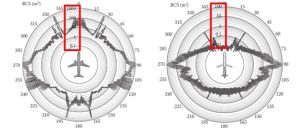
Figure 4-3.noncoherent circular graph of Boeing 737-400 RCS (left) and AGM-86 ALCM missile RCS (right) at 3 GHz frequency [74]
For a better understanding of these two graphs, Figure 4-4 presents the average and median of the RCS in the three positions of front on (Nose on), Side on, and approaching mode from behind (Tail on).

Figure 4-4. Average and mid-range diagram of Boeing 737-400 RCS (left) and AGM-86 ALCM missile RCS (right) in dividing the azimuth into three parts, assuming radar visibility with horizontal polarization at a frequency of 3 GHz (wavelength 10 cm)[74]
As shown in Figure 4-4, there is a significant difference between the values. There is an eight-fold difference between the minimum computed RCS of the Boeing 737-400 (Nose on condition with RCS of 26.81 m2) and the maximum RCS of the missile (Side on condition with RC of 3.4 m2). Radar systems know the direction of movement of an object, so the movement from the front and the movement from the side cannot be confused.
It is important to note that dimensions of a Boeing 737-800 are larger than those of a Boeing 737-400, which can result in a higher RCS. The length of a Boeing 737-800 is 6 meters longer and the wingspan is 7 meters wider than the Boeing 737-400. RCS directly correlates to target size. In other words, the larger the target, the higher its RCS value.
The RCS of a Boeing 737 is 29.39 m2 from the front angle and 154.26 m2 from the side, in response to a 10 GHz radar frequency (Figure 4-5). In comparison, a cruise missile is only calculated to be 0.02 m2 from the front and 2.85 m2 from the side, in response to the same 10 GHz radar frequency.

Figure 4-5. Average and mid-range diagram of Boeing 737-400 RCS (left) and AGM-86 ALCM missile RCS (right) in dividing the azimuth into three parts, assuming radar visibility with horizontal polarization at a frequency of 10 GHz (wavelength 3 cm)[74]
The significant difference in RCS between these two flying targets remains consistent in response to various radar frequencies and in conclusion, it is unlikely for an advanced air defence system to mistake one for the other. Figure 4-6 demonstrates the vast size differences between the Boeing 737-800 and a Tomahawk cruise missile.
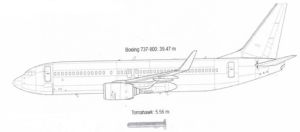
Figure 4-6 . Tomahawk cruise missile is much smaller than a Boeing 737-800. ([71] page 108).
In one screen, the operator of Tor-M1 will see a blip in the form of a line corresponding to the RCS of a flying target. As Figure 4-6 shows, a Tomahawk cruise missile is significantly smaller than Boeing 737-800. Therefore, the blip on the screen for PS752 should have been unmistakably larger than a cruise missile, in the eyes of the Tor-M1 operator.
In another screen, the operator will see the direction, speed, and altitude of targets. Typically, cruise missiles fly in a low altitude, between 30 and 90 meters, and at speeds of more than 750 km/h. This is very different from a Boeing 737-800 which flies in a much higher altitude with a steady climb direction and linear acceleration increase starting at a speed of 250 km/h. Furthermore, the agility of a cruise missile is quite different from that of the Boeing 737-800, which has less agility. The operator of the Tor-M1 unit will need just a glance at that screen in order to see different flight profiles.
⁴ PS752 was a Boeing 737-800.
4.3.4 The Identification Friend or Foe (IFF) System
There is yet another element which could have prevented the downing of PS752. Civilian aircraft transmit special signals that would enable all radars to identify them as passenger planes as opposed to military aircraft. The Tor-M1 units are equipped with this identification system, known as IFF (Identification Friend or Foe). A small antenna just above the Target Acquisition Radar is designated for the target identification role (Figure 4-7).
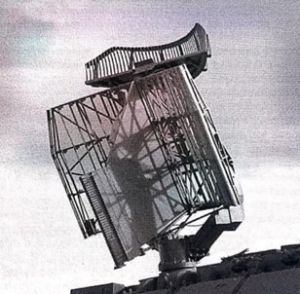
A surface-to-air missile unit typically tries to get a positive identification of a suspicious target before engaging it. Commercial airliners have a transponder that sends out unique information about that a particular aircraft (known as squawk). The missile operator should check for this information, especially if the missile unit is in the proximity of the civilian airports.
If the aircraft is not transmitting a squawk, the missile operator should check the local flight timetable. If there is nothing on the flight schedule, the operator should analyze the flight characteristics of the aircraft which is visible on the radar screen. As explained, the RCS—as well as other parameters such as speed, altitude, and flight profile—of a commercial aircraft is much larger than that of a fighter jet or cruise missile. The operator of a missile system can quickly determine whether the aircraft in question is hostile, friendly, or unknown.
4.3.5 Tor-M1 Missile Launch Capabilities
Despite the disclosure of only a limited amount of technical information on the public domain, there is technical data on several military-related Russian websites, with focus on Tor systems. According to the think tank Air Power Australia website⁵, “The [mobile] Tor-M1 CV [Combat Vehicle] detects and selects air targets on the move and fires missiles at them from short halts [75].” Table 4-1, which is based on this website, shows that even the older 9k330 Tor system, which was the predecessor of Tor-M1 (9K331), would only need 10.7 seconds full stop to launch missiles. This number is reduced to 9.7 seconds for the 9K331 model, as shown in the table below. However, it must be noted, that one of the main differences between (9K331) Tor-M1 and its successor (9K332) Tor-M2 is that Tor-M2 “could acquire and fire to a target while on the move”, but Tor-M1 units “need to stop for two-to-three seconds in order to launch [76].”
Table 4-1. Technical Data Summary/Differences between Tor system models [75].
| System | 9K330 Тоr | 9K331 Тоr-М1 | 9K332 Тоr-М2 |
|---|---|---|---|
| Missile | 9М330 | 9М331 | 9М332 |
| Engagement zone [km] | |||
| - in range | 1.5 − 12 | 1.5 − 12 | 1.5 − |
| - in altitude | 0.01 − 6 | 0.01 − 6 | - |
| Max Velocity of defeat target [m/s] | 700 | 700 | - |
| Reaction time [sec] | |||
| - static | 8.7 | 7.4 | - |
| - short stop while moving [sec] | 10.7 | 9.7 | - |
| Missile velocity [m/s] | 700 − 800 | 700 − 800 | - |
| Missile mass (kg) | 165 | 165 | - |
| Warhead mass (kg) | 14.5 | 14.5 | - |
| Number of missiles on launcher | 8 | 8 | 8 |
| Year of introduction 1986 | 1986 | 1991 | 2009 |
There are variations among different sources as to the exact duration of stop. For example, Table 4-1 above shows a 9.7 seconds stop-time while another reference indicates a “two-to-three seconds stop-time. However, all sources agree that only a "short stop" within a few seconds is required to launch missiles.
Section 5.3.1 of this report (Tor-M1 Capabilities in Finding True North) examines the significance of this particular capability in finding true north which appears to be automatic or at least semi-automatic.
⁵ Air Power Australia is an Australian think tank formed by Dr. Carlo Kopp and Peter Goon with the air of “air power research and analysis”.
4.3.6 Tor-M1 Black Boxes
According to Torki, Tehran’s military prosecutor, voices recorded in the Tor-M1 unit were heard by some judicial authorities [77]. Also, a top military Ukrainian official in “The Secret of Romeo's Death” documentary regarding Flight PS752 confirmed that Iranian Tor-M1s are equipped with black box [33].⁶ Moreover, according to experts the recording device can record some of the engagement parameters and is used for post-action analysis. In conclusion, the Tor-M1 unit that shot down PS752 has a black box that recorded voices and all the communications between the Tor-M1 unit and other individuals in the chain of command.
According to AAIB's Final Report:
“At 06:14:19, the operator announced the specifications of the detected target over the communication network of the relevant Coordination Center. The message was not relayed to the Center. In fact, it had not been recorded in the recorded messages of the Coordination Center.”
Iran's claim must be verified by the black box of the Tor-M1 in order to learn how the operator allegedly attempted to verify and obtain approval for firing on PS752. It is highly questionable that the operator was connected to the air-defence network to receive warnings about cruise missiles prior to shooting down PS752, but it was disconnected to obtain approval for the downing. There must be an independent and impartial investigation of the Tor-M1 black box. Tor-M1's black box(es) have not yet been turned over.
5. FURTHER INVESTIGATION OF THE DOWNING OF FLIGHT PS752
5.1 Decision to Keep Airspace Open
One of the factors that played a major role in the downing of Flight PS752 was that Tehran’s airspace was kept open, allowing the aircraft to take off despite the tensions on that fateful morning. As described previously, these extraordinary tensions arose as a result of a series of missile attacks launched by the IRGC at US military bases in Iraq on January 8, 2020, at around 2 a.m. Iraq time. Speeches and interviews by Iranian officials indicate that on January 8, 2020, despite edging toward a state of war, the Iranian government deliberately kept its airspace open, which ultimately led to the downing of Flight PS752.
The Iranian authorities were well aware of these tensions. An indication of this is the fact that the ADU that shot down Flight PS752 at 6:14AM local time was positioned close to IKA a few hours before Iran launched its missile attack on US military bases in Iraq. Moreover, on January 11, 2020, Amir Ali Hajizadeh, Commander of Aerospace Force of the IRGC, explained during a press conference that the country was in a war situation after attacking the US military bases [78]. Hajizadeh stated that “our requests for the closure of the Iranian airspace were rejected by friends [relevant authorities] due to some considerations”.
Similarly, Hossein Salami, Commander-in-Chief of the IRGC, during his speech at the Iranian parliament on January 12, 2020, noted that the tensions were very high between Iran and the US [79]. He added that the IRGC was expecting the US to attack 52 spots in Iran, as was warned by Donald Trump, the then-President of the US, on January 5, 2020 [80]. On April 23, 2020, Hajizadeh appeared on Iran’s national TV and stated that one of those 52 spots was thought to be the residence of the leader of the government of Iran in Tehran [81]. Further, he asserted that if the US had responded to Iran's attacks on January 8, 2020, Iran had planned to strike 400 of the US targets. On January 24, 2020, the Foreign Minister of Iran, Javad Zarif, explained in his interview with Spiegel, that the decision to keep the airspace open on the night of the attack on the US military bases was both a technical and a political decision [82].
On January 12, 2020, Ali Shamkhani, Secretary of the Supreme National Security Council which is said to be in charge of making decisions over closure of the country’s airspace, claimed in an interview that “it took hours until it was determined from where the incident had happened” [83]. Despite this, domestic and international flights continued to fly within and over Iran's airspace shortly after PS752 was shot down, without any apparent change in flight patterns. Having this information, as well as the fact that Iran's Air Traffic Control was aware of an “unknown” missile launch report [55], is in contrast with AAIB’s claim that “the air defence sector would not allow [aircraft's] engine startup if an air attack was launched. In the absence of an air strike report, the start of flights to low risk areas would be unimpeded once [they are] identified in the defence network [84].” According to this clause of the AAIB's report, it can be concluded that since the military officials were in the belief that missiles are launched towards the country, the airspace should have been closed. However, not only was the sky open before the downing of PS752, but it also remained open even after an actual attack on PS752 was carried out (allegedly for unknown reasons).
These claims by top Iranian officials demonstrate that the Iranian authorities refused to close the country’s airspace while knowing the risks and likelihood of a full-scale war breaking out, and thus ignored the safety and the well-being of civilians in a critical period of military conflict. In comparison, during the Iran-Iraq war (1980-1988) Iranian authorities took active measures to cancel flights over the active conflict zones and even change flight paths to avoid high-risk fly zones. The status of Iranian airspace in the Iran-Iraq war is described in the next section. This demonstrates that the Iranian authorities are aware of the protocols to protect civilian air travel safety but chose to ignore these protocols on January 8, 2020.
According to Article 10 of Iran’s national air traffic regulations, closing the airspace at times of conflict is the duty of CAO.IRI after approval of the government cabinet. On March 5, 2020, Hassan Rezaeifar, Head of Iran’s AAIB, said during a phone call with Javad Soleimani, the husband of one of Flight PS752 victims, that Iran’s Supreme National Security Council was the entity responsible for the decision not to close the airspace on January 8, 2020, after the missile attacks on the US bases in Iraq [16]. This assertion is supported by Canadian Forensic Team’s report, which stated that top-level Iranian officials were involved in making the decision to keep the airspace open. Ultimately, it is now clear that the refusal to suspend commercial flights was an intentional act by top Iranian authorities, which was a major factor in the downing of Flight PS752.
5.1.1 The Status of the Airspace in the Iran-Iraq War
After the downing of Flight PS752 and in a televised interview on state media, Ali Abdollahi Aliabadi, the Deputy Coordinator of Military Joint Chief of Staff responded to the following question: "Why didn't you cancel commercial flights during the war on January 8, 2020?" with "We did not even cancel civilian flights during the war with Iraq [85].”
Closing Iran’s airspace on that day and those hours was the most basic decision that had to be made when military conflict started by the Iranian attacks on US bases. In terms of comparison, it would be more accurate to compare January 8th with the first days of the Iran-Iraq war and not with the whole eight-year period of the war as Abdollahi compares. As stated in the Homa/Iran Air performance booklet, which was used by the airline’s experts from September 22, 1980, to June 22, 1981:
- “Despite numerous Iraqi air raids during the first two months of the Iran-Iraq War, the Iran Air headquarters was never evacuated and continued its operations from underground shelters. However, flight operations were highly affected, and (Iran Air) international and domestic flights did not resume until the 1st and 9th of November 1980, respectively. When resumed, flights were conducted during limited daytime hours only, and under close coordination with the Artesh’s Joint Staff. Maintenance and flight line operations were also restricted to daytime hours.
- Iran Air was directed to forward a list of its flights to the Iranian Air Force forty-eight hours in advance and inform the air force of every schedule change immediately. Flights in and out of Tehran had to be conducted at certain hours and in full coordination with the military authorities.
- Immediately after the start of the hostilities [with Iraq], Iran Air implemented a dispersion plan consisting of 50 flights, evacuating its aircraft to safe airports east of the country (Mashad mostly). So, when flights did resume, aircraft had to fly from their eastern refuge to Tehran to take in passengers and returned to Mashad at the end of their flight.
- In September 1980, Iran Air had 26 operational airliners, of which 23 were airworthy. Between 23 Sep 23 and 23 Oct (Mehr), Iran Air flew only 159 times, but increased the rate to 285 the next month, and 1,041 within six months.”
In an interview, Mr. Amir Kasravi, the former Chairman of the Executive Board of the Association of Pilots and Flight Engineers in Iran, says, “all planes were sent to the eastern airports of the country, including Mashhad and Zahedan, immediately after the war began. For at least a week, all European flights were canceled. Being aware of the difficult and chaotic situation of Iranian travelers at European airports, I suggested we fly from Europe to the Azerbaijan SSR. This way we would fly over the sky of Iran passing through Gilan Province for a short period of time, so the risk to the civilian airplanes would be minimal. Of course, this had to be done by escorting military aircraft, which is what happened."
Newspaper clippings from that time period do not have much information about European flights, but flights to Saudi Arabia for the Hajj were all canceled. For security reasons, even traveling by car and train was restricted (Figure 5-1 to Figure 5-3). Yet on the morning of January 8, 2020, government, military, and aviation officials calmly allowed civilian aircraft to fly in an active time of potential conflict. On three separate occasions [86], all flights including PS752, requested clearance from the air defence system prior to departure. However, flight PS752 was still targeted by a battery unit of Iran’s air defence system.
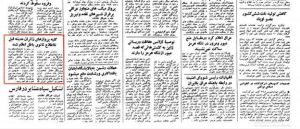
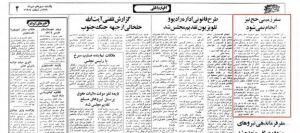
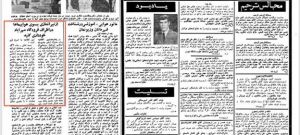
5.1.2 The Status of the Iranian Airspace in the West of Iran
According to the AAIB's Final Report, measures were taken to control the airspace over western Iran after the missile attacks on US bases in Iraq on January 8th ([84] Page 232). This section will explore the available evidence and shed light on the conditions of the air traffic over Iran, illustrating that the airspace in the west of the country and all the country was still open before the downing of Flight PS752. It must be noted that even if the claim were true, closing the airspace only in western Iran would have not been sufficient given the threat of a US strike on 52 spots, including several in Tehran, when the entire country was in a war situation. Furthermore, in fear of retaliation by the US, Iran deployed its mobile ADUs near the sensitive military sites in the vicinity of Tehran, which are also near the two major airports of the country’s capital and under established international air corridors. Iran must have closed its airspace to civilian aircraft in light of this increased military presence. This closure should have been in effect before, during, and especially after the planned ballistic missile strike on the US bases in Iraq.
The Islamic Republic of Iran, in its Final Report, provided a screenshot from FlightRadar24 website (see Figure 5-4) to support the claim of the closure of the airspace over the west of the country. This screenshot was used as an indication that there was no air traffic in the “four parallel routes in the west of the country.” However, this Figure is only a snapshot of the situation, showing the air traffic at 6:15AM Tehran local time following the Iranian ballistic missile strike on the US bases in Iraq. To obtain a more complete picture of the situation in the west of the country, it is necessary to consider the time period between the attacks on the US bases and the downing of Flight PS752.
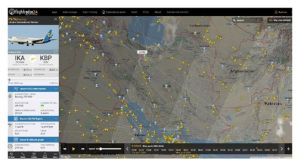
Figure 5-4. The figure shows a snapshot provided in the AAIB’s Final Report showing a closure of the airspace in western Iran ([84] Figure 50, Page 240).
Based on the totality of the evidence available, however, the image shown in Figure 5-4 and the associated statements in Iran’s report are misleading. Upon closer investigation, it appears that Iran did not clear the four parallel corridors over the west of the country as claimed in its Final Report. Moreover, there is no evidence that Iran issued any NOTAM restricting civilian air traffic over the mentioned sectors either before or after the attacks on US bases—including prior to the downing of Flight PS752. The following snapshots from FlightRadar24 website show the flights over the region at various times between the attack on the US bases and the downing of Flight PS752.
Figure 5-5 shows the airspace over the west of Iran about half an hour before the ballistic missile strike on the US bases in Iraq [13].⁷ At this time, the commercial air traffic shows regular activity over the country. Moreover, Figure 5-5 shows that, despite Iran's claimed risk analysis suggesting a "stop on Iran-Iraq traffic exchange" due to high tensions, at least two Iranian passenger airliners crossed the Iran-Iraq border at this time.
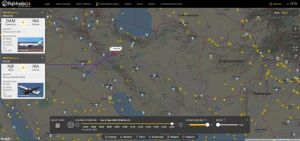
Figure 5-6 shows that the airspace in the west of Iran at the time of attack on the US bases in Iraq was partially, but not fully, cleared. For instance, at the time of the attack, Flight QR8246 from Brussels was on its original route and Flight F2753 was en route to Istanbul.
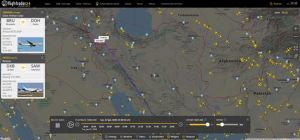
Figure 5-7 shows the airspace approximately one and a half hours after the ballistic missiles were fired at the US bases in Iraq. Despite the heightened risk of military response, the airspace was wide open and there were still a significant number of flights over western Iran at that time.
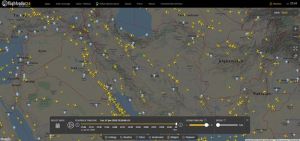
As seen in Figure 5-8 through Figure 5-10, the airspace in the west of Iran remained completely open and in operation for commercial traffic for two to three hours following the ballistic missile attack at the US military bases, or one to two hours before Flight PS752 was shot down.
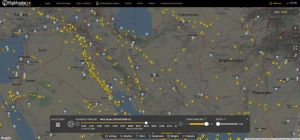
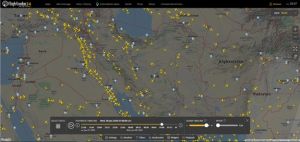
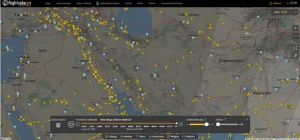
Finally, Figure 5-11 shows the condition of the airspace in the west of Iran about 45 minutes before the downing of Flight PS752. Given the flights over the Iranian territory, the airspace was evidently still open, though with seemingly limited traffic along the four main corridors. This analysis is consistent with the following findings of the Canadian Forensic team:
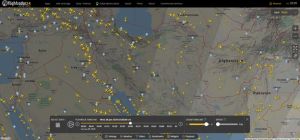
- “The Forensic Team examined air traffic within the four airways close to the Iran-Iraq border the morning of January 8, 2020 (UT430, UM317/L319, UL223, and UT301). This analysis determined that ATC stopped using the four airways beginning at approximately 05:15TT. ATC managed the traffic in these corridors without issuing a NOTAM to notify airlines of the risk, contrary to international guidance ([27] page 35).”
This analysis illustrates that Iran’s claim about closing the airspace in the west of the country after attacking the US bases in Iraq is false and misleading. As discussed previously, the top officials of Iran knowingly risked the safety of civilian flights to/from Iran’s airports as well as international overflights. These circumstances also point to the strong likelihood that Iran used these flights as human shields immediately after missile attacks on the US bases and until after shooting down Flight PS752.
⁷ According to Iran’s state media the time of attack on US bases was at 02:00AM local on January 8 (22:30 UTC- January 7). According to the CBS News’ ‘60 Minutes’ program, the first missile impact was recorded as 01:34AM Iraq local time (02:04AM Iran time = 22:34 UTC). Considering a 4-minute travel time for the missiles, it corresponds with the Iranian sources (time of attack on US bases was 02:00AM local time = 22:30 UTC).
5.1.3 Aviation Traffic Exchange Between Iran and Iraq
The Islamic Republic of Iran has claimed that as a measure of safety, traffic exchange between the Iran and Iraq borders was restricted. It must be clarified, however, that this claimed restrictions together with the claimed restrictions explained in previous section were not imposed until one and a half hours after the downing of PS752.⁸ Refer to Figure 5-5 which shows traffic exchange between Iran-Iraq border. To support this claim, the government of Iran has provided a screenshot⁹ from FlightRadar24 website depicted in Figure 5-12 of this report showing Flight BAW124 had a slight change of course while in Iraqi airspace and claimed “At 04:11[AM] Iraq ACC requested their counterpart in Iran to accept the entry of British Airways flight BAW124 into the Iranian airspace. This was, however, denied due to the restriction imposed on the traffic exchange between the two countries -Iran and Iraq. Such a negative response was in line with the planned preventive measures ([84] page 102)". This claim, however, is not accurate.
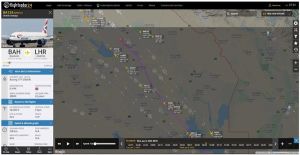
Figure 5-13 shows British Airways' BAW124 flight paths from Bahrain to London within a month prior to January 8, 2020 (in blue) as well as its flight paths after that date (in red). As shown in Figure 5-13, Flight BAW124 has never used Iranian airspace for this flight. Hence Iran’s claim about a request from Iraq ACC for entry into Iranian airspace and subsequent “denial of entry into the Iranian airspace” is questionable as it is not clear why such request should have been made. This figure also shows flight paths of BAW124 (in red) after the January 8th has changed to avoid Iraqi airspace, most likely, due to the existence of tensions in the region and the downing of PS752.
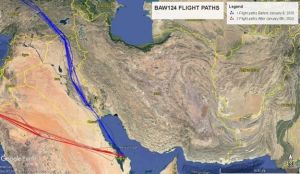
⁸ Figure 51 and 52 in AAIB's Final Report show time of issuance for these restrictions were around 8:00TT
⁹ Figure 53 of AAIB’s Final Report
5.2 The Claim of Misidentification as Cruise Missile
IRGC aerospace commander, Amir Ali Hajizadeh, stated that the country’s “integrated air defence system detected incoming cruise missiles several times and warned all units [emphasis added] to be vigilant ([27] page 29, [87]).” He also mentioned in the same press conference that “these reports were reaffirmed at one or two stages” and continued “this information was given to [all] ADUs including the one [emphasis added] that shot down PS752.” He also said, “the soldier [in charge of the ADU] mistook the aircraft for a cruise missile.”
There is no evidence that these warnings were in fact given to all air defence units as suggested by Hajizadeh. Likewise, it is unclear what happened to the alleged cruise missiles and what was the source of this allegation, as it has now been confirmed that the US military never launched cruise missiles. Additionally, neither the government of Iran nor the IRGC have provided any explanation as to when exactly these alleged false warnings were given to air defence units—or any evidence to show whether any warning was issued at all.
Earlier on January 11, and after three days of denial, the General Staff of the Armed Forces (GSAF) of Islamic Republic of Iran published a statement on the matter. In this statement GSAF confirmed that following the attacks on US bases, the Iranian armed forces were on “high alert to respond to potential threats” due to an “unprecedented increase in air movements”, but it does not provide any comment on why the airspace was kept open in this situation. The statement then adds, “in the hours after the missile operation [on the US bases], the combat flights of the American terrorist forces around the country increased, and some news from the observation of aerial targets to strategic centers in the country reached the defence units and several targets were seen on some radar screens causing more sensitivity in the air defence systems [88].”
GSAF also indicates that “in such a critical situation, Flight PS752 of the Ukraine International Airlines departs from IKA, and when it rotates, it is completely approaching a sensitive military center of the IRGC and is at the height and shape of a hostile target [88].”
Hajizadeh later clarified that what GSAF meant by the “hostile targets” in their statement were cruise missiles [87]; [89]. The statement does not provide any information on who the source of “some news” about the cruise missiles was, how this news “reached the defence units”, or which “radar screens” saw these "targets” and what section in the army they belong to.
There is much inconsistent and inaccurate information in the above statement.
1. The shape of a 5.5-meter-long cruise missile is substantially different from a 40-meter-long Boeing 737-800.
2. In addition, the GSAF stated that the PS752's height, at the time of detection, was similar to a hostile target which means, with Hajizadeh clarification, a cruise missile. This claim is also incorrect. AAIB's Final Report states that “at about 06:14[TT] [02:43:56 UTC], the air defence system operator detected a target ([84] page 75).” According to the flight data recorder (FDR), at this moment, the altitude of Flight PS752 was at 5,655 ft above sea level. Accounting for the IKA elevation of 3232 ft per FDR, it can be concluded that the aircraft was about 2,400 ft (appx. 730 meters) from the existing ground level below. Moreover, the aircraft was quickly ascending at that time, as the altitude of the aircraft was at 7,410 ft from sea level, in less than a minute and at the time of first missile launch at approximately 06:14:40TT per Iran’s claim.¹⁰ This translates to about 4,178 feet (appx. 1,273 meters) from the existing ground level below (see Figure 5-14). This is in sharp contrast with altitudes at which cruise missiles typically fly. According to military experts, cruise missiles typically fly less than 150 meters above ground level. Therefore, despite GSAF’s claim, Flight PS752 altitude was not anywhere close to the altitude of a cruise missile at the time of claimed detection or missile launch—and even minutes before or after that time.

Figure 5-14. Flight Profile at the time of claimed detection and first launch times - Final Report Appendix A – BEA Technical Report ([90] Document BEA2020-0015_tec03 - Appendix A)
3. Despite GSAF’s official statement, Flight PS752 was not changing its course, or “rotating” as mentioned in the statement, towards the military bases at the time of detection. As mentioned above, AAIB's Final Report has claimed that the ADU initially detected PS752 as a “hostile target” at about 06:14TT [02:43:56 UTC in “Factual Report”]. At that moment, the aircraft was moving on its straight path without any deviation (see Figure 5-15, the blue circle), hence not rotating towards the military base. It appears that the AAIB, which drafted the Final Report under supervision of CAO.IRI, intentionally depicted a wrong location (see Figure 5-15, the red circle) to resolve the mismatch with the GSAF’s incorrect statement and show a fabricated turn towards a “sensitive military center of IRGC.”
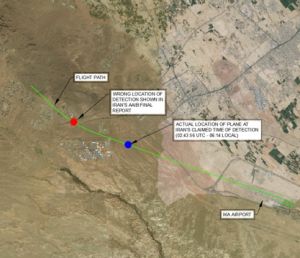
It is worth noting that despite the differences between a cruise missile and Flight PS752—some of which were noted above—on January 12, 2020, General Salami appeared in front of the Iranian parliament and delivered a speech in response to the downing of Flight PS752 [91]. During his remarks, he stated, “Cruise missiles, in terms of speed [and size], are basically a large pilotless plane”, and “when the planes move at low altitudes, [they are similar to] cruise missiles [which] move in low altitudes as well.” He then adds, “when the operator electronically sees in his radar that the target is ascending, he thinks it is a cruise missile.” The statements made by Salami are utterly inaccurate.
Also on January 12, the then-spokesperson for the Iranian Parliament’s National Security Commission, Seyyed Hossein Naghavi Hosseini, found the “human error” scenario “unbelievable”. He explains that “the incident has happened in the IKA’s airspace, and this space is completely on the civilian and military radars.” He questions the possibility of a cruise missile suddenly appearing in the IKA airspace and states that “I highly doubt that a simple human error has caused this tragedy. There must definitely be some behind-the-scenes stories [92].” The next day, when questioned about his statements, Mr. Naghavi Hosseini asserted that his statements were meant to support the IRGC and put the burden on “sabotage and enemy’s infiltration [93].” He is no longer a member of the Iranian parliament.
On January 14, 2020, General Ali Abdollahi, a retired pilot, and the former Deputy Commander of the IRGC’s Aerospace Forces who is now Deputy coordinator of Military joint chiefs of staff of the GSAF, had a televised interview about “the different aspects of the Ukrainian airlines incident”. In his interview, he stated that “cruise missiles normally move in low altitudes. They adjust themselves with [topography of] the ground.” Importantly, he then adds that cruise missiles move in the altitude of “100 to 200 meters, and a maximum of 500 meters to maneuver within mountains and valleys ([94] at 17:50 minutes).” This claim is not supported by any sources, including the military experts who assert that the maximum altitudes of cruise missiles are generally under 150 meters. For instance, an American Tomahawk Cruise missile flies at altitudes of 30 to 90 meters to avoid getting detected [95]. Tomahawk cruise missiles are designed to fly at extremely low altitudes [96].
On January 19, 2020, Khabaronline news agency referenced Mojtaba Zonnour, Chief of the National Security Commission of the Iranian parliament, on information regarding cruise missiles on January 8th. In his comments, Zonnour claimed that “there were reports about incoming cruise missiles, but they were not fact-checked and accounted for as reliable intelligence. Therefore, those reports were not transferred to all air defence units [emphasis added], to specify to which direction or target the cruise missiles were headed, or what system was in charge of defence.” This is, again, in contrast to what Hajizadeh stated about all units being warned. Zonnour continued to add “Also, communication disruption between the operator and the [air defence] unit with fire control network [integrated air defence network] is not proven yet [97].”
Javad Karimi Ghodoosi, who is a member of the National Security Commission of the Iranian parliament and a former military commander with previous connections to the IRGC [98], released a video of himself commenting on “the untold aspects of the downing of the Ukrainian airplane [99]”. In this video, he mentions that “General Hajizadeh, General Salami, and the military experts associated with the Iranian general staff of the armed forces [GASF] insisted that a warning about ballistic and missile cruises was sent to this ADU [emphasis added].” He further explains that the warning may have been electronic warfare and tries to put the burden on the US. He then continues to say, “based on what we heard from the general staff of the armed forces [GSAF], the warning was sent from Khatam-al-Anbiya integrated defence system base and all the voice recordings and documentations are available.” In another video available from him talking about the Flight PS752, he explains “a voice from the national defence system [IADS] exists in which the central defence command center communicates with this [emphasis added] air defence unit to say what is coming towards you is a cruise missile and you only have ten seconds [to shoot] [100].”
Considering these statements, one may conclude that the ADU in question may have been the sole recipient of these so-called warnings, in contrary to Hajizadeh's assertions. What is of utmost importance, and yet still unexplained, is the time at which this warning(s) may have been given to the operator. These warnings, if true, must have been given after Iranian attacks on the US bases in Iraq (after 02:00TT). Iran has claimed that the ADU was moved at 04:54TT by 100 meters for “tactical reasons.” Iran also claimed the ADU stayed there on standby mode until 06:07TT. By these assertions, it can be concluded that the warnings were likely issued after 04:54TT when the ADU was moved, because the ADU allegedly “remained on the standby mode” from this time until 06:07TT.
The Canadian Forensic Team rejects Iran’s claim about the ADU staying on “standby” mode given the “high threat levels” but simply concludes “Iran tracked multiple targets but could not differentiate” between passenger airlines and the threats after the 100-meter movement (analysis of this conclusion is discussed in Section 5.10.6 of this report). One other possibility, however, is that the operator had indeed switched to the "operational mode" at 06:07TT after receiving warnings through communication from his commander shortly before this time. If true, it is consistent with Ghodoosi’s assertions on the order given to the operator to shoot down the incoming cruise missile; the operator switched to operational mode at 06:07TT and executed the order at 06:14TT, as soon as it appeared on his display, relying on his commander’s radar connected to IADS. The Islamic Republic of Iran has not disclosed any evidence on whether the operator indeed acted on his own decision or relied on his commander’s radar and orders from IADS as Ghodoosi pointed out.
Another related issue is the Islamic Republic of Iran’s claim about communication disruption between the operator and his commander. Iran has claimed that at 06:14:19TT, “the operator notified the specifications of the detected target [perceived cruise missile] to the relevant Coordination Center via the communications network. The message was not relayed to the Center.” This implies, considering the 100-meter movement and the time of switching into “operational mode”, the operator had received the communication/warnings about the cruise missiles shortly before 06:07TT (the time operator switched to “operational mode”), but he was, allegedly, not able to communicate with his commander 7 minutes later for unspecified reasons. The issue of communication disruption is further discussed in Section 5.5 of this report.
¹⁰ Iran claims the first missile was launched at 06:14:41TT in the “Factual Report” which later changed to 06:14:39TT in the Final Report. 06:14:40 is used as an average of the two.
5.3 Tor-M1 Misalignment Claim
In Iran’s third report, the “Factual Report”, AAIB of the Islamic Republic of Iran stated that one of the key factors contributing to the claimed “human error” was the misalignment of the ADU that shot down PS752. This report noted the following:
“After the relocation of one of the air defence units [ADUs] of Tehran, clearly causing a change in its heading, a failure occurred due to a human error in following the procedure of system north alignment. As a result, a 107-degree error was induced in the system. As such, while the PS752 aircraft was flying, the direction of objects and targets detected by this system was being observed with an increase of 107 degrees by the operator ([101] B-7 on page 4 and 5).”
AAIB's Final Report reiterated this claim as well, albeit with one variation, as the 107-degree misalignment was changed to 105 degrees. Iran, in the Final Report, has claimed that the crew have failed in “conducting north realignment properly”, which introduced a 105-degree misalignment to the system, and therefore “targeted flight PS752 mistakenly.”
5.3.1 Tor-M1 Capabilities in Finding True North
This section reviews the Tor-M1’s technical capabilities using open-source data to examine whether such an “error” in alignment of the unit is actually possible, as outlined in the AAIB's Final Report. In light of one of the capabilities of these units which is discussed in Section 4.3.5 of this report (Tor-M1 missile launch capabilities), such a gross misalignment is very unlikely.
As explained in Section 4.3.5, a Tor-M1, while on the move, only requires a short-stop of a few seconds to launch a missile and after the launch it can continue to move, detect, and launch if necessary. In fact, Tor-M1 (9K331) needs a maximum of 9.7 seconds full stop to launch a missile. Therefore, finding true north in the Tor-M1 does not require the ADU operator to perform any major manual operations after each movement. In other words, the system is designed to eliminate the need for manual calibration in war situations. It is in fact designed to be agile enough for relocation. In case its location is detected by an enemy, Tor-M1can reorient itself quickly (within seconds) and no one needs to get off the vehicle to perform periscope recalibration under fire. As such, AAIB’s scenario about an error by the operators in manual calibration seems to be implausible, or at a minimum, calibration was only needed when the ADU was first stationed and not after each movement, as Islamic Republic of Iran claims. The following statements presented in AAIB's Final Report makes this claim even more dubious.
“At 04:54[AM], on January 08, 2020, one of the air defence units [ADUs] of Tehran was locally relocated for the last time in order of 100 meters according to tactics of mobile ADUs. This relocation clearly caused a change in the ADU's heading and therefore the ADU suffered an error of 105 degrees due to operators' failure in conducting north realignment properly ([84] page 75).”
As mentioned earlier, the true north calibration for a Tor-M1—as a unit capable of detecting targets on the move and launching missiles with a short stop—is automatic or at least semi-automatic. Iran’s claim seriously contradicts the basic capabilities of a Tor-M1. Therefore, Iran must release more information to prove this questionable claim. Because of the above issues, and since no supporting data has been provided by Iran, the claim of "conducting north alignment" cannot be accepted as it is highly unlikely.
Another important factor to consider is the shared memory of Tor-M1 which shares the coordinates of the target received by the Target Acquisition Radar (TAR) with the Target Tracking and Missile Guidance Radar (TTR) for missile guidance initialization. If the TAR is sharing the false coordinates of a target (due to 107- or 105-degree of misalignment) with the TTR, the target coordination error brings the high possibility of the missile missing the target. This is in contrast with the fact that target (PS752) was shot down and this makes misalignment error claim more questionable.
5.3.2 Tor-M1 Engagement Range and the Decision to Launch Missiles
As mentioned earlier in this report about Tor-M1 specifications, and as indicated in the AAIB's Final Report, the missile engagement range of the ADU is 12 km [27].¹¹
Iran's AAIB has not elaborated in its Final Report on the precise location of the ADU on January 8th. However, the AAIB’s Final Report as well as “Factual Report” show what appears to be the southernmost end of Al-Ghadir base (Figure 5-16), which corresponds with a location estimated by Christiaan Triebert of New York Times [102].¹²
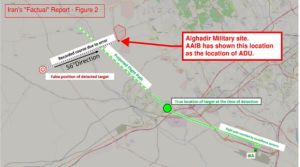
If we take this location as the actual location of ADU on January 8, 2020, based on the known location of PS752 at each point of time and the reported time of the first missile launch at 06:14:39TT (02:44:39 UTC) ([84] page 76) the operator must have launched the first missile when the plane was 13.5 kilometers away from the ADU. This is beyond the specified 12 kilometers range for Tor-M1.
According to Dr. Karlo Copp, a defence analyst and co-founder of the think tank Air Power Australia, who has written dozens of studies on Russian air defence systems and radars:
“Even assuming actual performance [of ADU] is better [than the design], the distance and the geometry of targeting a hostile aircraft on the flight path the airliner was on made launching missiles at that point a “hail Mary shot,” says Kopp, and one that training manuals for Soviet-pedigree systems using the same guidance system discourage taking [103].”
The first missile exploded next to the plane, approximately 18 seconds later, at 06:14:57TT (02:44:57 UTC) when the plane was only 11.2 kilometers away from ADU. In fact, according to experts if PS752 was perceived as a hostile target, the operator should have waited and launched the missile when the plane was well within its 12 kilometers range at the time of impact to ensure it destroys the (hostile) target, but he did not.
¹¹ The Canadian Forensic Team has referred to Tor-M1 as “SA-15 missile system” in page 44 of the report. SA-15 “Gauntlet” is the NATO name for the Tor-M1.
¹² Other possible locations of Tor-M1 unit will be discussed in Section 5.4 of this report.
5.3.3 Analysis of the Misalignment Claim
This section dissects other factors relating to the misalignment and credibility of this claim. Iran’s third report, namely the ”Factual Report”, provides:
“At 02:43:56 [UTC- this time rounded to 02:44 UTC in Final Report], the air defence unit operator detected a target at his 250-degree azimuth, flying on a 52-degree course. At the same time, after takeoff, PS752 had been flying towards the defence system from a 143-degree azimuth. The aircraft was passing a 309-degree course ([101] page 5).”
The above numbers in the “Factual Report” were modified in the Final Report, with no obvious reasoning, so that the 107 degrees changed to 105 degrees, and the 52-degree course changed to 56 degrees ([84] page 75).
The flight path and the plane’s altitude are available via Automatic Dependent Surveillance-Broadcast (ADS-B) technology at each point of time. ADS-B transmits GPS-derived aircraft position information along with several other data fields including aircraft type, speed, flight number, and whether the aircraft is turning, climbing, or descending. This information is broadcast to ATC as well as other aircraft [104].
Iran claims the ADU operator detected a target at 02:43:56 UTC and at that time the plane was “taking a 309-degree course”.¹³ However, this is not accurate. Latitude and longitude from ADS-B Granular data (Figure 5-17) as well as Captain’s Display Heading¹⁴ information from FDR data (Figure 5-18) reveal the true location of the aircraft at that moment. The ADS-B and FDR data also shows that at this point of time, the plane was at approximately 5,450 feet altitude, and its track/true course was at 289 degrees azimuth.¹⁵
The difference between 289 and 309 degrees is too large to be caused by a cross wind factor, considering the IKA Meteorological Aerodrome Reports (METAR) data provided in AAIB's Final Report as well as the FlightRadar24 website (6 knots, good visibility, and a temperature of -1℃) [105].¹⁶ In fact, the weather conditions at that time (between 2:00 and 3:00 UTC) were stable and according to aviation experts, reported wind speeds were not high enough to cause this much of a difference between course and track angles. Thus, this difference is a major contradiction between Iran’s “Factual” as well as Final Reports with the ADS-B and FDR data.
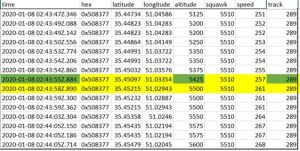
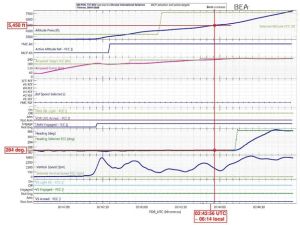
In order to ensure ADS-B data from FlightRadar24 website is reliable, ADS-B data was compared against flight PS752 FDR readout data that was released in AAIB's Final Report as an Appendix. A point of time that was available in both ADS-B and FDR was selected for analysis.
ADS-B data shows True Track degree of 312 at 2:44:56 UTC (6:14:56TT). FDR data, shows Captain’s Display (Magnetic) Heading/Course of “306.86-degrees at the same time (refer to table 6 in AAIB's Final Report). Track data from ADS-B are True degrees (not magnetic) and FDR’s heading/course data, instead, are magnetic. In order to compare these two, data needs to be converted. Knowing that the magnetic declination in Tehran is equal to +4.54 [106], the true degrees can be simply converted to Magnetic degrees. As such, True ADS-B Track Degrees conversion to Captain’s Display Heading Magnetic Degrees is as follows:
Magnetic Track (Capt.’s Display Heading) = True Track – Magnetic Declination
Magnetic Track (Capt.’s Display Heading) = 312 – 4.56 = 307.44 (deg.)
The difference between 306.86 degrees from FDR and 307.44 degrees from ADS-B is only 0.58 degrees.
This minimal difference is most likely due to the slight cross wind impact at the time and/or negligible instrument error. This confirms that the ADS-B data are accurate to a very acceptable level and closely match FDR.
In short:
Track numbers (from ADS-B) – Magnetic Declination (4.56 for IKA) = Capt. Display Heading (FDR)
Trying this for the point of detection, claimed by Iran as (2:43:56 UTC), Track (from ADS-B) is 289 degrees (see Figure 5-17). Similar to above, Capt. Display Heading is (289-4.56=284.44). Taking approximate crosswind impact into account, we would have a number close to 284 degrees. This number is closely matching the FDR Captain’s Display Heading shown in Figure 5-18.¹⁷ Additionally, Appendix 2 of the BEA Technical Document “history of the flight” table can be cross checked to verify the Heading of 284 degrees.
The key point is that at this point of time (02:43:56 UTC or appx. 06:14TT) that is claimed to be the initial time of detection, the plane’s course was not at 309 degrees, as claimed by Iran in both its “Factual” and Final Reports. FDR and ADS-B data confirm this fact but unfortunately none of the countries who reviewed the Final Report commented on this discrepancy. Figure 5 19 and Figure 5 20 provide a visual comparison between what AAIB's Final Report incorrectly shows against reality.
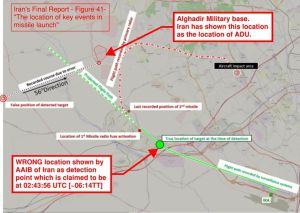
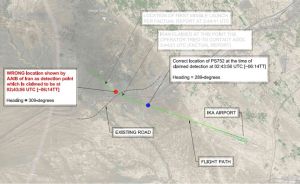
The question arises as to why Iran is showing/indicating a wrong location for the time it claims the plane was first detected? It is the Iranian government's responsibility to clarify these discrepancies. What can be done, with the available information, is to investigate some possibilities based on the described facts and some rational assumptions.
The Islamic Republic of Iran has claimed at the time of detection, the plane was on a 309-degrees course and with a 143-degrees Azimuth from the ADU location. It has also indicated that due to a 105- or 107-degrees error, the ADU operator was seeing the plane on a 56-degrees course (309+107=416 416-360=56) and at his 250-degrees Azimuth. Figure 5 21 shows the “wrong” location of detection per the Final Report in red. The path of the plane is known and fixed, therefore if we are to rely on the 143-degrees Azimuth and the “wrong” location of detection per Iran’s scenario, it means the location of the ADU should be along a line that connects plane’s location at the claimed (wrong) point of detection (in red) to a point that creates the mentioned 143 Azimuth. With this, based on Iran’s scenario, the ADU must have been located somewhere along the mentioned line. This line is shown in Figure 5 21 in blue. Interestingly this line crosses two military bases one of which is the Al-Ghadir site also shown in AAIB's Final Report without mentioning it directly (see Figure 5-19). It appears that all the numbers in AAIB's Final Report add up but are based on a “wrong” location that Iran has shown as location of detection which doesn’t match the claimed time of detection!
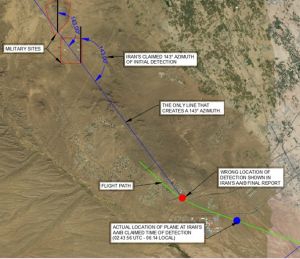
Now, Iran’s claim is being investigated without knowing the exact location of the ADU. As shown in Figure 5-22, the 143- and 250- degrees Azimuths shown in red are from the ADU’s point of view as Iran’s report indicated. The red circles represent true and false “location(s) of target at the time of detection” based on Figure 41 in AAIB's Final Report. As previously mentioned, these locations don’t correspond to the time that Iran has determined as the “time of Detection” at 02:43:56 UTC [06:14TT]. In fact, this time corresponds with the locations shown in blue on Figure 5 22 as the True and False “location(s) of target at the time of detection”. So, as it is shown in Figure 5 22, the 135- and 242- degrees are the numbers corresponding with Iran’s claimed time of detection. Again, this is a factual comment that none of the involved countries appear to have commented on while reviewing Iran’s Draft Final Report.
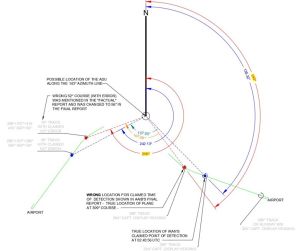
One may ask why Iran has used 143- and 250- Azimuth degrees to show incorrect locations (red) for the time of detection they claimed while they could have shown the correct locations (blue) of the plane at that time and use the associated 135- and 242- Azimuth degrees.
A few possibilities that Iran may have considered are:
1. Baghdad is exactly at 250-degrees azimuth from the location of the ADU (as is indicated above). So, the government of Iran prefers 250-degrees over the 242-degrees to justify its claim of mistaking the PS752 for a cruise missile coming from US bases in Iraq. (See Figure 5-23).
2. As mentioned in the Section 4.3.5) of this report, the need for calibration of the ADU after each movement is refuted, based on the unit's specification. Therefore, it appears that claims about misalignment, initially presented in Iran’s “Factual Report”, are engineered solely to support the "human error" scenario, and to create the above-mentioned 250-degree Azimuth. Changing the misalignment from 107-degrees to 105-degree, is just to mislead the investigation.
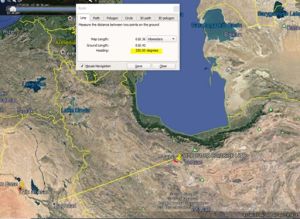
3. The significance of the difference between the correct location of the aircraft when it was allegedly detected at 02:43:56 UTC [~06:14TT] and the incorrect location that Iran shows in its report (difference between blue and red points in Figure 5-22) is related to the heading of the plane in relation to the ADU location. The incorrect location (red circle) suggests that the plane was flying/turning more towards the ADU and therefore justifies the operator’s “mistake”. However, if the Islamic Republic of Iran had shown the correct location (blue circle), it would have resulted in a flight direction away from the ADU (see Figure 5 24). The letter/report of the former UN Special Rapporteur, Dr. Agnes Callamard, has explained this with a slightly different language and it appears to be based on assuming a different location for the ADU (probably not along the blue line in Figure 5 21) which has resulted in a slight rotation. Nonetheless, the results are the same, meaning that the plane was not flying towards the ADU, but away from it, even with the alleged misalignment. In Figure 5-24, the mentioned directions/paths are illustrated as well as Dr. Callamard’s diagram (Figure 5-25) for reference and comparison.
4. The fourth and probably the most important reason for the incorrect locations presented by Iran is that the timing would have not matched up with Iran’s scenario if AAIB had indicated the correct time and location. As shown in Figure 5-19, the time that corresponds with Iran’s claimed ‘location’ of the 309-degrees course, as detection point, is 02:44:39 UTC (and not 02:43:56 UTC). In the “Factual report it also indicates the time of the missile launch was at “02:44:41 UTC” (06:14:41TT) which later got changed to “06:14:39 local time” (02:44:39 UTC) in the Final Report. This would have meant that immediately after detecting the target (PS752), first missile was launched, which obviously would not make any sense with Iran's scenario of the Tor-M1 crew attempting to communicate with command center first. The Iranian AAIB instead appears to have chosen to indicate an earlier time of detection (02:43:56 UTC) so that it aligns with GSAF’s scenario in terms of the operator attempting to contact the command center, communication getting disconnected, and missiles being launched "inevitably and mistakenly".
In other words, it is likely that the operator launched the first missile at 06:14:39TT (per AAIB's Final Report) as soon as PS752 appeared on its radar and without proper verification. Tor-M1 line of sight investigations taking the topography of the region into account, could confirm this theory but it needs the actual location of the Tor-M1 for this investigation.
Shooting down a target as soon as it appears on radar and without verifying its identity, could possibly only be justified if an order was given to the Tor-M1 crew by a commander whom the operators perceived had access to the country's integrated radar system and could rely upon.
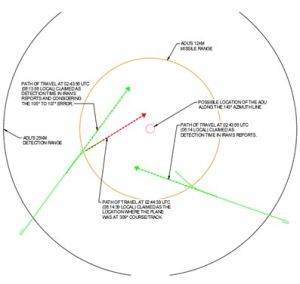
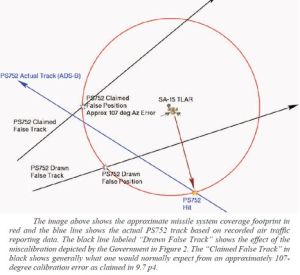
The travel path of PS752 and its altitude based on ADS-B data, which is proven quite accurate, as well as the topography of the region are modeled using Civil 3D v2021 software. Although the detection range of Tor-M1 unit is 25 km per its specifications, due to the hilly terrain in proximity of the ADU location, PS752 couldn’t have been detected in the ADU's radar until it was approximately 13 kilometers away from it. On the other hand, the radar system of the country at the higher-level command and control centers, such as ADOC and SOCs, must have had the plane on their radars as soon as it took off from IKA.
¹³ This time changed to “about 6:14” (local) or 02:44 UTC in the Final Report page 75.
¹⁴ Captain’s (Pilot’s) Display Heading is also known as Captain’s Primary Flight Display (PFD)
¹⁵ FDR graph in Figure 5-18 shows 284-degrees Captain Display Heading (magnetic) which equals to 289-degrees (true). This is discussed further in this report.
¹⁶ Based on meteorological information provided by IKA METAR data, at 02:30, the wind speed was around 6 knots @ 280 degrees Azimuth. This means at that time there could not be a significant difference between true course and track. This matches FDR data that was extracted by BEA and released in AAIB's Final Report as an appendix.
¹⁷ Unfortunately, the FDR Graphs provided in AAIB's Final Report as Appendix are low in quality which makes it quite difficult for investigators to analyze/post-process data with ease. Upon contacting BEA, a high-quality version of the report was provided to the Association which is used in this report.
5.4 Tor-M1 Location
Location of the ADU that launched missiles at PS752 is never officially specified by Iran. Only Hajizadeh, in his press conference, stated that the ADU was stationed "in the vicinity of Bidkaneh”. There are at least three military sites in the vicinity of Bidkaneh and it is not clear in which site (if it was located in a military site) and where exactly the ADU was located on January 8, 2020. The location of the ADU is of utmost importance and crucial to verifying many of the claims made by Iran’s AAIB without any supporting evidence.
After several footage from surveillance CCTVs as well as public were published in the media, multiple investigators and experts made attempts to 'estimate' the location where missiles were fired from. This was done through geolocating the cameras that filmed the scene and considering the time that missile detonation sound traveled to reach the camera as well as velocity of sound. General specifications of missile and the aircraft was also considered for these estimates. Figure 5 26 shows military bases in the vicinity of Bidkaneh and different 'estimates' by investigators.
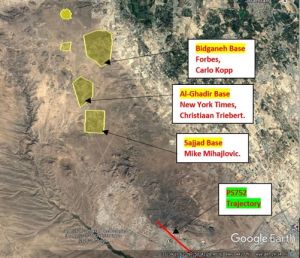
As discussed in Section 5.3.3 of this report, analysis of Iran’s AAIB scenario shows the missile launch could have been any of the Al-Ghadir or Sajjad bases (see Figure 5-21 and Figure 5-26) but since Iran has not provided any credible information about the ADU’s location, it only remains a theory and not a fact. As mentioned in Section 5.3.2, the ADU location that AAIB shows in its Final Report is at Al-Ghadir military base (Figure 5 16). Christiaan Triebert of New York Times had estimated, in a tweet, two days after the downing of PS752 which is shown in Figure 5-26 [102]. In fact, one year later, AAIB showed the same location that Christiaan Triebert had 'estimated' two days after the downing.
On the other hand, Islamic Republic of Iran’s state-sponsored TV channel (Khabar Channel) streamed a 15-minutes show around the anniversary of the downing (December 2020- January 2021) which was surrounding the downing of PS752. In this video some information was given that could translate to the possible location of the ADU.
The reporter in this TV-show claims: “The aircraft was initially detected by Tor-M1 at 06:13[AM] [02:43 UTC] when it was at 4,875 feet altitude and at a distance of 19,548 meters from the [Tor-M1] machine ([108] at 7:44 minutes).”
With the given altitude in the TV-show, the location of the aircraft is known as shown in Figure 5-27 (yellow circle) and 19,548 meters radius from this location crosses the southeast corner of the Sajjad base shown in Figure 5-27. It means, according to the TV-show information, this was the location of the ADU on January 8, 2020. This location matches what Mike Mihajlovic has assumed for the ADU location in his book [71] but is different than what AAIB has shown (Figure 5 16).
It should be noted that the numbers provided in the TV-show appear to be precise numbers as if they are output of a data recorder which implies, they are not approximate numbers. Of course, there is also a chance that these numbers are totally made up to mislead. Nonetheless, they don’t match numbers provided in AAIB’s Final Report which appear to be engineered as discussed in the previous section. In fact, they translate to a different location for the Tor-M1 (Figure 5 27).
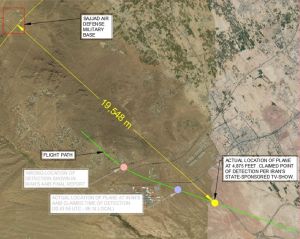
5.5 Tor-M1 Operator and Communication Disruption
The operator who shot down Flight PS752 was one of the 3 or 4 crew members of the ADU on the early morning of January 8, 2020. The government of Iran, after 19 months and by pressure from the families of the victims as well as the international community, released the names of the ADU crew members together with other individuals whose indictment terms are unknown at the time of writing this report. Prior to releasing identities of the operator(s), multiple Iranian officials at Tehran’s military court had claimed the operator has more than 8 years of experience with this type of short-range air defence system (or similar to it) including his service in Syria, where the IRGC has military presence. Later, Gholam Abbas Torki, who was the prosecutor of the case at Tehran's military court at the time, talked about the operator’s experience in an interview with IRNA news agency asserting that he “should have used his experience [109].” The claim of 105-degree misalignment, as discussed in Section 5.3 of this report, and especially the decision to launch the first missile as discussed in Section 5.3.2 is even more questionable considering eight years of expertise and experience.
Furthermore, AAIB's Final Report never explained how or why the operator, who is said to be an instructor of Tor-M1 units as well, could not distinguish between the speed, altitude and RCS of a cruise missile and a passenger airliner.¹⁸
AAIB's Final Report indicated that the operator detected a target at 6:13:56TT, and 23 seconds later announced its specifications to the Coordination/Command Center at 06:14:19TT. Iran claims that, for unknown reasons, the message was not delivered to the Coordination/Command Center. According to Torki the claimed communication disruption "was only a few seconds" and the time between the two missile launches "was 26 seconds"[109]. That means the operator could have tried re-establishing contact with the command center for verification even after launching the first missile when the claimed "few seconds" communication disruption was resolved but he did not. This is despite the fact that the operator would have had enough time to let the “threat” come closer into its engagement range (Section 5.3.2 of this Report) and retry to communicate with his commander during this time. It also appears that he did not try other means of communication when the primary source of communication was allegedly disrupted.
Hajizadeh’s statements provide that the claimed communication outage may be due to jamming or an overloaded communication ([86] at 06:20 minutes). Yet, the government of Iran never provided any proof for this critical claim, and the Canadian Forensic Team also indicated that they “found no evidence that any possible [communication] disruption was caused by jamming.” There is some evidence that shows there have been GPS issues in the vicinity of IKA airport most likely due to jamming activities by the IRGC to possibly avoid precise targeting of its critical points by the US. This has been discussed in Section 5.10.5 of this report.
Iran claims that the ATC issued the clearance for take-off to PS752 at 06:10TT.¹⁹ AAIB’s “Factual Report” explains:
“At approximately 00:30 UTC [04:00TT]., given the change made in the alertness level of Iran's air defence, the military sector informed the civil sector of the country's Airspace Control that only the flights already detected and cleared for flight operations by the defence network could be permitted to start up [emphasis added]. Until then, it was, in fact, the civil sector that had been issuing such flight clearances, taking the operational considerations of Air Traffic Management into account, and providing the flight information to the military sector for Civil-Military Coordination. Making such a procedural change and emphasizing the receiving of the go-ahead from the defence sector prior to initiating the flight [ditto] was implemented with the aim of more ensuring the correct identification of civil flights by the defence network and avoiding targeting them by mistake ([101] page 2).”
Per above claims, ATC, most likely, had received the “go-ahead” shortly before 06:10TT after “providing the flight information to the military sector for Civil-Military coordination”. This brings into question the likelihood of the alleged communication disruption, if true, taken place shortly after the ATC cleared PS752 for take-off, likely with the same means of communication.
Based on the totality of Iran’s reports and Iranian authorities' assertions, as well as what was discussed in previous sections of this report one may conclude that the operator may have not even attempted to initiate contact with his commander, especially since no evidence has been provided to support this claim. On the contrary and based on the assertions from Karimi Ghodoosi (member of parliament), as discussed Section 5.2 of this report, it could have been the command center that communicated with the operator(s) notifying him (them) “what is coming towards you is a cruise missile and you only have ten seconds to shoot”.
¹⁸ At 6:13:56TT (Iran’s claimed time of initial detection) altitude and speed of PS752 was at 5,655 feet and 296 mph respectively.
¹⁹ Iran’s “Factual Report” - Page 4 “At 02:40:20 UTC [06:10:20TT], Ukraine International Flight PS 752 received the takeoff clearance from IKA ATC tower”. This time was deleted in the Final Report without any explanation.
5.6 Tor-M1 Tactical Movement
As noted in AAIB's Final Report, “On January 08, 2020, at 4:54 am, one of the air defence units of Tehran was locally relocated at the last minute in order of 100 meters according to tactics of mobile ADUs.” The ADU in question was initially stationed at its location near Bidkaneh, at the west end of Tehran’s defence ring, in proximity to IKA around midnight on January 8 according to Iran’s report. Elaborating on the status of the defence ring on January 8, Hajizadeh said in a public announcement, “a number of air defence systems were added to the air defence ring in the vicinity of Tehran. The first unit was stationed in the west of Tehran, around Bidkaneh; the same unit that caused this incident ([86] at 03:05 minutes).” According to Hajizadeh, although there were multiple units that were deployed around Tehran, the specific ADU that fired at PS752 was the only one stationed near Bidkaneh. IRNA news agency published a report after the incident that schematically shows the defence ring around Tehran (Figure 5 28). Although the exact locations of the units may not be reliable, it still provides a useful picture of how the units could have been stationed around Tehran.
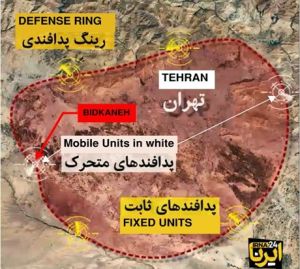
Iran claims that after the 100-meter movement, “the ADU remained on standby mode until 06:07TT and after this time, the ADU was set in operation mode ([84] page 75).” The Canadian Forensic Team’s report provides that the “standby” and “operational” modes “reflect different battle readiness conditions, which typically involve SAM units [ADUs] powering radar systems and target detection capabilities ‘on’ (operational) or ‘off’ (standby).” The government of Iran has not explained why the ADU should have been on standby mode (with its radar off) for more than an hour during a “war situation and at the highest level of battle readiness ([86] at 02:45 minutes).” Also, it should be mentioned that the AAIB's Final Report of Iran never described if the Standby Mode is connected to only the “radar off” condition in the Tor-M1 system or to the whole onboard electronics systems. If such a mode only deals with “radar off” conditions, then Tor-M1’s own Gyroscopes and accelerometers as well as the Non-Volatile Memory (NVM) should still be keeping the system calibrated based on the magnetic north. This is an important question that must be clarified by Islamic Republic of Iran and specifically the IRGC.
Iran implied, in its Final Report, that the ADU was initially aligned correctly when it was stationed around midnight. Iran also implies that after each movement of the ADU it must be recalibrated for true north and that the last 100-meter movement and negligence in recalibration “caused a change in ADU’s heading”, introducing a 105-degree misalignment to the system. According to different military sources including Iran’s own state-sponsored Mashregh news agency [111] ²⁰ , as well as the showcasing of Tor-M1 units in national military parades, all the 29 Tor-M1 units purchased by Iran in 2007 were fully mobile self-propelled vehicles. Therefore, if such a movement in fact happened, it must have been done under the Tor-M1’s own power. Moreover, moving the ADU with another vehicle requires a system shutdown which would not be logical under the “war situation” and with the claimed reports of incoming cruise missiles. Movement of the ADU on its own power would have required that the system was not turned off, and therefore a recalibration would not be needed based on the ADU’s basic specifications and capabilities (Section 4.3.5 of this report). Therefore, if there indeed existed a 105-degree misalignment in the system, it must have been introduced around midnight and not at 04:54 am as Iran claims.²¹ This contradiction is one of the issues that renders the claim of the 105-degree miscalibration highly unlikely.
The command chain for the ADU and its movements would have been performed in coordination with civilian sector to identify civilian flights as AAIB's Final Report states:
“The civil-military operational coordination center (CMOCC) is located in the Tehran ACC. This center communicates all civilian flight information to the military sector, and this information exchange is used to identify civilian flights in the military network ([84] page 85).”
According to AAIB's Final Report, CMOCC clearance was issued around 05:54TT ([84] page 19). Therefore, the ADU operator should have expected flight PS752 passing through his engagement envelope. In turn, the ADU was switched to operational mode (radar on) at 06:07TT, only 3 minutes prior to PS752 receiving take-off clearance from ATC at 06:10TT [101]²² Two minutes later PS752 departed IKA at 06:12TT. The ADU operator launched the first missile 2 minutes after that at 06:14TT.
It is worth noting that according to AAIB's Final Report, PS752 received “startup” and “push back” (pushback is when an airliner is pushed back from its parking spot near airport loading deck) clearance at 05:55TT which occurs when all doors are closed. Considering the fact that there was no ground or air traffic at that time and weather conditions were stable, according to field information from IKA, it normally shouldn’t take more than a maximum of 6-8 minutes to take-off after push-back starts. Per the Final Report, all the coordination with the military sector had taken place and CMOCC had issued clearance at 05:54TT. Islamic Republic of Iran has not provided any reasoning as to why ATC had not given take-off clearance until more than 15 minutes later, at 06:10:20TT. This wait time, however, is likely associated to receiving the final “go-ahead” from Military as discussed in Section 5.5 of this report. Figure 5-29 shows Islamic Republic of Iran’s claim in this regard.
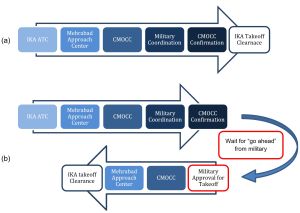
²⁰ “Tor-M1 is a short range, low-altitude, fully mobile air defence system”
²¹ Analysis of the 105-degree misalignment claim has been discussed in Section 5.3.3 of this report.
²² Iran’s “Factual Report” - Page 4 “At 02:40:20 UTC [06:10:20TT], Ukraine International Flight PS752 received the takeoff clearance from IKA ATC tower”. This time was deleted in the Final Report without any explanation.
5.7 Analysis of Flight Recorders
5.7.1 Fuel Quantity Sensors
Based on FDR recorded data in appendix 'A' of Iran’s AAIB Final Report, the fuel quantity recording of Left, Right and Center tanks were stopped about one minute before the FDR failure time (first missile impact) at around 2:44. This issue was not explained in the Final Report nor was it included in the list of comments from any of the countries who reviewed the Final Report’s draft.
Since other fuel parameters such as the Low fuel Warning, Fuel configuration Warning, Imbalance Fuel Warning etc. were recorded until the end of FDR recording (~ 2:45), it can be assumed that the Aeronautical Radio Inc. (ARINC) data bus connecting the Fuel Control Unit (FCU) to FDR was not disconnected since most of the fuel parameters are transmitted on the same ARINC data bus.
Also, a close look at fuel quantity parameters and legends, the following observations/issues may need some clarifications:
● The center tank fuel quantity of center tank (green) was increased from about 4400 Kg to 5000 Kg during take-off and initial climb and back to about 4500 Kg before the fuel quantity recordings were stopped. This may be explained as “fuel slosh” occurrence during high pitch attitude (i.e., Take-off) imposed by gravity although fuel sensors and computers are calibrated for different aircraft attitudes. However, the left and right tanks were not subjected to fuel slosh. A clarification could help better understand such a phenomenon.
● The legend color of the right tank does not completely match with the parameter. Having the source data instead of screenshots from plots could help with better legend colors and more precise value determination on all graphs.
● In the circled area of the graph, as shown in Figure 5-30 the “Fuel Qty Aux Kg [kg]” also is shown which looks to belong to the auxiliary tank. Based on the collected information from various online sources (available AFM, FCOM, AMM etc.), this type of aircraft (Boeing 737-800) is not equipped with an auxiliary fuel tank. The presence of fuel quantity for the auxiliary fuel tank could be better explained.
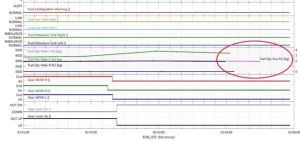
5.7.2 On-Ground Angle of Attack (AoA) Miscompare
The Angle of attack (AoA) is an aviation term for the angle between the aircraft's wing and the wind direction facing the wing. Based on the FDR data graphs in Figure 5-31, there is up to 9 degrees of AoA sensor disagreement on the ground for a considerable amount of time (about 50 seconds) and prior to take off which can have flight deck effect by triggering multiple Crew Alerting System (CAS) messages in the cockpit. Although such a phenomenon is not directly linked to the downing of PS752 by IRGC, it shows the imprecise data reviewed by CAO.IRI. This sensor disagreement could have been brought to Boeing's attention as safety precautions or recommendation even if it matches with Boeing Air Data System requirements. Similar to Fuel Quantity Sensor issues, this item was not included in the list of comments from any of the countries who reviewed the Final Report’s draft.
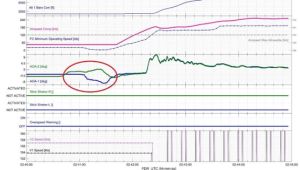
5.7.3 Expected Emergency Landing Pattern
Based on Appendix A of Iran’s AAIB Final Report, the claimed flight path of PS752 after the second missile strike raises an important question that is not answered in AAIB’s Final Report. When an emergency situation occurs during a phase of flight, the crew have to follow certain instructions that are defined in the checklist that is written by the aircraft manufacturer for that specific phase of flight based on the aircraft’s Aircraft Flight Manuals (AFM). Considering that PS752 was in steady climb while being targeted by Tor-M1 missiles and its flight deck effects in the cockpit, the expected maneuver after being hit by the missiles is the steepest possible turn to the airport while following the emergency landing checklist (fuel dump, flap deployment etc.) to choose the closest path to the airport. However, as it was presented in Figure 6 of the AAIB’s Final Report as well as section 3.5 of its Appendix “A”, the aircraft seem to follow an unnecessary longer path which is not aligned with the emergency landing expected path. Figure 5 32 and Figure 5 33 show the path published in AAIB’s Final Report and the one that was expected to be followed in such an emergency situation.
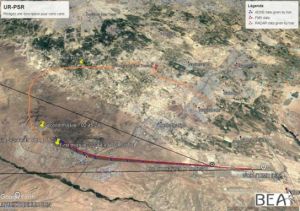
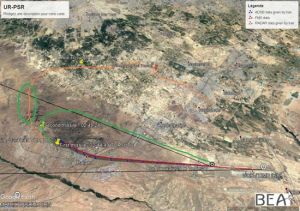
As it can be seen in Figure 5-33, even at some phase of the emergency procedure the aircraft was continuing the straight flight path (circled green) which is not in line with the expected emergency situation. Another question raised by such a figure is the distance between the claimed first “wreckage impact” position (marked by red pin in the figure) with the rest of the track (in orange color) near Nasirshahr city which does not explain the track. Regarding the CVR, also it can be seen that there is no conversation among the crew for emergency landing procedures which adds more questions about AAIB's Final Report. Such a “wide” return to airport could be caused by smoke/significant workload in the cockpit, injured cockpit crew, malfunctions in flight control systems etc.
According to FDR data as well as the flight history table published as Appendix ‘A’ to AAIB's Final Report, the LNAV functionality of Flight Guidance (FG) system was engaged shortly (14 seconds) after aircraft take off rotation (first vertical marker line in Figure 5-34) at 60 feet. However, based on the CVR transcript published as part of AAIB's Final Report, the LNAV engagement and its availability and engagement were announced about two minutes later after flap retraction (see Figure 5-35).
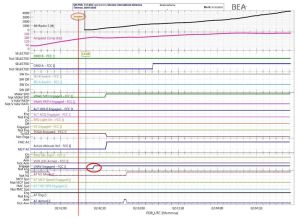
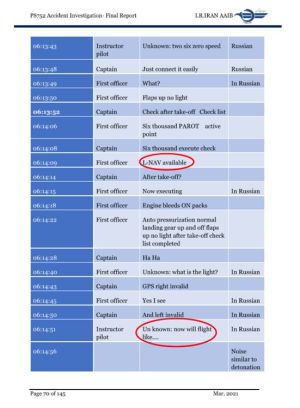
This discrepancy could be due to miscommunication of crew or discrepancy between the “published” CVR by CAO.IRI and the FDR/Flight History. The association of families of PS752 has contacted the BEA directly to get a copy of the full CVR conversation to investigate this discrepancy. However, at the time of preparation of this report, no response was provided by BEA.
Also, it is important to mention that since pilots were relying on the LNAV navigation method during take off and climb-out phases (which is heavily based on GPS sensor), the GPS invalidity likely caused additional workload to the crew and negative impact cockpit situational awareness. This may also have contributed to the emergency “return-to-airport” maneuver that is described in Section 5.7.3. This increase in crew’s workload caused by GPS invalidity and its direct effect on LNAV can be seen from Figure 5-35 that Instructor Pilot expresses by saying: “Now will flight [fly] like…” at 6:14:51TT.
5.8 Screening for American Passport Holders
There are credible reports that the airport staff were screening for anyone holding an American passport from boarding Flight PS752. The Association has independently confirmed that at least three passengers on board PS752 were questioned about having an American passport prior to boarding. This information was relayed to the Association by the victims’ families. The IKA airport has numerous security checkpoints. The last checkpoint that the passengers go through prior to boarding is controlled and staffed by the IRGC, also known as the “IRGC’s gate.” Families have stated that it was at this security checkpoint where their loved ones were questioned about having American passports. Asking this question from passengers living in Canada is not at all routine.
Remarkably, one specific family member reported that their loved one was escorted off the plane by IRGC officers and taken to the IRGC security checkpoint where the passenger was heavily questioned about whether they had an American passport or not.
It is important that the international community places pressure on Iran for access to security footage from the airport on January 8, 2020, in order to corroborate this claim. It is not clear what the intention was regarding this line of questioning. However, what is clear is that there was an active conflict between Iran and the United States on January 8, 2020, and it appears as though the Iranian authorities attempted to ensure that there were no passengers onboard Ukraine International Airlines flight 752 with American citizenship. This raises questions as to the differences between the attitude of Canada and the US. in facing international threats and aggressions.
5.9 57-Minute Delay Before Takeoff
Flight PS752 took off at 06:12TT, 57 minutes behind the original schedule. Iran’s official explanation is that the delay was caused by the removal of four pieces of luggage from the flight. According to aviation experts, however, debarking four pieces of luggage is not a plausible explanation for a 57-minute delay.
Irrespective of whether unloading of luggage was the true reason for the delay, the families of the victims have confirmed that a few passengers or their luggage were taken off the flight. One of the victims of the airliner PS752 indicated to his parents that the airplane’s door is opening, and a few passengers are getting offloaded. Another victim told his grandmother that the delay was due to the offloading of the baggage of passengers that had not boarded the plane. These statements have been reported directly by the victims’ families. Two other victims of the airliner PS752 provided similar information to their families. To protect the identity of their families, we cannot provide more details.
On the other hand, the reason for the delay was noted differently on January 8, 2020 at the airport. According to reliable sources at the IKA airport, before the flight took off, when the aircraft doors were closed and the plane was preparing for pushback, “mechanical issues” were cited as the reason for the delay. To the airport staff, there was no mention of the delay being due to overloading of the aircraft.
The Association has attempted to get access to the passengers list and any potential changes that were made to it up until takeoff. Unfortunately, these efforts have not yet been successful, and the Ukraine International Airlines has not responded to our requests for disclosure of this information. The Canadian government has indicated that they have no access to this information either. SITA, which is an organization based in Amsterdam with access to the flight manifests for commercial flights, has not responded to our inquiries either.²³ A company in Iran, Fanavari Samanehaye Hoshmande Roham, that had contact with SITA, appeared to have had access to these flight manifests as well, but has been closed down since January 8, 2020.
In addition to checking the flight manifest and likely changes to the list of passengers, all CCTV cameras filmed the IRGC’s gate inside the airport and Flight PS752 at the airport parking. This footage can be helpful to understand what the real reason was behind the unexpected 57-minute delay and verify whether any passenger was taken off the flight during this delay.
Possible reasons behind the last 15 minutes of this 57-minute delay which appears to be connected to the military sector has been discussed in Section 5.2 and 5.6 of this report.
²³ A flight manifest is a list of passengers and crew of an aircraft.
5.10 Other Civilian Flights over Tehran
Shortly after the downing different sources started to analyze available data. For example, on January 10th, the New York Times evaluated the pattern of flights in the past three Wednesdays prior to January 8th, 2020 (which was a Wednesday) and concluded departure flights from IKA had the same pattern after the Iranian missile strike on US bases (see Figure 5-3636). “Despite the crash and the attacks, flight activity at Imam Khomeini International Airport that day was startlingly similar to activity in recent weeks, according to data from FlightAware, an industry tracking firm [112].”
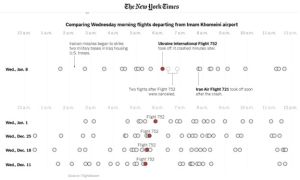
FlightRadar24.com which is a flight tracking website and uses Automatic Dependent Surveillance-Broadcast (ADS-B) data to track flights all around the world released the list of flights that departed IKA on the early morning of January 8th and prior to the flight PS752 (see Figure 5 37) [105]. This website only relies on ADS-B data which is fed by aircraft GPS-receivers broadcasting the aircraft's general flight information such as location, airspeed, altitude, destination, type etc. This means if an aircraft is not equipped with a functional GPS receiver transponder the flight data will not be displayed in the FlightRadar24 website.
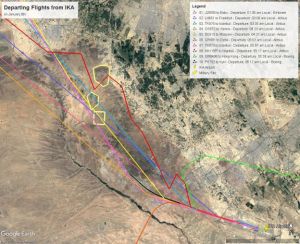
One year later, AAIB of the Islamic Republic of Iran provided a list of departure flights that appears to match with the same list provided by FlightRadar24 website but added a list of canceled flights as well (see Figure 5).
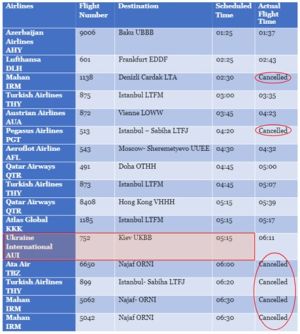
The Canadian Forensics team’s report shows the departure/arrival flights on January 8, 2020, per Figure 5-39 and closely matches the FlightRadar24 departure list. It also shows the first departure flight approximately one hour after the downing of flight PS752 which was an Iran Air flight en route to Frankfurt. Also, “The Forensic Team confirmed that Turkish Airlines Flight 899 to Istanbul, Turkey, and two flights destined for Najaf, Iraq – Mahan Airlines Flights 5042 and 5062 – were scheduled to depart before Flight PS752 but were canceled ([27] page 20)”. This explanation, however, is not accurate. Data from FlightRadar24, as well as other flight tracking websites and sources show these three flights were in fact scheduled to depart after Flight PS752. Instead, two other flights canceled before PS752 were not included in the Canadian Forensic Team’s report. This will be discussed further in this section. All the given times are in Tehran local Time (UTC+03:30).
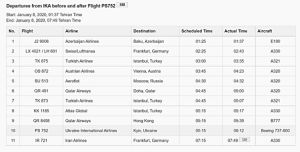
5.10.1 Flight Cancellations
After reviewing records of flights and their historical departure times from FlightRadar24²⁴ , it is concluded that following flights were scheduled for departure before PS752, but were canceled:
● Turkish Pegasus Airlines Flight PC-513, having daily flights from IKA to Istanbul Sabiha airport (SAW), was scheduled to depart IKA at 4:20TT (Tehran Time). This flight was canceled on January 8th due an earlier closure of SAW. In fact, Flight PC-512 (SAW to IKA) never departed SAW airport and as a result PC-513 (IKA to SAW) got canceled.
● Iranian Mahan Airline Flight W5-1138, having regular Saturday and Wednesday flights from IKA to Denizli Cardak airport in Turkey, was scheduled to depart IKA at 2:30TT. This flight was canceled for unknown reasons.
It appears AAIB's Final Report is accurate about the cancellation of above-mentioned flights before the downing of flight PS752, but it partially lacks accuracy for the flights scheduled after the downing of flight PS752. AAIB of the Islamic Republic of Iran has claimed three Iranian flights en route to Najaf, Iraq and one Turkish flight en route to Istanbul, Turkey were canceled after the downing. After reviewing records of the flights and their historical data below findings are presented for the flights shown in AAIB's Final Report as scheduled for departure after PS752:
● Iranian ATA Airlines Flight I3-6650 to Najaf. This flight was indeed on the list of January 8th scheduled flights as shown in Figure 5-40 (left screenshot). A thorough investigation for this flight’s historical data as well as explanations from FlightRadar24 (see Figure 5-40-right screenshot) and phone confirmation with the airlines headquarter in Iran, shows that this flight was not actually scheduled to fly on January 8th at 06:00 but is incorrectly shown on the list of scheduled flights in AAIB's Final Report. In fact, FlightRadar24 data shows this flight stopped operating the route back in November 2019most probably due to an outdated database in FlightRadar24 website. This flight number has two flights in the afternoon and evening to Najaf but definitely not at 6:00AM as was confirmed with the airline sales representatives.
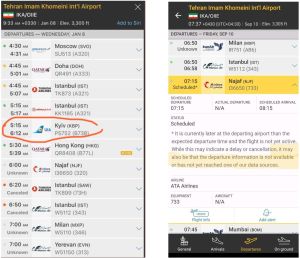
● Turkish Airlines Flight TK-899 having daily flights from IKA to Istanbul Sabiha airport (SAW) was scheduled to depart IKA at 6:20TT. This flight was canceled on January 8th due an earlier closure of SAW. In fact, Flight TK-898 (SAW to IKA) never departed SAW airport and as a result TK-899 (IKA to SAW) got canceled. This is correctly mentioned in AAIB's Final Report.
● Iranian Mahan Airline Flight W5-5042 is shown as being scheduled for 06:30TT departure for Najaf, Iraq in the Final Report. Historical data of this flight route confirms this flight most likely was canceled on January 8th, 2020. Reports from some of the passengers of this flight indicate they were boarded into the plane and then after an hour were asked to leave the aircraft as there will be a delay until 11:00TT after which the flight was canceled. This flight was not shown as a scheduled flight in FlightRadar24 as can be seen in Figure 5 40.
● Iranian Mahan Airline Flight W5-5062 is shown as being scheduled for 06:30TT departure for Najaf, Iraq in the Final Report, however this is incorrect. Historical data for this flight number shows all the flights, except two instances, were scheduled for 12:30TT afternoon. Also, Actual Time of Departures (ATD), which are accurately based on satellites, are after that time. (See Figure 5-41). This flight was not shown as a scheduled flight in FlightRadar24 as can be seen in Figure 5-40.
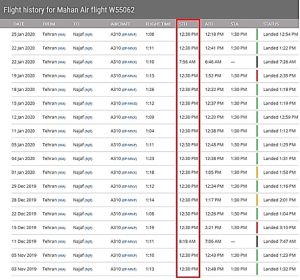
It appears, AAIB of the Islamic Republic of Iran is showing three Flights to Najaf were canceled, most likely, to justify its “preventive measure” claim in risk management for “stopping traffic exchange between Iran and Iraq” after the missile attacks on American military bases in Iraq. However, as is evident, two of them were not actually scheduled for departure at the time claimed by AAIB and one was not canceled until the last minutes and even passengers were initially boarded the plane but then were asked to leave the plane. This shows lack of a timely plan for what is claimed as a “preventive measure” for stopping flights between Iran and Iraq.
It should be mentioned that the two Iranian Mahan Airlines flights, W5-1150 and W5110 en route to Yerevan and Milan, respectively, (shown in Figure 5-40), scheduled flights to depart IKA at 07:00TT are also shown in error due to the same reasons. According to FlightRadar24 website, both of these flights stopped operating in this route back in July and December 2019. Therefore, it can be concluded that similar to ATA airlines flight I3-6650, these flights, most likely, showed up on FlightRadar24 and other flight tracking websites erroneously and most likely due to lack of up-to-date flight schedule data provided to flight tracking websites like FlightRadar24.
In addition to the above-mentioned flights noted in AAIB's Final Report, there is one other flight that was actually canceled shortly after the downing but was not included in AAIB's Final Report:
● Iranian Mahan Airlines Flight W5112 having daily flights from IKA to SAW was, most likely, scheduled to depart IKA on January 8th at 06:50TT but was canceled. This flight still has the same schedule. Cancellation of this flight was likely not due to SAW closure as was the case for TK-899 and PC-513 flight because the SAW airport was back in operation at 05:00 Istanbul local time (05:30TT)²⁵. It is unclear when exactly and why this flight was canceled by Mahan Airlines. It would be a questionable cancellation if the airline canceled the flight before the downing of PS752 at 06:12TT because none of the international airlines (except the ones bound for SAW) canceled their flights in the early morning of January 8th. We encourage passengers of this flight to reach out to our Association and share their information on when they were notified of this flight cancellation. It is worth noting that the aircraft associated with this canceled flight on January 8th was an Airbus-340-300 aircraft. According to the FlightRadar24 historical data, three aircraft with registration numbers EP-MMA, EP-MMC, and EP-MMD were operating this flight. Among these three aircraft, it must have been EP-MMC that was back from Kuala Lumpur (Malaysia) on January 7th and landed at IKA at 04:15 TT. Flight W5112 for 06:50TT got canceled for no obvious reasons and later it departed Tehran for Shenzhen (China) in the evening of January 8th at 20:07TT (Flight W587) as planned on other days.
By investigating and tracking many flights schedules and paths in FlightRadar24 it is evident that in the case of many Iranian flights, there are incomplete, inaccurate, outdated data tables on FlightRadar24 website which appears to be due to lack of data management and/or proper and orderly data transfers by Iranian airlines or other providers to global flight tracking websites such as FlightRadar24. Although this is not an obligation for airlines to share this data with flight tracking websites, it is becoming a common practice in the industry, but it appears Iranian airlines are not following that properly. In many cases travel paths of the Iranian passenger airliners are partially shown on this website²⁶ and in some other cases even with no origin and destination information which makes it difficult to track them and it could have been a source of abuse by Iranian authorities. (Refer to 2018 reports of weapon smuggling with civilian airliners).²⁷
It can be concluded, on the early morning of January 8, 2020, there may have been other departure flights, most likely belonging to Iranian airlines, in addition to the 10 flights recorded on FlightRadar24 website that could have departed IKA or been cancelled. This is consistent with what some informants have reported to the Association about flight cancellations in the early morning of January 8th.
After the downing of PS752 by IRGC missiles, there were a total of 34 recorded flights departed IKA on January 8, 2020, starting with flight IR713 and no major delays or changes in their flight schedules. Iranian airlines owned 28 out of the 34 recorded flights, namely Mahan Airline, Iran Air Tour, Qeshm Airline, and Taban Airlines. No major flight cancellation was observed.
²⁴ FlightRadar24 Business tier account allows access to historical data of the last three years. ²⁵ SAW got closed due to an incident that happened at 09:10AM on January 7th. According to FlightRadar24.com Playback feature, this closure continued until approximately 05:00AM (Istanbul local time) on January 8th when PC7192 from Cologne, Germany landed at SAW meaning that SAW was back into operation at this time and most likely some time before that. ²⁶ This could relate to the old ages of the Iranian airlines’ fleet and outdated or non-existent of transponders on them. ²⁷ In 2018 news agencies reported on the use of civilian airliners for weapon smuggling to Syria, Yemen, and Lebanon. https://www.foxnews.com/world/irans-secret-weapons-smuggling-air-routes-to-lebanon-revealed-by-intel-sources. Iran's former Foreign Minister also explained, in a vastly leaked voice interview, how the military forces abused civilian Iran Air flights for military purposes.
5.10.2 Air Traffic Close to the Time of PS752 Downing
As mentioned before, PS752 was originally scheduled for departure 05:15TT but it was delayed for 57 minutes to become the last international airliner in a row of 10 departure flights starting from 01:36TT flight J2-9006 to Baku (See Figure 5). The Playback feature of FlightRadar24 website was used to track air traffic after 05:15TT and following screenshots show the traffic situation on and after that time until PS572 departed at 06:12TT. Presence of International flights are highlighted for reference together with their direction of flight. At the time of departure, no international flight had a view of the scene or could observe the shoot down as air traffic near IKA was minimal and limited at that time. Yet, several domestic flights like Aseman Airlines flight IRC3768 which witnessed the scene were in flight. Figure 5 42 to Figure 5 47 are the screenshots from FlightRadar24 that show the air traffic status of Tehran FIR between 05:15TT (01:45 UTC) until 06:10TT (02:40 UTC) when the ATC cleared PS752 for takeoff.
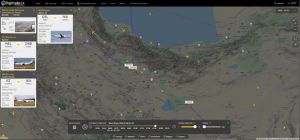
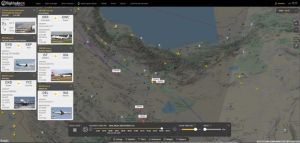
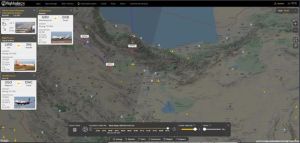
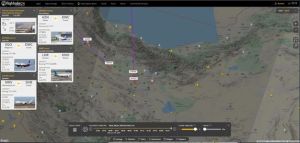
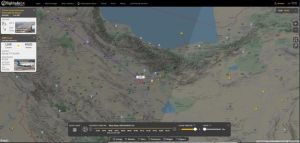
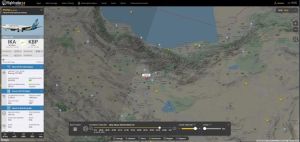
5.10.3 Witness Flights
Aseman Airline Shiraz-Tehran Flight IRC3768 en route Mehrabad Airport witnessed the flight PS752 shoot down by missiles while at approximately 25,000 feet altitude (Figure 5-48) and reported the scene to ATC.²⁸ In February 2020, a Ukrainian Week TV (TSN.Tyzhden [113]) leaked what it referred to as an “intercepted communication” received from “intelligence services [55].” Later, “Hassan Rezaeifar [then head of AAIB at the time of PS752 downing] acknowledged the recording was legitimate and said it was handed over to Ukrainian officials [by Iran] [114]”. He also commented “We will no longer provide any documents to the Ukrainians [115]”. The audio shows Iranian civil aviation authorities knew about the plane shot down by missiles shortly after the downing but for days insisted mechanical issue was the cause, even after Canadian Prime Minister Justin Trudeau and US officials began saying they believed it had been shot down [114]. Additionally, In the audio file and before reporting the shoot down by Aseman airlines pilot to ATC, the controller of ATC asks the pilot, without any previous enquiry, “You have GPS failure?”, the pilot responds “no Sir. ([84] page 30)” The question to be answered by CAO.IRI is if any GPS failures or issues were reported to the ATC (by other airlines or other governmental agencies) prior to the communication with Aseman airlines that made the ATC controller ask such a question.
FlightRadar24 playback feature shows while PS752 was in the air, there were two other flights which could have witnessed the downing of flight PS752 and may have had a similar conversation with ATC. These flights have been pictured in Figure 5-48 and are as follows:
● Mahan Airlines Isfahan-Tehran Flight W54530 was landing at Mehrabad airport, and it was at approximately 4,000 feet altitude and much closer than the Aseman Airlines flight. We encourage witnesses (passengers or crew) to contact the Association to share details of the shoot down as witnessed. ● Karun Airlines Ahvaz-Tehran Flight NV2615 was landing at Mehrabad airport and from approximately 6,200 feet altitude, much closer than the Aseman Airlines flight and at an altitude close to PS752 at the time of the shoot down. We encourage witnesses (Passengers or crew) to contact the Association to share details of the shoot down as witnessed.

²⁸ ATC of the IKA is under Transportation ministry of the government and directly reports to it.
5.10.4 Flight KK1185 (Atlas Global)
The flight KK1185 of Atlas Global took off from IKA at 05:17TT and was two flights prior to PS752. Available data and other clues regarding this flight are described in this section. KK1185 and PS752 were both originally scheduled for departure at 05:15TT. Despite PS752 delay, Atlas global flight took off from IKA on time. Initially, its unrealistic zigzag path of travel, as shown in Figure 5-49 (in red), drew attention from the investigators as well as the public.
Similar to all other flights, historical data for this flight is available on FlightRadar24 website. This data shows that this flight had regular, early morning, daily flights from Tehran to Istanbul from September 2018 until February 2020 when Atlas Global filed for bankruptcy. Since November 2019, its flights from Tehran to Istanbul were scheduled to depart IKA at 05:15TT with no major delays until the airline went out of business in February 2020. Figure 5-49 shows all of KK1185 Tehran-Istanbul flights from November 2019 through January 8, 2020, in blue which were routed through PAROT checkpoint with exception of only three flights shown in other colors: January 8th, 2020, flight shown in red, November 16, 2020, flight shown in Magenta, and December 24, 2019, flight shown in white.
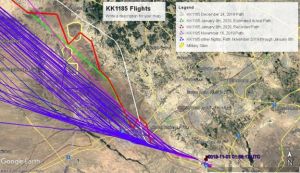
A few weeks after the downing of Flight PS752, head of Iran’s AAIB, Mr. Rezaeifar, had a phone conversation with one of the victims’ families asking him to remove his Instagram posts as he was criticizing the Iranian government [16]. Conversation continued with exchange of text messages, via Instagram, and he was asked about the irregular path of KK1185. Rezaeifar's response was: “This is included in my report and is getting translated, as mentioned, and we will publish it. Everyone thinks Atlas Global was hacked and hence was not routed in a direct path. [However], per both the Turkish [Atlas Global] pilot's report as well as [ATC?] radar, it was due to airport’s inbound traffic and [Atlas Global] was vectored to change route and get enough clearance from incoming flight. This traffic control technique is called vectoring and is the proper course of action for managing traffic." (Figure 5-50)
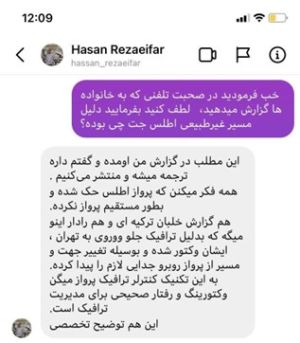
Despite Mr. Rezaeifar’s false assertions about irregular zig zag path being due to vectoring, according to aviation experts, no passenger airliner can make such sharp zigzag moves as shown on FlightRadar24 and other flight tracking websites. In fact, the passenger airliner’s actual path should have been similar to what is shown in green (in Figure 5-51). Additionally, vectoring in aviation is normally due to bad weather, failed Navigational Aid (NAVAID) components or air traffic conflicts. Weather on January 8th was in fair conditions according to METAR data and FlightRadar24 playback feature shows the only incoming flight at the time of KK1185 departure was TK878, being approximately 72 kilometers away from KK1185 (Figure 5-52) at an altitude of 20,000 feet. Had the flight KK1185 routed through the PAROT checkpoint as normal, it would have still kept appropriate Horizontal clearance of approximately 9.6 kilometers from TK878 when they would have passed each other as shown in Figure 5 53 with a vertical clearance of approximately 1,700 feet. Therefore, in the contrary of what Mr. Rezaeifar has declared, vectoring of this flight couldn’t be due to incoming traffic. Vectoring, however, could have happened due to failed navigation as mentioned above and will be discussed in the next section.
It is worth mentioning, according to FAA regulations, which may slightly differ with other jurisdictions, horizontal separation between 3 to 5NM (approximately. 5.5 to 9 kilometers) [116] is recommended and per ICAO, “vertical separation minimum between IFR traffic shall be a nominal 1000 ft below an altitude of 29000 feet” [117].
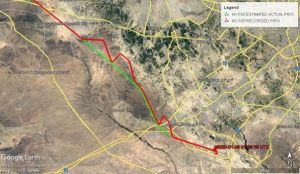
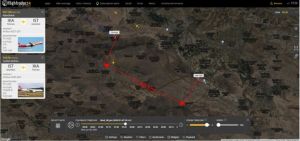
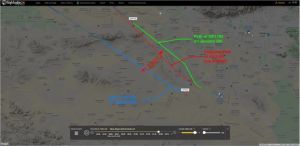
5.10.5 GPS Jamming
According to the CVR transcript that was partially released in AAIB's Final Report, flight PS752 Captain notices GPS failures on both sides approximately 15 seconds prior to the recorded detonation sound at 06:15:56TT (see Figure 5). Based on the times provided by AAIB, approximately 1.5 minutes later, radar communicates with Aseman Airline flight IR3768 Captain and without any inquiry from the captain asks: “You have GPS Failure[too]?” (See Figure 5-55).
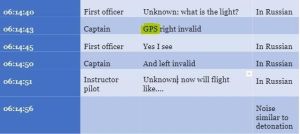
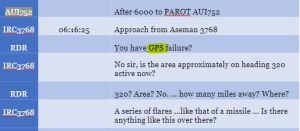
The above-mentioned Conversations about GPS would indicate there has been GPS issues in the area that was felt not only by PS752 crew but most likely by other flying aircraft. Otherwise, why would radar ask Aseman Airlines about GPS failures without any enquiry from Aseman Captain unless there has been reports of GPS failure by other aircraft and likely by PS752. It appears CVR transcript released by AAIB's Final Report is incomplete and could have valuable information on what crew members experienced.
The GPS failures were most likely due to jamming activities in the region. It is worth noting that GPS was originally developed by the US military to determine “precise” locations in the battlefield and GPS jamming is an activity to neutralize that effort [118]. Therefore, it was most likely performed by IRGC to avoid precise targeting of critical Iranian assets by the US. In these conditions flights were still permitted to depart IKA airport.
In addition to the primary evidence mentioned above, while tracking Flight TK873 on January 8, 2020, in FlightRadar24 playback feature, it is observed the plane disappears approximately near where PS752 track disappeared and then a couple of seconds later reappears in FlightRadar24. Although this could be due to a glitch on FlightRadar24 website, it could also be an additional sign of GPS issues.
As briefly discussed in the previous section, in addition to weather conditions and traffic reasons which do not appear to have been the case at the time of KK1185 departure, other reasons may cause vectoring. It is possible that Flight TK873 informed ATC of GPS issues and therefore ATC has vectored the next flight which was KK1185 of Atlas Global. With this consideration, the question of ATC from Aseman Airline flight IR3768 regarding “GPS failure” makes some sense.
This can be due to GPS jamming at the time this flight was departing IKA. Similarly, but on a larger scale, the zigzag flight path of KK1185 could also be due to GPS issues, likely caused by GPS jamming activities at the time. Existence of GPS issues is consistent with the ATC and Aseman airlines flight IRC3768 conversation about GPS failure that was mentioned earlier. It is also consistent with the fact that, PS752 crew faced GPS failure issues in the final moments prior to the first missile impact according to CVR conversation that was released with AAIB's Final Report. It should be noted that the GPS interruptions don't seem to have any direct impact on the downing of PS752 but could have potentially and indirectly influenced the cockpit situational awareness and responsiveness of the crew and their workload in handling the situation which could have put the flight safety in serious danger especially since, according to FDR, the PS752 crew were relying on GPS for Lateral Navigation (LNAV) as discussed in Section 5.7.4.
Considering the totality of above-mentioned analysis and especially based on the conversation between ATC, PS752 and IR3768 it is quite possible that Islamic Republic of Iran was performing GPS Jamming activities, likely, in consideration of possible US retaliation using GPS-aided missiles. Having airspace open in this situation and performing GPS jamming activities near an international airport where it will considerably increase flight crew’s workload, as the flight crew were relying on GPS for take-off, is seriously concerning.
Also, the fact of GPS invalidity in PS752, most likely due to GPS jamming, is in contradiction with AAIB’s Final Report claim on the healthy conditions of the aircraft at the time of missile impact. Also, the Ukrainian investigation team had raised the same question about GPS invalidity issue which was not replied appropriately by CAO.IRI and AAIB.
5.10.6 Analysis of 4 Flights Departed prior to PS752
Based on the report given by the AAIB, after the last relocation of the ADU at 4:58TT, due to a human error, a 105 degrees misalignment occurred in heading calibration of the radar system in finding true north. According to the Canadian Forensic Team’s report, the four flights which departed immediately after IRGC allegedly relocated the Tor-M1 unit, were potentially at risk of being misidentified. In this report it is further stated that “This [risk of misidentification] should gravely concern every country whose airlines and citizens travelled through IKA that morning. Because of Iran’s actions – and failure to act – any of those other flights could have met the same fate as Flight PS752”. Considering this piece of information given by the Forensic Team’s report, the possibility of a misalignment/misidentification is scrutinized. Figure 5 56 through Figure 5 61 illustrate the flight path of these four airliners. In these Figures, the position where the first missile hits Flight PS752, and the geolocated position of the second missile impact, are shown with a large hollow circle close to the 12 km range of Tor-M1, and a star sign respectively.
Had misalignment occurred, per Islamic Republic of Iran's unproven scenario, the operator would have mistakenly seen the IKA in the southwest direction on his radar screen. The first flight that leaves IKA after the repositioning of the ADU at 4:58TT, is Flight QR491 of Qatar Airways, at 5:00TT. According to the information provided by the Canadian Forensic Team, this flight has been detected by the radar and “could have met the same fate as Flight PS752”. If the ADU could observe QR491 as soon as it entered the 25 km detection range of Tor-M1 (depending on topography of the area), the operator, knowing that IKA should be on the southeast direction, observes an object that appears on his radar screen from southwest, makes a turn, and then disappears going out of the detection range of the radar. This is shown in Figure 5 56. It is important to highlight that the operator is aware of his location relative to IKA, whether by knowing the area or by observing the flights that had left IKA earlier on that morning (before the alleged misalignment occurred). Therefore, the entrance and exit of an object from the radar screen from a location in southwest direction, where supposedly no airport is located, should have warned the operator, specifically during high tensions when the defence unit is on high alert. It is worthwhile adding that according to the “Factual Report” released by the AAIB, “given the change made in the alertness level of Iran's air defence, the military sector informed the civil sector of the country's Airspace Control that “only the flights already detected and cleared for flight operations by the defence network could be permitted to start up ([101] page 2)”. Hence, the operator has seen the unexpected appearance and disappearance of an object on his screen a few minutes after the permission is given for take-off. Yet, this flight does not get to the nominal 12 km range of the Tor-M1 unit and could not have been shot down.
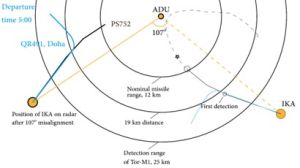
Only a few minutes after QR491, the operator is supposedly informed about another flight which will take off. This is the TK873 of Turkish Airlines, heading Istanbul shown with a red line in Figure 5-57. Again, even if the operator was not informed about this outgoing flight, he observes that from the southwest direction, an object enters his radar screen and goes towards Tehran. The flight route of PS752 is also depicted for reference, in black, to emphasize the proximity of the travel path of both flights. The flight TK873 climbs, captures cruising altitude, and continues its route.
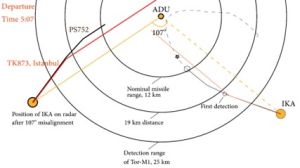
Figure 5 shows the vertical path of the flights that left IKA on the morning of January 8th. It is evident that in terms of altitude, all flights have a very similar path. Therefore, it is very questionable why the operator did not see the TK873 as a hostile target as was the case for PS752.

After 10 minutes, KK1185 of Atlas Global departs for Istanbul as well. This is shown in Figure 5 59. The same questions for TK873 above, holds for the case of this flight as well. If the operator was informed about an outgoing flight from IKA, he should have wondered why a few minutes after given permission for flight KK1185 an object appears on his screen from a location which is not in fact the IKA. If the operator had no idea about the incoming and outgoing flights, then KK1185 was a flying object, passing close to the ADU. It is very important to mention that all these flights, when appearing on the ADU's radar screen, are in steady increase of airspeed and altitude in their flight profile. For instance, the moment the first missile detonated near PS752, the plane was flying with an airspeed of 509 km/h, while the cruising airspeed of a Boeing 737-800 is around 860 km/h. The same holds true for the other flights as well. When they first appear on the radar screen, their velocity is a fraction of their cruising speed which should be easy to recognize for an experienced operator. Therefore, the operator should have known that the objects he observed on radar screen have just recently taken off. And he certainly was aware that there is no air base close by in his southwest direction. If any misalignment had occurred, this should have allowed him to learn about it.
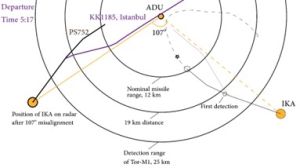
Shortly after 5:39TT, Flight QR8408 that leaves for Hong Kong, is on the operator's radar screen, depicted in Figure 5-60. An object enters the radar screen from southwest, makes a complete turn and goes back towards southwest. The operator sees an object that initially approaches the ADU, changes direction almost 180 degrees, turns back and goes away. If there was a misalignment in the north direction of the radar and the operator was not aware of it, after observing such a maneuver on his radar he should have certainly realized that there is some problem with the calibration of the radar. Nevertheless, this flight did not reach the nominal operational range of the ADU and was not at the risk of being shot down.

Finally, at 6:12TT, and after 57 minutes of delay, PS752 takes off. The flight path for PS752 is very similar to the flights that left for Istanbul (which are also shown on Figure 5-61), and the altitude is almost identical to the other flights that left IKA after midnight of January 8th. The operator has observed nine previous flights (presumably, the identification of the last four of them was affected by misalignment) on his radar after being dispatched to Bidkaneh on the midnight of January 8th, that looked very similar to PS752 in terms of flight specifications. According to the “Factual Report”, from 4:00TT, “only the flights already detected and cleared for flight operations by the defence network could be permitted to start up ([101] page 2)”. Yet, this time, allegedly, the operator believes that PS752 is a missile. These explanations do not add up. Considering the analysis outlined in this section, there is no reasonable explanation to believe that a misalignment of 107 degrees occurred that was overlooked by the operator.
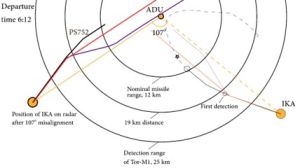
5.11 Trace of Explosives
According to AAIB's Final Report, traces of explosive trinitrotoluene (TNT) was detected on the outer layers of the fuselage of the downed Flight PS752. Additionally, the report provides that a small amount of DNT was also observed on the remains of the aircraft. The presence of these substances at the crash site is significant as it gives rise to multiple possibilities. As a result, it is important to understand the source of these materials.
Iran’s report asserts that the TNT trace was similar to the aliphatic compounds used in the Tor-M1 missile launched at the aircraft, and that the DNT could have been a by-product of the thermal degradation of the aircraft's conventional substances like fuel and epoxy. According to the leaked audio file of a top Iranian official, which is discussed in Appendix A, Iran’s investigation team was in charge of analyzing the types of explosive materials (whether from a missile or a bomb) on the remains of the aircraft. The recovered parts of the aircraft were sent to the Atomic Energy Organization of Iran as well as a few other laboratories to test for explosive materials. This process usually takes some time to complete, but in the middle of February, the results arrived indicating that there were no other explosive materials on the plane. The only explosive material that was reported was from the missiles themselves.
According to explosive experts, TNT is known to contain DNT as it is an intermediate product of the manufacturing process. Consequently, there are always DNT impurities in most TNT explosive-based charges or commercial TNT products. When explosive charges detonate, they leave unburned trace residues of each with varying concentrations. Thus, finding both TNT and DNT on the surfaces of the aircraft could be a sign of the blast from a warhead containing TNT explosive and DNT impurities. Considering that TNT was detected, the most probable source of DNT found on surfaces and windows of the aircraft are from the unburned residues from the blast from the missile warhead.
Moreover, AAIB's Final Report explains that TNT was also found in the interior part of the aircraft cabin window. The presence of TNT on the interior side of the aircraft cabin window may be suggestive of the presence of explosive materials other than what was present in the missiles fired at Flight PS752. According to explosive experts, the AAIB’s claim that the source of DNT produced by the burning process of something other than the warhead is not very probable, and almost impossible. TNT is only used as an explosive ingredient. As such, TNT generation by some other substance or source is not possible.
In conclusion, there are two reasonable explanations for the presence of TNT inside the aircraft. The first one is that the missile blast spread trace residues of TNT and DNT inside of the aircraft on windows, which Iran did not mention in its Final Report. The second explanation is that an external factor such as bombs carried inside the aircraft cabin can be the source of the TNT detected in the interior side of the aircraft cabin window, which needs to be investigated further. Possibility of an explosion could be linked to the fuel sensor issue that is discussed in Section 5.7.1 of this report.
5.12 Tensions in the Cabin
Based on the leaked audio file of a top Iranian official, which is discussed in Appendix A, there are no remains of many seats of the aircraft. He stated that because the material was made out of “composite”, it had burned and was destroyed. This claim is not consistent with the fact that the passports and many of the passengers’ belongings survived the fire caused by the downing and were in good or even intact conditions. Some may suggest that the fire was not spread evenly in the cabin and that’s why many passengers’ seats were fully burned and vanished whereas some passengers’ belongings remained almost intact from any damage. Yet, another important question is why many corpses were not with the seats when the PS752 hit the ground in Shahed-Shahr.
According to Alexander Ruvin, the Head of the Ukrainian forensic team from the Kyiv Research Institute of Forensics, passengers were in a state of “panic” before the plane was hit by IRGC missiles [119]. Ruvin said the plane had not risen to a high enough altitude to permit passengers to take off their seatbelts. If the passenger seat belts were fastened, as they should have been, they would have fallen to the ground with their seats, he said. “We saw the corpses of the dead lying on the ground, without seats,” Ruvin stated. “There is reason to believe that the aircraft was burning from the inside and through the holes, black smoke came out,” he added.
It is unclear what could have caused the state of panic on the plane 'before' the first missile struck, as referred to by Ruvin, that caused the passengers to get out of their seats. Based on the available information, there could be three main explanations for the panic on the plane. First, there are some unverified claims that Iran may have fired not two, but more missiles at the plane. That first missile is believed by multiple witnesses to have missed the plane and instead just caused panic among the passengers in the cabin. The second possibility is that an explosion by an external factor like bombing may have happened before the IRGC missiles hit the plane, and that was the reason why some passengers took off their seatbelts to move to parts of the plane less affected by the explosion. Tension in the cabin could be linked with the cause of the fuel sensor issue that was discussed in Section 5.7.1 of this report. Tor-M1 is designed to take down a fighter plane, cruise missile or helicopter just might not be enough to instantly destroy a big jetliner. The third possibility is that a lot of travelers look out their windows during take-off and landing, many of them might have seen the missile in the last few seconds before it detonated.
5.13 Deliberate Destruction of Electronic Devices
Through independent investigations led by the Association, it was revealed that the electronic devices of the passengers of Flight PS752 were subjected to human manipulations to destroy key components inside the electronic devices. The examined devices were given to the Association by the families of victims, and included an iPhone, a Samsung smartphone, a laptop, and an apple watch. The results of this investigation indicate that all of the devices that were examined had damages that were inconsistent with damages caused by a sudden and hard impact. In particular, the memory and data components of the devices were crushed or removed in all of these instances.
This investigation was conducted by Mr. Mark Mendelson, a professional investigator experienced in the analysis of smart phones, laptops and other electronic devices. In his report, which is reproduced in Appendix J, he indicates:- All of the items I viewed had extensive outer damage, including cracked screens and the casings either bent or crushed, yet they were devoid of any evidence of fire, water or the odor of jet fuel. Although broken screens and bent casings are common in any type of severe impact, having all of the screens separated from the body and having internal memory components crushed or removed is of great concern. Indeed, this fact leads me to believe that these items were manipulated post-crash.
Mr. Mendelson further remarks that the fact that the screws were removed and covers pried open “strongly suggests that concerted efforts were made to extract (the memory/data) components, rendering a review of data impossible.
A deliberate and systematic tampering with the electronic devices is significant as it suggests that there could have been critical information recorded on board the flight which would have implicated the perpetrators of the downing in a serious way. It is not clear what the nature of the information recorded on the electronic devices of the passengers were to persuade the Iranian authorities to destroy the devices. Nonetheless, what is certain is that a “series of errors”, as claimed by the Iranian officials, would not have justified such a human manipulation with the electronic devices of the passengers.
6. HUMAN RIGHTS VIOLATIONS
176 innocent passengers and an unborn child perished on January 8, 2020, when the Ukrainian International Flight PS752 was shot down by two surface-to-air missiles from the Islamic Republic Revolutionary Guard Corps (IRGC) over Tehran's Imam Khomeini International Airport. Islamic Republic of Iran's authorities have been systematically covering up the downing since the early hours after the event; from denying the missile attack for three days to bulldozing and looting the crash site and failing to return the victims’ belongings and valuables to their families. Iranian authorities interfered with burial rites, hijacked funerals, and disrespected and mishandled the bodies.
According to Human Rights Watch who spoke to 31 family members of victims, Iranian authorities have engaged in a campaign of harassment, abuse, arbitrary detention, summoning, interrogation, torture, and otherwise mistreating victims’ family members [120]. “Iran’s Revolutionary Guard killed 176 people without a shred of accountability, and now Iran’s brutal security agencies are abusing victims’ family members to squash any hope for justice,” said Michael Page [121].
After the IRGC admitted they shot down Flight PS752, a series of protests broke out in several cities in Iran. Several people were arrested and detained. According to the Human Rights Watch report that was released in May 2021, “Over the past year, courts have sentenced at least 20 people in connection with their participation in protests. [122].” Three more participants have received their sentences just shortly before publication of this report.
In spite of admitting the downing, the IRGC has not accepted responsibility. As per the Chicago convention, Annex 13, Iran as the state of occurrence is responsible to investigate the incident. Over the past several months Iranian courts, and particularly revolutionary courts, have failed to conduct an independent investigation and failed to prosecute the responsible authorities in an impartial fair trial. “On April 6, 2021, Iranian authorities announced that they had indicted 10 people for their role in the incident but have not provided any public information about their identities, ranks, or the charges against them.” Human Rights Watch reported, published on May 27, 2021. In September 2021, the Islamic Republic of Iran’s military tribunal in Tehran issued a notice to the families who have filed a lawsuit. According to this notice, the Iranian courts have prohibited the criminal prosecution of the principal culprits of the PS752 downing. This notice instead provides the names of the few low-ranking subordinates of the IRGC who have been charged only with participating in the manslaughter of 177 people, negligence, recklessness, and failing to observe official duties
In this chapter we attempt to draw the international community’s attention to the series of human rights violations committed by Islamic Republic of Iran in relation to the aftermath of downing Flight PS752, which have (and continue) to cause immeasurable psychological damage to the families of the victims.
6.1 Abuses Against Victims’ Family Members
6.1.1 Bulldozing the Crash Site, and Looting Passengers’ Belongings
Initially, the Islamic Republic of Iran officials closed off the crash site for a hurried and selective clean up. Within hours of the aircraft's downing, the crash site, body parts, and other belongings of the victims were left unsecured for the public to access. Iranian officials used bulldozers to clear the crime scene before international investigators were granted access [123]. Evidence was destroyed, tampered with, and confiscated. Photographs, taken from the crash site in the early morning hours after the downing, show hundreds of people including members of the Iranian Red Crescent Society, security forces, and individuals without identification or uniform. According to local residents and other witnesses, numerous individuals, including law enforcement officers, looted intact suitcases, cash, jewelry, identification documents, electronic devices and other valuables belonging to the passengers. Several family members expressed that, based on the news media's pictures of the crash site, it was evident that some of their loved ones' belongings were intact and in good condition. However, they have not been returned. Agnes Callamard, the then Special Rapporteur on extrajudicial, summary, or arbitrary executions expressed the seriousness of these violations in her report [107]:
“The reported treatment of the crash-site, in effect a mass grave, raises serious concerns… Governments should ensure that mass graves are preserved and protected and take all measures necessary to immediately protect mass gravesites from erosion, destruction, manipulation and looting.
“The Minnesota Protocol requires the crime scene, defined as any physical space where evidence may be collected, such as the crash site, be “secured at the earliest possible opportunity and unauthorized personnel shall not be permitted entry.” All material collected, including all “personal effects of the deceased, either worn by or in the possession of the deceased,” should be recorded and properly stored. The personnel effects must be returned to the families when there is no further need for them in the investigation. There is no excuse for the State allowing personal items to be stolen or looted or failing to return these items to the families.”
“The authorities allegedly denied the families access to the crash sites and failed to return the entirety of passengers’ belongings, with the result that many families are left without even the smallest mementos of those who lost their lives on PS752.”
According to the local residents, officers returned to the crash site several times and set fire to the remaining belongings of passengers, for months after the downing. Figure 6-1 shows law enforcement officers searching bags and removing some of their contents at the crash site. There is also this video [124].
In the early weeks, the Iranian authorities contacted the families of the victims and asked them to collect their loved ones' belongings. Families, however, were denied access to loved ones' electronic devices even after recognizing their devices. They were told that the authorities were reviewing the contents of the devices. While some electronics were returned, their memory cards were removed by the Iranian authorities. According to the Ukrainian forensics head, Alexander Ruvin, “Several mobile phones and tablets which belonged to the 176 deceased were taken from the Ukrainian team by the Iranians [125]” Figure 6 2 is a picture of some of the electronics that were collected by the Iranian authorities from the site before they were returned to the victims’ families. The bent electronics have raised questions and concerns among several families. One likely explanation is that these electronics may have been bulldozed over in an attempt to destroy any potential evidence that victims recorded in the last minutes of their lives. However, as mentioned in Section 5.13, the Association’s independent investigation revealed that the devices were deliberately tampered with to destroy their memory components. According to the Human Rights Watch report, “Those devices had sentimental value for families, since they stored many photos and videos from the victims, including some of the last shots they took, several family members said [120].”
There were at least 82 suitcases at Imam Khomeini International Airport in Tehran that weren't loaded onto the aircraft. These were the only suitcases that were returned to the families. Yet not every item from those suitcases was returned, especially those valuables that belonged to their loved ones. A number of these suitcases were found to have been unlawfully searched before being handed over.
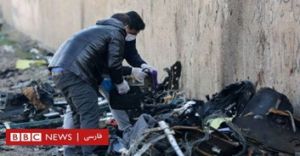
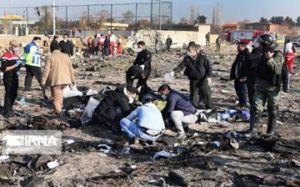
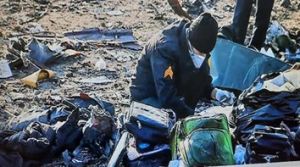

The Indonesian Lion Air flight JT 610 crash in October 2018 off Indonesia was used as a case study to compare the way the victims' belongings and the crash site must be handled by the state of occurrence. Figure 6-3 shows an example of the victims’ belongings collected from the bottom of water and laid in for identification with great care [126].
By failing to protect the passengers' belongings, Islamic Republic of Iran has exacerbated the emotional impact on the grieving families, as they were deprived of items of sentimental value. The items, if returned properly, could have helped grieving families better understand their loved ones' final moments; anything from the deceased's possessions could help their grieving families cope with their losses.
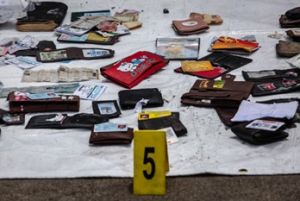
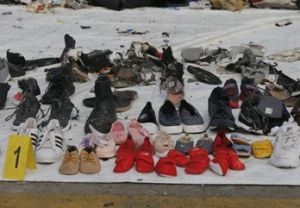
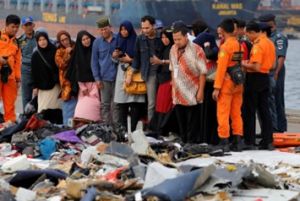
6.1.2 Repatriation of the Victims and Mishandling of Remains
A number of families sought to repatriate their loved ones to other countries, but a number of reports from the families indicate that the Iranian authorities attempted to obstruct these requests in one way or the other. In some cases, the Ministry of Foreign Affairs of Iran required the families to sign a form without which the repatriation cannot be allowed. However, in some cases, families who requested to repatriate their loved ones were not asked to sign this form. According to the UN report, the form required signatures from family members declaring that the victim only had Iranian nationality [107]. This has raised several questions regarding the logic behind this controversial requirement.
In another instance, the authorities intervened in the process of repatriation to block an ambulance carrying the remains of one of the victims to the airport. The ambulance was called back to the coroner’s office without stating the reason, despite having received prior permission to transport the victim’s remains to the airport. Once there, the authorities informed the family of the victim that the body cannot leave the country. It was only after multiple urgent requests to other offices that the coroner’s office issued the permission for the coffin to go to the airport again.
At least for three of the repatriated bodies, DNA tests conducted by the Islamic Republic of Iran were inaccurate, according to reports received by the association. During DNA testing by destination countries, the families were informed that the DNA tests conducted by the Islamic Republic of Iran were incorrect, and that some body parts did not belong to their loved ones. Families are now concerned whether the Islamic Republic of Iran conducted DNA testing properly or even if they did it at all. The burials of two other victims in the United Kingdom were also delayed for over forty days due to Islamic Republic of Iran's unwillingness to cooperate in transferring DNA results.
According to the Human Rights Watch report, “Families also said that authorities did not allow them to see the bodies of their loved ones. Five family members were particularly disturbed that though they had made repeated requests, the authorities who handled the bodies refused to allow them to see the body of their loved one in a casket. “To this date, I do not know if I actually buried my own son,” a mother of one victim said. Another family member said that when they received the casket, they asked for more documentation that would prove it contained their loved one’s body. But the authorities responsible for returning the bodies refused to provide such documentation or said that they did not have any [documentations] [120].”
The crime scene was cleared by Iranian officials using bulldozers in the early hours after the downing, prior to the arrival of international investigators. While the remains of victims were still at the crime scene, Iranian authorities bulldozed them over utterly disrespecting their bodies and families. Families were denied the basics of human dignity, which is to have the bodies of their loved ones treated respectfully.
6.1.3 Interference with Burial Rites, Memorial Gatherings and Hijacking Funerals
For intimidation and propaganda purposes, representatives of the Islamic Revolutionary Guard Corps (IRGC) repeatedly contacted and forcefully visited the families of the victims at their homes and at funerals. The majority of these visits were against the families' wishes. A report to the association indicates that Islamic Republic of Iran's then Foreign Minister, Javad Zarif, was at a meeting with the Supreme National Security Council on Friday, the day before the IRGC publicly admitted to downing Flight PS752 with their missiles. According to information received by the Association, during this meeting, the IRGC members and the Foundation of Martyrs and Veterans members were summoned and assigned to contact and visit the grieving families. A vast majority of the families of the victims believe their loved ones were murdered by a targeted and deliberate attack. Families did not want visitors from those they considered murderers. In addition, the officials who forcefully visited victims’ families brought a reporter crew to the families' houses without their knowledge or consent, interviewing grieving families and their relatives.
Later, Islamic Republic of Iran's state-run media heavily edited these interviews to serve its propaganda purposes. The authorities threatened families that publicly condemned the IRGC for this crime; these families were asked to report to the Iranian Intelligence Agency and explain their behaviour. “There are reports that, in the context of public protests about the downing of PS752, Iranian officials sought to coerce families into publicly declaring their support for the Government or risk the non-return of their loved ones’ remains.” Agnes Callamard, the then special rapporteur on extrajudicial, summary, or arbitrary executions at the United Nations reported in December 2020 [107].
The Islamic Republic of Iran hijacked funerals for propaganda purposes. IRGC officials showed up uninvited to the funeral, acted as hosts, greeted visitors, and took photos without the family's permission for state media. In some cases, even the families of the victims were prevented from attending the funeral of their loved ones [127]. In fact, every funeral and memorial gathering was closely monitored and controlled by the Iranian authorities (Figure 6 4 through Figure 6 6).
In addition, families were pressured to accept “martyrdom” status for their loved ones. An individual is referred to as a "martyr" if he gives his life in order to defend Islam, the Islamic revolution, and its achievements. This caused immeasurable pain to the victims’ families as they do not believe their loved ones lost their lives for the same cause. Many families reported that, despite refusing to accept martyrdom status, they were issued "martyrdom death certificates" without their consent and knowledge. Some families were even forced to bury their loved ones in the designated sections of cemeteries for martyrs. There have been instances in which victims have been buried in martyr's sections of cemeteries without the families' permission or presence. In several cases, the authorities carried the victims' caskets and wrote “congratulations on your martyrdom on the caskets without the families’ consent. According to the Human Rights Watch report, “Families said they believed that the authorities’ attaching “martyrdom” status to Flight 752 victims was a way for the state to assert control over the process of memorializing victims and to distract people from calls for accountability [120].”
The Islamic Republic of Iran's harassment and interference with memorials and vigils has continued since the downing of PS752 and intensified around the first anniversary according to the victims’ families.
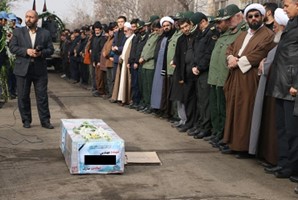 |
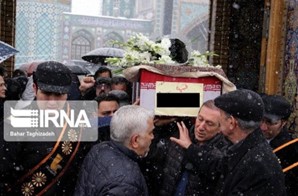 |
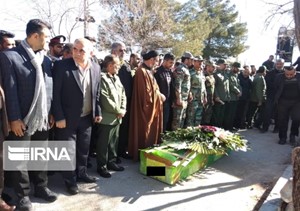 |
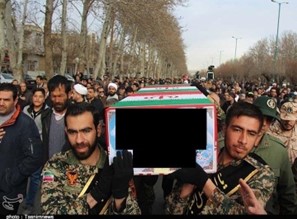 |
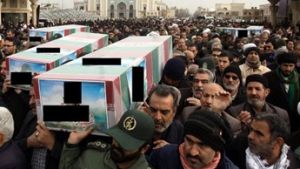 |
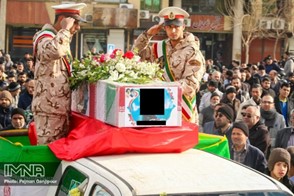 |
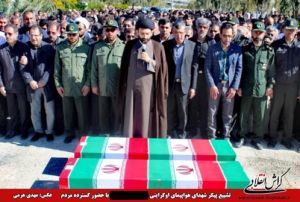
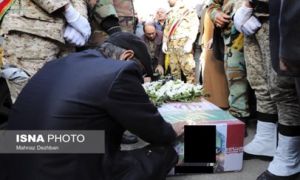
6.1.4 Emotional Harassment and Physical Torture
According to Human Rights Watch, who spoke to 31 family members of victims, Iranian authorities have engaged in a campaign of harassment, abuse, arbitrary detention, summoning, interrogation, torture, and otherwise mistreating victims’ family members to silence accountability efforts. “At least 16 people said that security agencies threatened them not to participate in interviews with foreign media or had followed or summoned their relatives or friends who attended memorials and filmed those attending these events”. Human Rights Watch reported [120].
The IRGC and Iranian officials attempted to intimidate families through continuous phone calls and uninvited home visits. A number of the victims’ family members were physically assaulted. Two officers sexually assaulted the aunt of one of the victims while she was summoned to the Intelligence and Security Office. One of the victims' fathers was detained for over eight hours after he protested and cried against the crime.
As Human Rights Watch further reported, “In at least one case, the authorities tortured a person in custody. In another case, plainclothes officers asked to meet a family member who had spoken against authorities’ conduct at a public place and threatened that person with prosecution. In at least three cases, the authorities threatened family members with “consequences” unless they removed social media posts critical of the government’s lack of accountability.” In at least four cases, family members of victims residing in Canada received several death threats and received numerous threats on-line [128].
In her report, Agnes Callamard, the then special rapporteur on extrajudicial, summary, or arbitrary executions at the United Nations has stated that the Islamic Republic of Iran apparently made an initial offer to financially compensate the victims’ families with a condition that no legal action be taken against them [107].
6.2 Mishandling of the Domestic Investigation
6.2.1 Insisting on Filing Lawsuits in Domestic Courts
Several of the victims’ families were skeptical of the impartiality of the justice system and were reluctant to file domestic charges. The mistrust grew deeper especially after the senior officials of the Islamic Republic of Iran, including the chief justice, praised the commanders of the IRGC for their January 8th mission on Ain Al-Assad while refusing to hold them accountable for the downing of flight PS752 that same night.
A few weeks after the downing, an organization called the Islamic Human Rights Commission (IHRC) which is affiliated with the judiciary system, began to contact the families. IHRC Representatives called families repeatedly, urging them to file complaints with the Iranian judicial system. These phone calls continued unabated for four months. Through these calls, Yadollah Asgari, a "trusted" attorney of the government, was introduced to the families by the judiciary. Some families received a “Notice of Imposed Attorney” from the Judiciary Organization of the Armed Forces informing them that an attorney was appointed for the family; despite the fact that they did not request this (Figure 6 7). By appointing their own trusted attorneys to this case, it appears that the Iranian judiciary organization was attempting to control and influence the investigation.
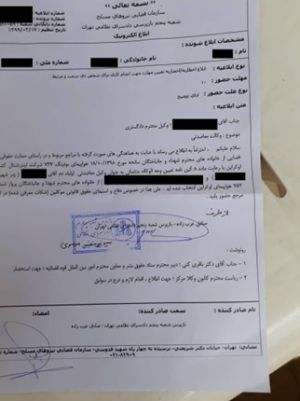
6.2.2 Financial Compensation in False Trade for Impunity
Hassan Rouhani's cabinet announced one year after the incident and before any transparent investigation had taken place that it had allocated US$150,000 to compensate the families of each passenger [129]. In spite of this decision, the families of victims repeatedly insisted that an independent and transparent investigation be conducted before compensation is discussed. According to the United Nation report “On April 15, Iran made an offer of financial compensation to Ukraine and the families and promised publication of the black box data, apparently on the condition that no legal action be pursued against Iran [107].” As such, Islamic Republic of Iran offered its compensation in false trade in order to gain impunity.
6.2.3 Refusal to Provide any Information about the Domestic Investigation
In May 2021, the families who filed domestic cases reported that they were not able to get any information neither about the investigation nor about the judicial progress on their filed complaints. According to The Human Rights Watch report, published on May 27, 2021, Iranian authorities have not released any details regarding the investigation of domestic criminal investigations, nor have they disclosed the names or ranks of those detained or interrogated [120].
Tehran's military prosecutor, Gholam Abbas Torki, told reporters on January 7, 2021, that the investigation determined that the missile operator’s human error caused the downing. One person who was not identified by name or rank remained in custody, he said [130].
The families of the victims met with the military prosecutor over a year after the incident on February 13, 2021. Families asked whether investigators had summoned Amir Ali Hajizadeh, commander of the IRGC's Aerospace Force, against whom they filed a complaint in connection with the downing of the plane. During this meeting, not only were no explanations provided to the grieving families, but the deputy prosecutor, Ebrahim Hatami, told a bereaved father: “We did well to kill them [131].”
After a few days, on February 20th, Shokrollah Bahrami, the head of the armed forces judicial body, told the Iranian Students’ News Agency (ISNA) that the investigation was complete and judicial authorities were preparing the indictments [120].
On March 17, 2021, Islamic Republic of Iran’s AAIB published its Final Report on the incident [84]. The report blames the cause of the incident on the missile operator who misidentified the civilian airplane as the military threat. According to the report, the operator launched missiles before hearing back from his commanders. In a statement issued the same day, the Canadian minister of foreign affairs and transportation said, “The report makes no attempt to answer critical questions about what truly happened. It appears incomplete and has no hard facts or evidence [132].”
Dmytro Kuleba, Ukraine's foreign minister, also called the Iranian investigation "biased," the evidence presented "selective," and the conclusions "deceptive [133]."
On April 6, 2021, Torki, Tehran military prosecutor, announced that ten military officials who were involved in the downing of the airplane had been charged, but he did not disclose their identities or ranks [134]. The families received a legal notice on May 5th stating that 10 people had been indicted for the downing and would face prosecution. Again, neither their names nor their ranks were disclosed. However, the notice states that the prosecutor does not have the jurisdiction to investigate the complaint against The State's Forensic Pathologist, who is being sued by the families for failing to perform proper identification tests on the bodies of the victims and for not returning the belongings of each victim to their families. In addition, the prosecutor has dropped charges against all others who were facing a complaint [135].
According to The Human Rights Watch report “On May 16, several family members filed a new complaint against Hossein Salami, the commander in chief of IRGC, Ali Shamkhani, the secretary of the Supreme National Security Council, and Mohammad Hossein Bagheri, the chief of Islamic Republic of Iran’s Central Command of the Armed Forces, at the Branch 2 of Tehran First Branch of Criminal Military Court.”
In September 2021, the Islamic Republic of Iran’s military tribunal in Tehran issued a notice to the families who have filed a lawsuit. According to this notice, the Iranian courts have prohibited the criminal prosecution of: the Government of the Islamic Republic; the Supreme National Security Council; the Islamic Revolutionary Guard Corps (IRGC); the Unified Air defence Forces; the defence Forces; the IRGC Aerospace Force; Iran’s Civil Aviation Organization (CAO); Hossein Salami, Commander-in-Chief of the IRGC; Amir Ali Hajizadeh, Commander of Aerospace Force of the IRGC; and Ali Abedzadeh, former Head of Iran’s CAO.
This notice instead provides the names of the following low-ranking subordinates of the IRGC who have been charged only with participating in the manslaughter of 176 passengers and crew and an unborn child, negligence, recklessness, and failing to observe official duties: IRGC Captain Mehdi Khosravi (TOR M-1 commander); IRGC First Lieutenant Meysam Kheirollahi (Operator); IRGC Third Lieutenant Seyed Ahmad Miri (Operator); IRGC First Lieutenant Mohammad Majid Eslam Doost; IRGC Captain Sajjad Mohammadi; IRGC Major Hamed Mabhout; Islamic Republic Army Colonel Mostafa Farati; IRGC Second Brigadier General Ibrahim Safaei Kia; and IRGC Brigadier General Ali Akbar Seydoun.
The families’ access to details of the domestic investigation, the progress of their filed complaints, and the issued indictments are still extremely limited and/or blocked at the time of publication of this report.
6.3 Arresting and Imprisoning Protesters
After the Islamic Revolutionary Guard Corps admitted to downing Flight PS752 with their missiles, vigils and widespread protests erupted in several cities in Iran including Tehran, Amol, Shiraz, and Mashhad [136]. Security forces responded with excessive use of force, including physical attacks and the use of tear gas, pepper spray, batons, rubber bullets and pointed pellets. They arrested and injured protesters [137]. “Hundreds of individuals were arrested and subjected to physical and psychological torture and ill-treatment have been used for the purpose of extracting confessions with families denied information about the individual’s fate and whereabouts in some cases” according to the United Nation report. Gholam Hossein Esmaeili, the judiciary spokesperson, told reporters on January 14, 2020, that the authorities had arrested about 30 people during the protests [138]. Human Rights Watch reported in May 2021 that over the first year the courts have sentenced at least 20 people in connection with their participation in protests [139]. At least three more participants, among whom are Ziauddin Nabavi, Amir Hossein Ali Bakhshi, and Ali Haghighat Javan, have received their sentences just shortly before publication of this report [122]; [140].
According to the information gathered by the Association through several resources [Refer Appendix F], it appears that at least 72 people were either summoned or arrested and imprisoned. Many of those arrested were sentenced to several years in prison for “Propaganda against the state - Art. 500 IPC²⁹”, “Assembling and colluding to act against national security - Art. 610 IPC” and “Disrupting public order - Art. 618 IPC”. To name a few, Iran Human Rights Monitor reported in September 2020 that Mostafa Hashemizadeh, a civil engineering student at the University of Tehran, is sentenced to five years in prison on a charge of “assembly and collusion to disrupt national security.” This young man is also sentenced to three months of public service at a mental hospital, 74 lashes, and is barred from entering the university dormitory for two years due to “disrupting public order [141].” According to Iran Human Rights Monitor (HRM), “Mostafa Hashemizadeh was pressured to make false confessions during the interrogation. The interrogator threatened to kill him by air injection and abandon his body in a remote location if he did not collaborate with them. Another time, the interrogator threatened to kill him the next morning if he did not confess to what they wanted.”
In another instance, Roghayeh Bigdeli from Karaj, attended the protests, and was sentenced to 'exile' due to “Propaganda against the state - Art. 500 IPC” and “Membership in organizations that aim to disrupt national security - Art. 499 IPC” [142] ; [143]. Masoud Hokm Abadi, a producer and artist from Mashhad, was arrested for refusing to attend the Fajr Festival in protest of Flight PS752’s downing by the IRGC, and was sentenced to two years in prison due to “Propaganda against the state - Art. 500 IPC and Insulting the Leader or the Founder of the Islamic Republic of Iran - Art. 514 IPC [144]; [145].”
According to Hossein Sherkat Massoum, who published his initial court ruling on his Twitter account, Ahmad Zargar, the judge and executive of the Tehran Revolutionary Court (Branch 36), lifted Massoum’s supplementary punishment for his collaboration during trial, yet this trial was held without Massoum’s presence (Figure 6 8) [146]. This supplementary punishment included: 1) Providing service to Islamic Basij Organizations for 6 months, 4 hours per day; 2) Studying and researching on Flight IR655 that was shot down by the USS Vincennes in 1988, to be handwritten in 120 pages and his handwriting to be verified; the judge is required to compile seven questions and evaluate his knowledge over the content by conducting a test; the accused to be re-evaluated in six month if he failed the test; 3) Gathering information about the United States’ cruelty against his own nation and the world, posting these contents daily with visuals; and 4) Barred from membership in any religious, political or social groups for two years. From these outrageous rulings, it is evident that these protesters have been treated as traitors of the Islamic Republic of Iran only for participating in the peaceful demonstrations or for holding candle vigils in memory of Flight PS752 victims.
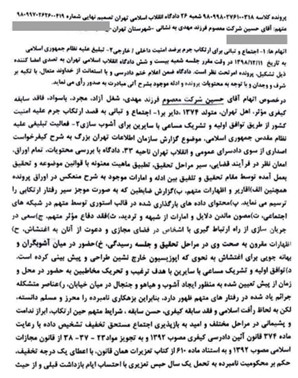 |
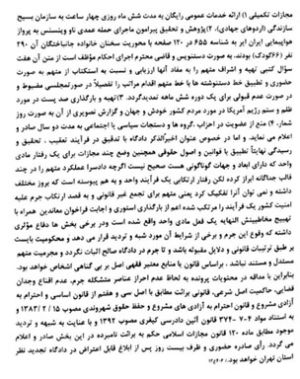 |
Appendix F of the report contains details on several of the arrested and imprisoned cases compiled by the Association of Families of Flight PS752 Victims.
²⁹ Islamic Penal Code (IPC)
6.4 Media and Psychological War
In parallel with the aftermath of downing flight PS752, the Islamic Republic of Iran has waged a systematic media and psychological war. This has been a propaganda campaign that distorted the truth for the families of the victims and misled public opinion in favor of the Islamic Republic of Iran's political agenda.
During the three days following the downing of Flight PS752 on January 8th, Iranian officials lied furiously to deny any missile attack had occurred. There were several rushed interviews in the domestic media ranging from the highest civil aviation organization authorities to government-trusted aviation experts expressing their deceitful theories about the incident. Starting immediately after the downing and during the three days of constant denial, the authorities were bulldozing the crash site and were looting passengers' belongings and valuables.
On the morning of January 11th, after three days of denial, Islamic Republic of Iran's General Staff of the Armed Forces admitted they were responsible for downing flight PS752 with their missiles. In a lame statement, the IRGC offered an insincere apology and blamed one operator's human error for the deaths of 176 passengers, an unborn child, and the crew. On January 9th Ayatollah Khamenei, the Leader of Islamic Republic of Iran, and on a later occasion January 14, the Foundation of Martyrs and Veterans both called the victims “martyrs”, a status given to those who sacrifice their lives in defending the goals of Islam and Islamic revolution and its achievements [147][148][149].
Martyrdom status is considered holy in Iran's public belief and culture. The families of martyrs are treated with respect, their loved ones are buried in designated martyrdom sections of cemeteries and the families receive government financial support. By giving a holy status of martyrdom to the victims, the Islamic Republic of Iran attempted to mislead and deceive the public opinion and families of the victims of Flight PS752. In addition, by controlling and interfering with funerals and memorial gatherings, and forcing financial compensation in false trade for impunity, the Islamic Republic of Iran deliberately diverted attention from calls for accountability.
The IRGC's admission that they downed the aircraft with their missiles sparked an intense reaction from the Iranian public, resulting in protests across the country. People demanded accountability and asked why the Islamic Republic of Iran covered up the truth and denied responsibility. The Iranian authorities arrested and imprisoned several protesters and heavily controlled peaceful candle vigils and memorial gatherings. During the year following the downing, some of those who were imprisoned made their court rulings public. Court rulings revealed that arrested protesters were treated as traitors to the Islamic Republic of Iran for participating in peaceful protests or holding candle vigils in memory of flight PS752 victims. Several protesters were sentenced to prison terms of several years.
In the days following the tragedy, families were called in groups to receive the bodies of their loved ones. Funerals and memorials were heavily controlled and, in some cases, completely taken over by the Iranian authorities. Some families who repatriated their loved ones’ remains were interfered with higher authorities or suffered lengthy delays due to Islamic Republic of Iran’s unwillingness to cooperate in transferring DNA test results. During this time and afterwards, the Islamic Republic of Iran waged a campaign of harassment and abuse against families in order to suppress accountability efforts.
During the initial weeks after the downing the families of victims were called to collect the belongings and valuables of their loved ones, which were reportedly looted. The families also complained that the authorities mistreated them during the collection of their loved ones’ belongings and made hurtful comments to downplay the atrocity of downing flight PS752. Javad Soleimani who lost his wife, Elnaz Nabiyi, in the downing of flight PS752, in the documentary of “Dear Elnaz” describes the day he went to collect his wife's belongings; “I saw Judge Mohammad Shahriari, the head of the criminal court of Tehran, and the Kahrizak autopsy authorities sitting at a table laughing and eating cucumbers! Is this how to greet the grieving families?”. In another similar instance, the family members who went to collect their loved one's belongings were told by the authorities “why are you crying so much? What is the big deal?”
Iranian authorities delayed sending the black boxes to be analyzed for over six months, even though, according to ICAO Annex 13, the country of occurrence is required to immediately send the black boxes to be analyzed. The black boxes were discovered in the initial days after the downing. Images and video footage from the first days shows that the black boxes were intact and in good condition [150]. On February 19, 2020, Amir Hatami, Islamic Republic of Iran’s defence minister, claimed that the black boxes were heavily damaged despite the evidence to the contrary[151]. During an interview with NBC News on February 14, 2020, the Foreign Minister of the Islamic Republic of Iran, Javad Zarif, claimed that while Iran does not possess the technology to analyze and retract black boxes data, his country has not yet turned them over. Rather, Zarif blames the United States for failing to assist the Islamic Republic of Iran on what he claimed was a humanitarian issue and for not handing over the tools and technologies needed to analyze the black boxes [152].
The Islamic Republic of Iran also used the COVID-19 pandemic as an excuse for delaying the delivery of flight recorders to France despite having months before the pandemic to do so [153]; [154]. In spite of the pandemic, there were still flights bound for France, and black boxes could have been sent regardless. On May 9, 2020, ISNA reported that the Islamic Republic of Iran has had several meetings with the European airlines to convince them that Iran’s skies are safe and to have them start flying over Iran and using its air corridors [155]. In the meantime, the black boxes had not yet been handed over for analysis. By refusing and delaying the delivery of the flight recorders, the Islamic Republic of Iran further exacerbated the psychological impact on the families of victims. It is extremely distressing for the families to wait so long for any information to emerge about the content of the flight recorders.
In several instances, the Islamic Republic of Iran showed a lack of willingness to conduct a transparent investigation. They pressured the families to file lawsuits in domestic courts and hire government-trusted attorneys. The Islamic Republic of Iran mistreated the families during their meetings with the judiciary authorities. They offered financial compensation in false trades for impunity. Furthermore, the Islamic Republic of Iran refused to provide any information about the domestic investigation, dragging its feet in releasing the incident technical reports. Even when the reports were published, they were inaccurate and unreliable. It was reported to the Association of Families of Victims that a few days before the Islamic Republic of Iran’s final incident technical report was made public, Arash Khodaei, the head investigator of PS752 and the successor to Hassan Rezaeifar, gathered the domestic media reporters trusted by the government at the Foreign Ministry. Khodaei explained to the reporters what to question or not during the upcoming news press on PS752 final incident report.
During this time, Ebrahim Raisi was appointed as the Islamic Republic of Iran's Chief Justice, overseeing the judicial system. Raisi was a key member of the Supreme National Security Council of the Islamic Republic of Iran, the entity which decided on January 8, 2020, to keep Iran's airspace open. In this capacity, he has systematically blocked all paths to truth and justice for those who were affected by the downing of Flight PS752. He has exonerated top military and government officials, but arrested and jailed protesters who spoke out against the perpetrators of this crime. Currently, he is the appointed president following a non-competitive election with less than 50% participation. The Islamic Republic of Iran's unwillingness to conduct a transparent investigation, their continual attempts to avoid accountability, and their obstruction of justice have caused families of victims’ unimaginable pain.
Families of victims came together from all over the world on April 1st, 2020 and founded the Association of Families of Flight PS752 Victims. Since then, they collectively and repeatedly participated in activities to seek justice and truth for their loved ones. The Islamic Republic of Iran has used a variety of tactics to divide the families. For instance, around the first anniversary of Flight 752, Saeed Ohadi, the head of the Foundation of Martyrs and Veterans, told reporters that with families’ consent, 127 victims had been declared martyrs [156]. Historically, families that are registered with the Foundation of Martyrs and Veterans are provided with “financial benefits and better housing, employment, and educational opportunities [157]”. The Iranian government may seem to be offering support to the families by registering the victims as martyrs. However, this depends upon acceptance the families endorse and accept the false narrative that their loved ones died in vain to defend the Islamic Republic of Iran and Islam!
In the Association, the family members disagree tremendously that their loved ones who were simply leaving Iran aboard a civilian plane lost their lives to support the grand goals of Islam and the Islamic revolution. The Islamic Republic of Iran's calculated step could impact the families' unity and jeopardize their collective cry for justice, as a few may have accepted the status of martyr due to their strong religious beliefs, or financial hardship. On the other hand, the Cabinet of the Islamic Republic of Iran also announced that they have allocated $150,000 to compensate the families of victims [129]. This was while almost a year passed from the incident and yet no transparent and independent investigation was conducted. The families repeatedly demanded justice before any talks about compensation. The “compensation” term was deceitfully used in the media in an attempt to create division not only among the families of victims but also to separate the families of victims from their public supporters who were mostly struggling with extreme economic hardship.
Not only did the Islamic Republic of Iran attempt to divide family members, but they also made several attempts to divide countries involved in the incident. The Islamic Republic of Iran, for example, made a secret offer to Ukraine on April 16, 2020, pertaining to flight PS752. “In an interview with Radio Farda, sources familiar with the details of Iran's proposal, confirmed that Iran seeks to reach an agreement with Ukraine in which Ukraine would cease pursuing legal and criminal actions against Iran. According to sources, the proposed agreement has been drafted to shield Iran from accountability [158]."
In November 2020, the Iranian government-linked media falsely reported that the third round of negotiations would take place in December [159]. Ukraine however, on behalf of the countries involved, said that further negotiations depend directly on what information the Iranian side will transmit, and that the exact date of the talks had not yet been agreed upon [160]. It was yet another attempt to mislead the families of victims by claiming that compensation negotiations are taking place successfully. Despite this, families of the victims have repeatedly insisted that the Islamic Republic of Iran be held accountable, that an independent investigation be conducted, that perpetrators be punished, and that discussions about compensation be put on hold until they find truth and justice for their loved ones.
The Islamic Republic of Iran’s domestic media has also actively downplayed the atrocity of the attack on Flight PS752. Iranian TV reported on July 22, 2020 that the number of deaths from COVID-19 in July was equivalent to the downing of 30 airplanes with 170 passengers [161]. The Leader of the Islamic Republic of Iran, Ayatollah Khamenei, made the same comparison of the number of deaths from COVID-19 in a speech he made on September 22nd [162]. To this date, and as the death toll for Covid continues to rise in Iran, many Twitter users with connections to the Islamic Republic of Iran continue to make such comparisons [163]. Since the downing of flight PS752 adversely impacted public perception of the Islamic Republic of Iran, making such a comparison was an attempt by the Islamic Republic of Iran to mislead the public by saying that 176 victims and an unborn child were similar to or fewer than those dying from COVID-19 every month and therefore not as important.
Another example of how the Islamic Republic of Iran's domestic media engaged in downplaying the attack was in portraying Hajizadeh, the IRGC commander in chief, as a heroic figure, instead of questioning him as one of the highest authorities who was in charge on January 8, 2020. Around the first anniversary of flight PS752 Hajizadeh had an interview with “Bedoone Taroof”, which is a domestic TV program notorious for the Islamic Republic of Iran’s orchestrated propaganda and interviews with political prisoners to confess under pressure. In an hour-long interview, he was repeatedly asked about the IRGC missile strike on US bases in Iraq, Ain Al-Assad, and how heroic and successful the mission was. Meanwhile, no questions were asked about the attack on flight PS752 and why the skies were kept open amid high military tensions, and as retaliation was expected from the United States.
A few months after the incident, the city of Tehran offered to build a memorial for flight PS752 victims [164]. Having the Islamic Republic of Iran mishandle the PS752 aftermath, the families of victims have deep mistrust in the system, and this gesture appeared to be a pretentious move to mislead. As the first anniversary of the downing of flight PS752 approached, a memorial service was held at Behesht Zahra Cemetery without the families' knowledge or participation, and solely for domestic media propaganda. During this event, trees were planted in memory of flight PS752 victims, and a memorial stone was unveiled, which had “Memorial to The Martyrs of The Flight 752 carved on it. Later, a civilian spray-painted this memorial stone as a protest against what they viewed as a petty gesture of compassion toward the families of victims (Figure 6-9).
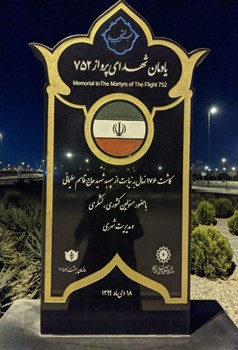 |
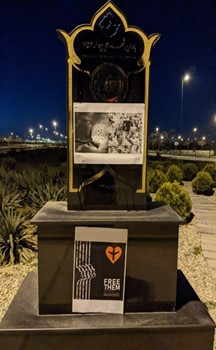 |
On the first anniversary of the incident, families of the victims gathered at the crash site for a memorial service. However, their event was intervened by the authorities. To prevent the families from accessing the site, Iranian officials blocked roads to it. When the families refused to leave, the authorities were forced to allow access although later they heavily controlled the event. The Islamic Republic of Iran’s complete disregard and disrespect for the families of victims have continued to the extent that they are even denied the right to memorialize the crash site. Figure 6-10 shows the wall at the crash site that was covered in blood the day of the incident. This wall was painted over only seventy days after the incident with no acknowledgement of remembering the horrific loss (Figure 6 11). Today, this area has been completely demolished and repurposed for private housing and public parks.
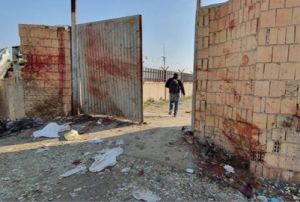
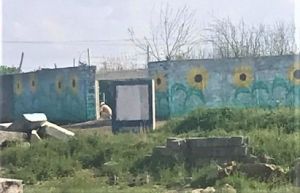
7. CONTEXTUAL INFORMATION AND COMPARATIVE STUDIES
7.1 The 1978 Cinema Rex Massacre
Iran has a history of sacrificing innocent lives for ideological and strategical ends, which we cannot rule out in the case of flight PS752. In the collective memory of Iranians, the crime of downing the Flight PS752 has similarities to another crime committed four decades ago. Pro-Islamic revolutionaries of 1978 and the supporters of Ruhollah Khomeini played a key role in this crime. The revolutionaries were a group of radical Islamists that operated within religious institutions and Mosques, under the guidance of Ruhollah Khomeini.
In the summer of 1978, it became common to set fire to liquor stores, bars, and movie theatres portraying Western films, media, and way of life. The pro-revolutionaries who were influenced by Ruhollah Khomeini and functioned in scattered groups in small and large cities of Iran, considered these places as non-Islamic places and believed that setting them on fire would pave the path for their Islamic revolution.
As one of the four defendants involved in this crime confessed in a court held two years later (after the Revolution), four residents of Abadan, under the influence of cleric and religious activists, decided to do something that would shake the city of Abadan.
Abadan was one of the major oil centers of Iran. Perhaps, it was the most strategic city in the south of Iran in the 1950s, in a decade when the issue of oil was significantly sensitive and always in news headlines. This city, however, had not followed other cities in the midst of an escalating revolution. The fire of the revolution, which had started in Qom since January 1977, was advancing from city to city but wouldn’t reach Abadan. Based on their own confession in court, the revolutionaries led by clerics in Tehran and Isfahan had this belief that Abadan and perhaps the whole country needed an event to start the wheel of revolution.
In the evening of August 19, 1978, four men entered a movie theatre called Cinema Rex, as a general audience, a theatre full of people watching one of the most popular films of the day, The Deer (Gavaznha). They set the corridors on fire with Molotov cocktails hidden under their clothes, and then joined the audience.
When the fire reached the inside of the theatre, the exit doors were blocked due to the crowd attempting to escape, so many died burning in the fire. The revolutionaries blamed SAVAK, the government intelligence services, for the crime, and some people believed the rumor. Ruhollah Khomeini would remember this as the Shah's masterpiece. It was claimed that SAVAK had chained the doors of the theatre from the outside so that no one would survive; a claim that was never proved.
A great disaster happened. The number of victims varies from 377 to 600. Almost everyone was burned, but the number of dead and injured was never announced separately as some of the victims died in hospitals long after this crime.
The crime of Cinema Rex intensified people’s dissatisfaction with the government and became the driving force for the revolutionaries to achieve their goals. The Pahlavi government was overthrown seven months later. Three of the perpetrators were themselves caught in the fire and burned. The fourth person was arrested just before the Revolution, but with its outbreak he escaped from prison without a trial and joined the revolutionary groups.
Not all political parties involved in the Revolution were interested in finding the truth. Cinema Rex was a tool that was used in a timely manner, and many of them, including the interim government, did not see the need to reveal the role of individuals in this crime. But the families of victims never gave up. They arrested the only remaining defendant themselves and with public gatherings and rallies they demanded a trial. The officials finally agreed. It was revealed in court that the city’s influential people, who were religious extremists, had ordered the cinema to be set on fire, but their role was never investigated. The local commanders came to power after the revolution. Two of them became members of parliament for consecutive terms, and the other remained as the representative of Ruhollah Khomeini in the city. The high-ranking clerics in the cities of Isfahan, Qom and Tehran never admitted responsibility and there was no accusation against them anywhere. After the trial, the accused along with cinema officials, some security and police officers of Pahlavi-era were executed. Neither truth nor justice were served.
In the 1970s, innocent lives were sacrificed to spark outrage and the revolution against the Pahlavi monarchy and in 2020, innocent lives were sacrificed for reasons that have yet to be transparently investigated [165][166][167].
7.2 Iran Air Flight 655
Iran Air Flight 655 is another clear example of the Iranian governments modus operandi. In the spring of 1988, the war between Iran and Iraq, and the confrontation between Iran and the United States in the Persian Gulf had reached their peak intensity.
On July 3rd, three US Navy cruisers, including the USS Vincennes, were escorting oil tankers in the waters of the Persian Gulf and the Sea of Oman. After one of the Vincennes’ helicopters got involved in skirmishes with IRGC gunboats (known as Boghammers), the Vincennes entered Iranian waters, in pursuit of the Iranian gunboats.
Amidst the climax in this incident, came Iran Air Flight IR655, a scheduled commercial flight from Tehran to Dubai, with a layover in Bandar Abbas airport. During the war time, Bandar Abbas Airport was used for military and civilian aviation. Years later in an interview, pilot Maj Gen Shahram Rostami, a high-level air force deputy commander at the time, revealed in an interview that an Iranian F-14 fighter jet was being prepared on the Bandar Abbas runway for a mission, but the take-off was aborted for technical reasons. Instead, Iran Air flight IR655, an Airbus 300, was cleared for take-off by the civilian aviation authorities, a process which undoubtedly had been approved by the military authorities [168].
Just as the Vincennes crew was exchanging fire with IRGC speedboats reportedly just inside Iranian territorial waters, the Airbus took off from Bandar Abbas and set a course which took it almost directly over the active conflict zone. Vincennes’ advanced radar detected the approaching plane but due to what portrayed by Americans as a combination of technical errors and human misjudgments, the warship thought the aircraft was an Iranian F-14 fighter jet squawking military IFF codes, and it was descending instead of ascending. Based on newly distributed intelligence reports that Iranian F-14s had been adapted for air-to-ground operations the Vincennes commanding officer decided to engage the perceived threat with surface-to-air missiles. No less than 290 passengers and crew were killed as a result, many of them were children. Despite many warnings sent to the aircraft, experts believe they were not received by the Iran Air flight due to the frequency discrepancy between military guard channels and what the Iranian crew were listening to. To this day, the Islamic Republic of Iran has not explained why civilian flights were not canceled, delayed, or rerouted over the Persian Gulf despite the state of active conflict underneath, despite the fact that Bandar Abbas air base and civilian airport share many facilities including runways. Iran also never disclosed the contents of the Flight IR655 black boxes.
On the other side, no US. military or political officials neither apologized, nor were they tried or prosecuted. Due to legal complications, Iran's lawsuit against the United-States at the International Court of Justice remained unresolved. Eight years later, the two countries finally agreed on compensation out of court and the matter was settled.
In both cases of PS752 and IR655, it appear that the Islamic Republic of Iran deliberately kept the airspace open to civilian aircraft. If the Islamic Republic of Iran had an experience subsiding the flame of war with downing a passenger airplane, while no punishment awaited them, given the fact that any involvement of Iranian fighter jets was never investigated by any court. Similarly, the relocation of the Tor-M1 system(s) to the proximity of Iran's Tehran International Airport has not been investigated to date, and the reason for this action remains unclear [169][170][171].
7.3 Context of Asymmetric War
The aforementioned consistencies in Iran’s narrative elaborate how a mere human error was not the cause of the shooting down of Flight PS752. Instead, there is increasing evidence suggesting that the downing was likely intentional, and perhaps premeditated. This raises the critical question regarding possible motivations for the Iranian government to shoot down this civilian aircraft. To answer this question, it is necessary to analyse the circumstances leading up to the downing of Flight PS752 as an aspect of asymmetric warfare.
Asymmetric warfare is a term used to describe unconventional strategies used by a force in conflict when their powers and capabilities are unequal to the opposition. Unlike conventional warfare, which is widely and well understood and guided by long-standing custom and international law, asymmetric war is based on what is referred to as Small Independent Action Units. Here the goal is to strategically upset the balance in favour of the weaker force against the stronger one at a lower cost and with a high achievement. The constant emphasis or focus on the strategic aspect is an indicator of asymmetric war that ultimately leads to the withdrawal of the superior force from the battle, or to its strategic defeat.
Asymmetric war or threat involves unconventional strategies and tactics that could trigger immediate reactions that are not in accordance with a set of principles, rules, and rational estimates. The characteristics of asymmetric war include unrepeatability, short-term, shock, unpredictability, vast and uncertain battlefields, disproportionate impact with disproportionate achievement (achieving strategic goals based on limited resources), having small executive and combat units (a kind of fire at will of tactical units), and finally accurate delivery.
Iran’s reliance on asymmetric warfare is not unprecedented. Mohammad Ali Jafari, also known as “Aziz Jafari”, is a former Major General of the IRGC and one of the renowned actors of asymmetric warfare in Iran. A Washington Post article published on May 5, 2019, explains that the Islamic Republic of Iran is an expert of asymmetric warfare, and that American military pursuit of Iran can evoke this dangerous strategy [172]. Morad Vaysi, Defence Analyst, explains that in the mid 2000s, the IRGC roadmap was based on asymmetric warfare and since then, it has become the strategy of the entire Iranian armed forces. In 2015, Hossein Salami, the current Commander-in-Chief of the IRGC, expressly explained that the IRGC’s strategy for combating the United States is asymmetric warfare [173].
Turning to the circumstances surrounding the PS752 incident, it is important to first remember that deliberate downings of passenger aircraft is not a new phenomenon. The bombing of the Pan American flight over Lockerbie in Scotland in 1988 and the downing of a Malaysian MH-17 over Ukraine in 2014 are two recent examples of this.
The downing of Flight PS752, however, is widely suspected of being an intentional action to curtail the threat of a full-scale American assault. In her report published on February 22, 2021, Dr. Agnes Callamard, the then United Nations Special Rapporteur on extrajudicial, summary, or arbitrary killings, highlights the possibility that the downing of Flight PS752 was carried out with the intention of preventing an escalation of conflict between Iran and the United States. Similarly, on April 16, 2021, the Head of Ukraine’s National defence Council, Oleksy Danilov, asserted that the downing of Flight PS752 was intentional and was done in an attempt to prevent war with the United States [174].
Nonetheless, the precise intentions being a possible premeditation for shooting down the Ukrainian plane can only be uncovered upon criminal prosecution of senior military commanders. It is important, however, to consider different angles of this possibility.
After the ballistic missile attack of the IRGC against the US bases in Iraq, a few hours before the downing of the Ukrainian plane, the entire world was anticipating a retaliation by the US and perhaps the start of a full-scale war. As Amir Ali Hajizadeh claimed at a press conference on January 11, 2020, Iran was in the state of war. The IRGC's top commanders are well aware of their military incapability in a large-scale conflict against the United States. They also know that the Iranian government lacks the capacity to be in a long-term conventional war with the US due to its weakened economic position and a public distrust among a large portion of its population. As a result, turning to the asymmetric war that manifested itself in the downing of the Ukrainian plane must be seriously considered as one of the motives of the Iranian government for the downing.
On January 12, 2020, Hossein Salami, the Commander-in-Chief of the IRGC, revealed a set of key details surrounding the IRGC’s attack against the US bases in Iraq as well as the downing of Flight PS752. Salami points to two key factors in the decision-making process of the IRGC. The first is the pressure from the public to take revenge from the US for the killing of Qassem Soleimani. Secondly, there was the anticipation of a heavy retaliation of the Americans for Iran’s revenge-seeking attacks.
Salami elaborates that the goal of the IRGC was to seek revenge for the death of Qassem Soleimani within a timely fashion, while considering America’s commitment to strike 52 locations within Iran, should Iran launch an assault on the US bases. Salami states that the IRGC was supposed to strike the enemy in an unexpected way such that the expansion of conflict is avoided. These words spoken by Salami are direct references to the asymmetrical warfare strategies.
What Salami failed to explain was the precise method through which the IRGC prevented the expansion of conflict with the US. Irrespective of the gaps in the explanations of the Iranian officials, there is no doubt that following the downing of Flight PS752, which was approximately just four hours after the attack on the US bases in Iraq, the public attention was shifted from war to the massive and shocking loss of life of the passengers of flight PS752. Ultimately, the US did not take any retaliatory action.
7.4 Use of Human Shield
The use of civilians as human shields is rooted in the ideology of the Islamic Republic of Iran. The following two statements by Ruhollah Khomeini, the first leader of the Islamic Republic of Iran, helps to better understand this theory:
“If infidels (non-Muslims), or corrupted Iraqis, took a group of innocent Muslims as human shields…. it is obligatory for us to kill both Muslims and non-Muslims. The (innocent) Muslims are martyrs and go to heaven, and the non-Muslims are infidels and go to hell.” (Ruhollah Khomeini, August 18, 1981, Tehran) [175].”
He also said, “The protection of the government is more important than the protection of one person, even if he is Imam Mahdi [176].”
During the Iran-Iraq war, human shields were used repeatedly to protect sensitive areas or to engage public sentiment and opinion. One example is choosing not to evacuate oil rigs of oil workers during the latter stages of the Iran-Iraq Tanker War/Operation Earnest Will.
As part of an ongoing military and political tensions in the Persian Gulf region in relation to the escalating Iran-Iraq War, on the evening of April 14, 1988, a U.S. Navy frigate hit an Iranian sea mine about 60 miles east of Bahrain and was badly damaged. The U.S. government decided to retaliate swiftly but proportionally. As a result, American political and military leaders chose to attack and destroy two Iranian offshore oil platforms called Salman (Sassan) and Nasr (Siri-D) in the central Persian Gulf, which believed by the Americans to have been used as military staging posts, as well as an Iranian warship in an operation named ‘Praying Mantis’ on the morning of April 18. To prevent unnecessary civilian deaths, the Americans had reportedly informed Iran of their intention the previous evening via the Swiss embassy in Tehran. The warning had immediately reached all levels of the chain of command and reportedly even offshore oil company officials at Lavan Island (the island which serviced and managed the two platforms) got wind of it.
At the daybreak of April 18, a flotilla of USN warships took attack positions around the platforms with warplanes orbiting overhead. According to a well-informed eyewitness (whose identity is protected), the platform personnel (about 50 in total) realized they had been surrounded by the US. strike force only around 6:00AM when they received the final evacuation order by the US. warships on the guard channel, despite the fact that the officials at Lavan had received reports of the US. intention from Tehran. However, and despite the looming threat, workers who had called Lavan island for urgent directions were instructed to stay put and wait. The desperate oil rig workers then contacted the Americans and asked for extension of the evacuation deadline a few times, and later paused their bombardment of the platform so they could return and pick up crews still stranded or floating on the water nearby. They were granted those pauses and the appreciative oil workers thanked Americans on the radio.
Apparently, the evacuation was initiated by the platform workers themselves and no such order had ever arrived from either Lavan or Iranian military authorities.
According to several oil rig workers, this was a clear case of disregard for their safety by the Iranian offshore oil company officials, in addition to their superiors at the petroleum ministry’s war room and higher at the national command levels, when they knew the platforms were going to be attacked well in advance but chose not to warn and evacuate the workers safely apparently in the hope that the ensuing American bombardment would cause human casualties among Iranian oil workers which could be later used as fuel for their anti-American propaganda machine. That “fuel” was later found in the form of shooting down of the Iran Air Flight 655 by an American warship a few months later on July 3, 1988.
The government of Iran used such unethical techniques on numerous occasions. A clear example that has been reported in the news is the formation of a human chain around the Bushehr Nuclear Power Plant, which has been done at least twice. All of these demonstrate blatant disregard for the lives of human beings on the path to achieving the belligerent goals of the government [177].
This past behaviour and way of thought puts the crime of the downing of flight PS752 into perspective. Firstly, on the night of January 8th, 2020, domestic and international flights were purposefully not canceled. Iran’s high-level officials chose to keep Iran’s airspace open. Doing so in a time of active conflict with clear risk to civilian lives was the decision by the government of Iran using innocent civilians as human shields.
The government of Iran knew that an attack on the Ain Al-Assad airbase would trigger a response by US forces as there are not many examples in American political and military history where the United States has not retaliated against an attack of such proportions on its forces or bases. The case of the American drone shoot-down in the summer of 2019 is one of the exceptions, given that US president Donald Trump reportedly decided at the last minute not to retaliate kinetically. On the night of January 8, the decision-makers of the government of Iran in the Supreme National Security Council were well aware of likely American retaliation and knowingly decided to keep the Iranian airspace open to civilian aircraft.
"Keeping the sky open was a political and technical decision," said Javad Zarif in an interview with DER SPIEGEL on January 24, sixteen days after the plane crash [82]. The technical decision may go back to the Civil Aviation Authority (in which Zarif himself must be held accountable), but what was the political purpose? The question is how and why the Iranian government's political apparatus prioritized their strategic and ideological objectives over protecting innocent civilian lives?
According to Adil Ahmad Haque in Human Shielding (by Omission) in Iran [178]. “Paradigmatically, the use of civilians as human shields involves intentionally moving civilians near specific military targets (‘active’ shielding) or intentionally moving specific military targets near civilians (‘passive’ shielding). In the case of the Bidkaneh missile research and development complex, as well as many other military industrial complexes in and near urban areas, the IRGC chose to retain the extremely sensitive, and continually expanding, facility near the capital’s only international airport, as well as urban areas, despite obvious risks to civilians and civilian activities. The Hakimiyeh neighborhood in northeastern Tehran is a good example, where the MoD and IRGC maintain significant missile industrial facilities, including highly dangerous fuel fabrication plants in proximity to the expanding urban areas.
Typically, this involves taking specific action to change the status quo. The Iranian case seems different. It seems that Iran failed to take specific action (suspending flights) to change the status quo (flights operating more or less as usual).” He also states, “In general terms, if a State (i) fails to take passive precautions to protect civilians under its control (ii) with the intent to use their presence or movements to shield military targets from attack, then that State unlawfully uses those civilians as human shields by omission. This approach reflects a general principle of law: an omission to perform a legal duty is legally equivalent to an action.”
Protocol I, an amendment to the Geneva Conventions relating to the protection of victims of international conflicts, prohibits the use of human shields. According to Protocol I, “The presence or movements of the civilian population or individual civilians shall not be used to render certain points or areas immune from military operations, in particular in attempts to shield military objectives from attacks or to shield, favour or impede military operations. The Parties to the conflict shall not direct the movement of the civilian population or individual civilians in order to attempt to shield military objectives from attacks or to shield military operations.” This amendment also states, “The Parties to the conflict shall, to the maximum extent feasible: a) endeavour to remove the civilian population, individual civilians and civilian objects under their control from the vicinity of military objectives; b) avoid locating military objectives within or near densely populated areas; c) take the other necessary precautions to protect the civilian population, individual civilians and civilian objects under their control against the dangers resulting from military operations.” It is evident that the government of Iran has not acted on any of these cases, although it was aware of them.
We must also point to the day following the downing. Immediately after attacks on Ain Al-Assad and after the downing of flight PS752, Ali Khamenei, the government of Iran’s Leader attended meetings with civilians, an act that may be another example of utilizing civilians as human shields [179]. On April 23, 2020, Amir Ali Hajizadeh mentioned their worry of an American attack on the Leader of the government of Iran. Inviting civilians to Khamenei’s office during a period of great concern of an incoming attack cannot mean anything other than utilizing the lives of those innocent people as human shields, as a means of protection of the government of Iran’s leader [180].
As mentioned earlier, the Islamic Republic of Iran adheres to its ideology to achieve its goals and does not respect human rights, nor do they follow international norms and agreements. The PS752 crime is just one example of the use of human shields and widespread violations of international law.
8. ROAD TO JUSTICE
8.1 International Reactions
Given the calamity of the downing of Flight PS752, and Iran’s handling of the issues in the aftermath of this agonizing loss of life, the world community showed their shock and denunciation in various ways. These international pressures were momentous at times, but remarkably lacking at others. This section will present an overview of the reactions of the international community following the ebb and flow of the matters relating to PS752.
The first political leader to discuss the notion that Flight PS752 was shot down was the US President Donald Trump. On January 9, 2020, in a news conference he said, “somebody could have made a mistake.” He then denied his country's involvement in the disaster, saying the crash was not related to them [21]. The next day Justin Trudeau, the Prime Minister of Canada, presented more information. At a news conference, Mr. Trudeau stated, “Information received from our allies indicates that the launch of a surface-to-air missile, which may have been unintentional, was the cause of the crash.” This statement is believed to have played a critical role in the concession of the Iranian officials, who after three days admitted that the responsibility for this crime was on the Joint Staff of the Military Forces of the Islamic Republic of Iran.
Following this news from Iran, Mr. Trudeau held another press conference where he spoke about his talks and consultations with other political leaders. The same day, Canada announced the formation of the International Coordination and Response Group in relation to Flight PS752, consisting of Canada, Ukraine, Sweden, Afghanistan, and the United Kingdom. On January 16, 2020, the foreign ministers of the five affected countries held a special press conference, where the Minister of Foreign Affairs of Canada announced the establishment of an "international investigation team"—a promise that was never fulfilled.
In the weeks and months following the disaster, various talks took place and comments were made by officials from Ukraine, Canada, the United Kingdom, Sweden, the United States and Afghanistan. One of the most widely reported of these events took place during the Munich Conference February 2020, where Justin Trudeau met with Javad Zarif, but no progress was made on the case of Flight PS752. In April 2020, there was a talk about a memorandum of understanding between the Islamic Republic of Iran and Ukraine, which was later proved to be true, but the Ukrainians did not accept it [181]. Once again, the Swedish Foreign Minister made references to a memorandum of understanding between the Coordination Group and the Islamic Republic of Iran, which was again denied. No memorandum of understanding was signed with Iran. The only Memorandum of Understanding remained to be the one between the affected countries in the Coordination Group.
With the appointment of Ralph Goodale as the Special Advisor to the Prime Minister, the line of communications between the families and the government was better established. Several meetings were held between the Association's board of directors and Mr. Goodale. The result of his work on this file and the feedback from the families was his report in November 2020; a description of what happened in the days before and after the downing, asking twenty-one questions that had yet to be answered.
Three rounds of talks between Ukraine and the Islamic Republic of Iran took place in the months of March 2020, October 2020, and June 2021, which according to the Ukrainians these were all futile as the Islamic Republic of Iran did not fulfill any of its obligations and mentioned nothing about the truth in those meetings.
Finally, on June 3, 2021, the four affected countries (without the presence of Afghanistan) sent a Notice of Claim to the Islamic Republic of Iran and have not yet received a response on the part of Iran.
Aside from the representatives of countries, it is important to also review the reactions of other international organizations to the downing of Flight PS752. The organization whose mandate is most directly related to PS752 is the ICAO. After the downing of Flight PS752, ICAO did not react quickly, and rather, it remained mostly as an observer to the events. Although ICAO was aware that Flight PS752 was brought down by the Iranian forces, the council did not object to Iran taking charge of the investigations despite the glaring conflict of interests. Where in other incidents ICAO had formed an investigation team, no independent and impartial investigation procedure was considered for Flight PS752. Where ICAO had previously strongly condemned other downings without hesitation, no reaction of that sort was seen this time. More importantly, while the council could have considered sanctions and other forms of repercussions to restrain the unacceptable behaviours of the Islamic Republic of Iran, no warnings were ever issued or even discussed.
In November 2020, ICAO encouraged the Islamic Republic of Iran to publish a report within a 12-month period—a timeline that Iran did not respect. Iran’s technical report was published 15 months after the downing. ICAO had a representative during the read-out and the analysis of the flight recorders, but the organization never reported or commented on their observations. The Association’s representatives were able to organize a meeting with the President of ICAO Council, Mr. Salvatore Sciacchitano, after almost a year, on January 5, 2021. In this meeting, Mr. Sciacchitano stressed the technical considerations of this organization’s mandates, and placed the burden of the responsibility on Canada to bring the dispute to the attention of the ICAO Council.
On May 23, 2021, Ryanair flight FR4978 was flying from Athens, the capital of Greece to Vilnius in Lithuania when it made a sudden change of course over the Belarusian airspace near its final destination. The flight was diverted and escorted by a Belarusian fighter jet to Minsk airport where two of its passengers were detained by Belarusian authorities. ICAO held an emergency meeting on this incident, a research team was formed at ICAO, and Belarus Airlines have been banned from flying to the European Union. Belarus' behavior deserves such punishment, and the incident must be thoroughly investigated, but compare this reaction with the behavior of the European Union, ICAO, and the airlines with regards to the crime of downing a flight that killed 176 people and one unborn child. Further information regarding the Ryanair flight is discussed in the Appendix E of this report
Among other notable international reactions to the behavior of the Islamic Republic of Iran towards Flight PS752 was the work of Dr Agnès Callamard, the UN Special Rapporteur on extrajudicial, summary, or arbitrary executions. It appears that Dr. Callamard took the most decisive and correct position on the crimes committed by the Iranian government in relation to Flight PS752. The Association was in close contact with her for several months and offered assistance in collecting first-hand evidence. The result of her investigation was a detailed and accurate letter to the authorities of Iran, sent in December 2020. Upon the refusal of Iran to respond to Dr. Callamard’s inquiries, the letter was made public in February 2021 according to the procedures of the UN. While there is a large body of analysis of factual considerations in the report, it encompasses 26 key questions that have not been answered to date.
8.2 International Obligations and Legal Avenues
Some of the major aspects of the legal implications of the downing of Flight PS752 are governed by international conventions that regulate civilian air traffic. Yet, it is important to note that Flight PS752 was not just a plane crash, and there are further dimensions to potential repercussions attached to Iran’s behaviours and actions. These other aspects range from political reactions for the arbitrary killings of foreign citizens to human rights violations with respect to the right to life of the victims as well as the treatment of the victims’ families and the domestic protesters.
The ICAO was established as a special agency of the United Nations in 1944 based on the Convention on International Civil Aviation, also known as the Chicago Convention. Currently, there are 193 state parties, including Iran, who have become signatories to the Chicago Convention. Numerous sections of this convention apply to the circumstances surrounding the downing of Flight PS752, but this report will turn its focus on some of the key issues that highlight how the Islamic Republic of Iran has brazenly breached the terms of the Chicago Convention.
Above all, Article 3 bis holds that “every State must refrain from resorting to the use of weapons against civil aircraft in flight.” Clearly, Iran violated this clause by firing at least two missiles at the passenger jetliner. This has been the basis of the claims that are being raised by the affected countries against the Islamic Republic of Iran. In light of the apparently stale state-to-state negotiations at the time of the writing of this document, it is notable that Articles 84 to 86 set out mechanisms for appeal—first to the ICAO Council, and then to the International Court of Justice—should the states fail to resolve their claims directly.
Annex 13 of the Chicago Convention is dedicated to Aircraft Accident and Incident Investigation, which impose certain obligations on Iran in relation to the downing of Flight PS752. Some of the examples of Iran's breaches of the provisions of Annex 13 include the failure to properly secure the crash site, unlawfully interfering with the remains of the aircraft, and arbitrarily threatening to halt the access of the Ukrainian representatives following their comments about new information.
Another instance of Iran’s failures to comply with Annex 13, which substantially delayed the investigation process and was an immense source of agony for the victims’ families, was Iran’s prolonged refusal to hand over the flight recorders for read-out and analysis at a suitable facility. In complete disregard for the provisions of Annex 13 that require timely handling of the read-out of the flight recorders, the Iranian authorities withheld the recorders for seven months, until finally sending them to France’s BEA on July 18, 2020 [182]. Remarkably, on March 11, 2020, Iran’s representative at the ICAO had made formal promises regarding the delivery of the flight recorders within 14 days [183] —a promise that was not fulfilled.
Lastly, Annex 13 recommends that the investigation’s Final Report be submitted within 12 months. As noted previously, this recommendation was also neglected, and the end result was not only delayed but also grossly inadequate.
While the Islamic Republic of Iran never hesitated to disregard the requirements of the Chicago Convention when it was advantageous for them to do so, the country was quick to rely on the convention at critical points and take advantage of the sections that were in favour of their goals. Most importantly, Iran quickly and quietly assumed the responsibility to conduct the investigations without any resistance from the ICAO Council despite the obvious conflicts of interests. Iran was able to achieve this goal by referring to the provisions of Annex 13, which assign the responsibility to conduct the investigations to the State of Occurrence—in this case, Iran. However, when the convention was originally drafted, the framers never envisioned such an unimaginable scenario where a country brings down a normal civilian aircraft shortly after take-off from its own airports.
Despite all this, the ICAO Council has yet to condemn the behaviours of the Islamic Republic of Iran for the downing of PS752 or for any of the country’s subsequent infringements of the same convention that established ICAO and defined its mandates. Besides condemnations, there are other steps that the ICAO Council can take in response to these infractions, which are discussed further in Section 8.4.
The affected countries must now expedite the process of the state-to-state negotiations with Iran, despite the Islamic Republic of Iran’s delays in commencing the process. Specifically, as soon as it is clear that negotiation will not result in full disclosure of the true facts and proper prosecutions of all individuals responsible, or that Iran is not engaging in good faith to provide satisfactory answers in a timely manner, the Coordination Group must appeal through the relevant mechanisms to the ICAO and the International Court of Justice without delay.
Although these efforts are necessary, they are not sufficient since they may not be able to address the elements of criminal offences in relation to Flight PS752. Given that Iran’s judiciary lacks independence and is handling the domestic criminal proceedings with significant prejudice, the affected countries must resort to other alternatives. One such alternative is the launch of a joint criminal investigation, similar to what was done in the case of Flight MH17. However, Canada and Ukraine have limited their cooperation on criminal investigations to a much shallower level, where Canada collects and shares some limited information with Ukraine through a cumbersome process. Instead of the current arrangement, the affected countries with aligned interests would be able to achieve better results through a joint criminal investigation with a fundamentally wider scope. Moreover, Ukraine has another avenue available to it for international prosecutions through the ICC pursuant to the Rome Statute. The details of how the downing of Flight PS752 can be characterized as war crimes and crimes against humanity are provided in Section 8.4.
At the same time, it is expected of the United Nations to pay close attention to Iran’s human rights violations in relation to Flight PS752. These events relate to the operations of both the Treaty Bodies and the Thematic Bodies of the UN. In particular, the Special Rapporteurs of the UN should press Iran for answers, as Dr. Agnès Callamard, the former Special Rapporteur on extrajudicial, summary or arbitrary executions has already done. This work must continue, and the pressure must intensify until a material result is achieved.
In parallel to these legal avenues, the international community must also take political action to remind the Islamic Republic of Iran that PS752 is not forgotten, and answers are demanded. These supplementary political actions are suggested to function as reinforcement to the legal proceedings and accelerate the process. In particular, targeted Magnitsky-style sanctions on the perpetrators of the downing of Flight PS752 can be an important tool if deployed globally and at a high level until answers are provided. Similarly, the IRGC must be recognized as a terrorist organization given their vast and well-documented terrorist activities (Figure 8-1 and Figure 8-2).
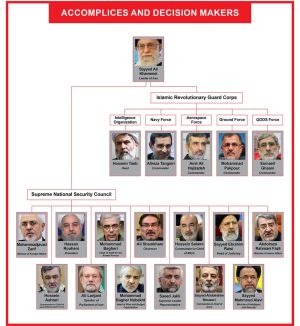
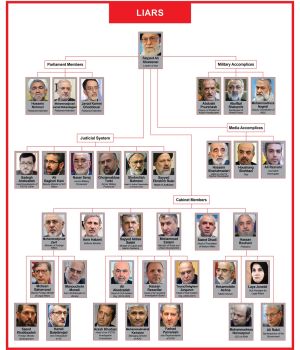
8.3 Findings of the Ontario Superior Court of Justice
On May 20, 2021, the Ontario Superior Court of Justice in Zarei v Iran (2021 ONSC 3377) gave its verdict on a motion brought forward by a group of families of the victims in Canada who had launched the lawsuit against the Islamic Republic of Iran and the IRGC for the downing of Flight PS752. The families had presented their submission to the court, alleging that the downing of Flight PS752 was intentional, and therefore, a terrorist activity. Iran was served the notice of claim, but chose not to appear to defend itself, resulting in a default judgment.
Upon hearing the available evidence at the time, Justice Belobaba sided with the plaintiff families of victims and found on the balance of probabilities that the downing of Flight PS752 was an intentional act of terrorism [184]. The case was significant in that an independent judicial body endorsed the calls of the families of victims who had for a long time claimed that the evidence suggests that the downing of Flight PS752 was not a result of a human error or a systemic failure.
Similar to their response to the letter of Dr. Callamard, the Iranian authorities quickly condemned the Ontario court’s ruling, calling it “shameful” [185]. While Iranian authorities claimed that the verdict lacked legitimate evidence, they offered no answers to some of the gaps and inconsistencies that were identified in the case.
8.4 Recommendations
The Association is seeking truth, justice, and accountability for the downing of Flight PS752. Several avenues should be pursued to that effect; these span both international and domestic legal mechanisms.
- 1. Demand Accountability via the International Civil Aviation Organization (ICAO) and International Court of Justice (ICJ)
Canada should refer Iran’s breaches of the Convention on International Civil Aviation, also known as the Chicago Convention, to the Council of the International Civil Aviation Organization (ICAO), per Article 84, as negotiations with Iran have come to a standstill. According to Article 3 bis of the Convention, “every State must refrain from resorting to the use of weapons against civil aircraft in flight.” Additionally, the Chicago Convention imposes an obligation on Iran to conduct a full inquiry into the downing (see Article 26 and Annexes 9 and 13) and allow for observers from Ukraine, the state in which the aircraft was registered, to be present throughout.
Contrary to those requirements, Iran has resorted to the use of weapons against a civil aircraft in flight and has failed to conduct a transparent and complete investigation, in contravention of Articles 3 bis, Article 26, and Annexes 9 and 13. As discussed in detail above, many questions remain unanswered by Iran, including those posed by Dr. Agnès Callamard and the Honourable Ralph Goodale. Iran’s final AAIB report fails to provide a full accounting of the causes and contributing factors to the downing of PS752.
Per Article 87 of the Chicago Convention, if the ICAO Council decides that a particular airline is not conforming to a final decision, all States Parties will be obliged to disallow the operation of that airline over their airspaces. Per Article 88, if the Council decides that Iran is not conforming, the Assembly is obliged to suspend Iran’s voting power in both the Assembly and the Council. These provisions of the Chicago Convention provide useful enforcement mechanisms and further reinforce the utility of seeking redress through the ICAO. Canada can appeal ICAO’s final decision to the International Court of Justice (ICJ).
The Convention for the Suppression of Unlawful Acts Against the Safety of Civil Aviation, also known as the Montreal Convention, imposes obligations on certain States Parties to initiate criminal proceedings against Iranian officials involved in endangering and destroying Flight PS752 (Article 6). The Montreal Convention further imposes on States the obligation to report as promptly as possible any information relating to the offenses (Article 13). Canada should submit this case to arbitration and, if arbitration does not proceed within six months, refer the case to the International Court of Justice.
The ICJ is further entitled to provide advisory opinions on legal questions referred to it by authorized UN organs and agencies, without a State’s consent. An advisory opinion is not binding, but it often carries persuasive weight. In addition to seeking recourse at the ICJ via the Chicago Convention and/or Montreal Convention, an advisory opinion may be sought from the ICJ on the various breaches of international law outlined above. The ICAO or General Assembly are appropriate forums in which Canada can lobby States to seek an advisory opinion from the ICJ, where a simple majority is likely sufficient [186].³⁰
- 2. Launch Domestic Criminal Investigation and Prosecutions in Canada
Subject to the discretion of the Attorney General and Public Prosecution Service of Canada, Canada’s Crimes Against Humanity and War Crimes Act (CAHWA), as well as sections 7(2)(c) and 77(c) of the Canadian Criminal Code provide grounds to open a criminal investigation and bring charges in Canada against any Iranian official responsible for the shooting down of PS752.
The Royal Canadian Mounted Police’s (RCMP) Sensitive and International Investigations Unit (SII Unit) should open a criminal investigation into the downing of Flight PS752. For full details on opening an investigation and prosecutions in Canada for international crimes visit “Universal Jurisdiction: Law and Practice in Canada” [187]. The RCMP SII Unit should use all the tools at its disposal to collect evidence and testimony in Canada and abroad. The Department of Justice’s Crimes Against Humanity and War Crimes Section (DOJ WAHWC), the Public Prosecution Service of Canada (PPSC) and related government departments, should provide the necessary assistance to carry out the investigation, including seeking access to evidence in Iran. The DOJ WAHWC can then prepare a final report recommending charges for the PPSC, which, in turn, can recommend that the Attorney General lay charges. The RCMP or Attorney General can then request that a superior court issue arrest warrants, pursuant to 507(1)(b) of the Criminal Code. The downing of PS752 involved crimes of an exceptional gravity perpetrated against Canadian citizens and permanent residents. The authorities must consider the significance of the public interest and attention on opening an investigation into these crimes—decisions which will have a serious impact on the public’s confidence in the administration of justice.
Canadian authorities should also work closely with their Ukrainian counterparts in common cause on this investigation. Further, other countries with universal jurisdiction laws should open investigations and consider launching prosecutions for atrocity crimes, namely war crimes or crimes against humanity.
- 3. Pursue the PS752 Case at the International Criminal Court
The most feasible way of bringing the situation to the International Criminal Court (ICC) is by way of Ukraine lodging a declaration accepting the Court’s jurisdiction, pursuant to Article 12(3) of the Rome Statute. Ukraine can establish such jurisdiction in accordance with Article 12(2)(b) since the downing of PS752 may arguably be considered a “crime [that] was committed on board a vessel or aircraft, the State of registration of that vessel or aircraft.” In the alternative, the UN Security Council can refer the situation to the ICC.
The Prosecutor of the International Criminal Court can then open a preliminary examination to determine whether to pursue an investigation. If the prosecutor opens a preliminary examination on his own initiative, he would ultimately need authorization by a Pre-Trial Chamber to launch an investigation (the second stage). If the prosecutor opens a preliminary examination based on a state party referral or referral by the UN Security Council, this authorization would not be needed. In any case, if and when an investigation proceeds, the prosecutor could prosecute those responsible for crimes against humanity or war crimes involved in the downing of PS752.
In this context, there are credible grounds for the ICC to exercise jurisdiction over the potential war crimes of attacking civilians, using the presence of civilians to advance a military objective, pillaging, and outrages upon personal dignity, as per Rome Statute Article 8(2)(b)(i) and 8(2)(b)(xxiii), or the crimes against humanity of murder and other inhumane acts (or imprisonment and torture in the aftermath), as part of a widespread or systematic attack directed against a civilian population, with knowledge of the attack, or pursuant to a State or organizational policy to commit such attack. An in-depth inquiry into the perpetrators’ mental states, or mens rea, is not required at this early stage in referring the situation for a preliminary examination, long before a suspect reaches the court.
The scope of such a preliminary examination should include the principle of command responsibility, which means that military commanders or superiors may be held responsible for the international crimes of their subordinates if certain parameters are met. These parameters vary slightly, per Article 28 of the Rome Statute, depending on whether the person is a military commander or a superior. But in general, the requirements can be described in three prongs. First, the military commander or superior must have failed to exercise control properly over their subordinate. Second, the military commander or superior must have known, or been criminally negligent in failing to know, that the person was about to commit or was committing an international crime. Third, the military commander or superior must subsequently have failed to take, as soon as practicable, all necessary and reasonable measures within their power to prevent or repress the commission of the offence, or the further commission of offences, or to submit the matter to the competent authorities for investigation and prosecution.
Thus, the Office of the Prosecutor should open a preliminary examination into the matter, to determine if an investigation should be pursued into the downing of Flight PS752 by Iranian officials.
- 4. Use UN Human Rights Institutions to Demand Answers and Accountability
The UN Human Rights Council should promptly mandate an international and impartial investigation into the downing of PS752 to promote accountability for the serious violations of international humanitarian law and international human rights law relating thereto, given the failures of Iran’s domestic system designed to protect those most responsible.
On February 23, 2021, the UN Special Procedures released Dr. Callamard’s detailed report into the downing, posing 26 key lingering questions, along with a press release detailing the contradictions in Iran’s version of events and its human rights violations throughout [188].³¹ As a result, two weeks later, on March 8, 2021, Iran issued a woefully inadequate and distorted response that contradicts its own AAIB report [189].³²
In over eight months, the UN Special Procedures have yet to issue a response to Iran’s nonsensical account and attempt to pin all responsibility on a single low-level ADU operator. The Special Procedures should ensure that Dr. Callamard’s report and findings are adhered to by promptly calling for an impartial, independent, and comprehensive investigation through the Human Rights Council.
In addition, countries should persistently deliver oral statements before the UNHRC, seeking truth, justice, and accountability for the victims.
- 5. Impose Magnitsky Sanctions on Iranian Officials responsible for PS752 Rights Violations
Magnitsky Laws enable the imposition of sanctions on specific foreign nationals who have engaged in significant corruption or gross human rights violations. The law allows the government to impose asset freezes, travel restrictions, and prohibit persons from conducting business with or providing services that benefit sanctioned officials. The Government of Canada should coordinate with allies with similar laws to sanction Iranian officials responsible for the downing of Flight PS752 and the repression in its aftermath, including the violent suppression of protests, torture in detention, arbitrary detention of peaceful protesters, and violations of the rights of the bereaved. The list of the involved individuals is provided in Section 8.2 of the report.
- 6. Pass Human Shields Legislation and Hold Iranian Officials Responsible for Use of Human Shields
The term “human shields” refers to a war crime under the Geneva Conventions and the ICC’s Rome Statute, in which civilians are used to advance military objectives. In the context of heightened armed hostilities with the US and following an attack on US military bases in Iraq, Iranian officials left the country’s airspace open and stationed ADUs in the vicinity of an international airport in anticipation of a US counterstrike, at a minimum, using the presence of civilian aircraft to advance military objectives, and resulting in the murder of 176 victims and an unborn child. Although the crime under international law is well-established, there is growing, widespread recognition that domestic legislation is needed to effectively deter the use of civilians as human shields by both state and non-state actors.
Only the US has so far passed domestic legislation on this subject. In December 2018, the US passed the Sanctioning the Use of Civilians as Defenceless Shields Act, which imposes sanctions on foreign persons using civilians as human shields. The US legislation, and the international consensus it embodies, generated the first-ever resolution by the UN General Assembly that specifically condemned use of human shields. NATO was also inspired to act. In March 2019, the NATO Supreme Allied Commander sent a letter urging all NATO Member Nations to take similar domestic steps to counter use of human shields. States including Canada should pass similar domestic legislation to deter and sanction the Iranian officials responsible for the use of human shields [190].
³⁰ See https://www.icj-cij.org/en/organs-agencies-authorized.
³¹ https://www.ohchr.org/EN/NewsEvents/Pages/DisplayNews.aspx?LangID=E&NewsID=26782
³² https://www.ohchr.org/EN/NewsEvents/Pages/DisplayNews.aspx?NewsID=26782&LangID=E
APPENDICES
Appendix A – Leaked Audio File from a Top Iranian Official
In 2020 shortly after the downing of PS752, one of top Iranian officials, had a private meeting regarding it. The Association possesses the audio file of this meeting.
In this meeting, he explains that managing the Iranian airspace is under the control of the “Tehran [Area] Control Center” which works closely with the country’s air defence systems. He says that when military operations are carried out, the air defence system, in coordination with the country’s “Tehran [Area] Control Center controls the country’s airspace and this was done that night. He continues to say that the first news related to PS752 came from the Ukraine government which said that the flight was downed by Russian missiles. We wonder how five other flights carried along the same flight path, after the Tor-M1 system had been positioned without anything happening and why PS752 was the only one targeted.
In regard to why the airspace was kept open, he says that around 3:30AM (January 8th), any aircraft that had turned on its engine and was set to depart had to inform the country’s Air Defence Network and Flight PS752 had done just that. The flight had done everything correctly.
He also says that after the downing, in order to know what kind of explosive material was on the plane (whether it was a missile or a bomb), parts of the aircraft were sent to the Atomic Energy Organization of Iran and a few other laboratories to test for explosive material. This takes a while but in the middle of February, the results came back indicating that there was no other explosive material on the plane and that it was only explosive material from the missile. He says that for us, there is also a big question as to how a passenger airplane can be shot down given that there were other flights after the repositioning of the Tor-M1 unit. He says that Iran’s prosecutor, Gholam Abbas Torki, is also looking to see what was going on with or inside the plane and analyzing the black box to figure this out.
Another point he emphasizes is that the country’s Air Defence Network is under the Artesh (conventional military) and the IRGC. Artesh controls the mid to high altitude systems while the IRGC controls the low to mid altitude systems and they work in coordination with one another. He says that it is not clear why the Tor-M1 system was placed outside of the airport that night and was not linked to the country’s Air Defence Network.
He also talks about why there are no remains of seats of the aircraft. He says that because the material was made out of “composite” they had burned and were destroyed. The question remains as to why passports and many of the passengers’ belongings remained in good condition. How can it be that airplane seat material is something that easily burns but passports and other belongings seem flame resistant?
Appendix B – Leaked Audio File of Iran’s Foreign Minister
In 2020 shortly after the downing of PS752, the former Iran’s foreign minister, Javad Zarif, had a private meeting regarding the PS752. The Association possesses the audio file of this meeting.
In the meeting, he says that around 11:00AM on Friday January 10th, 2020, a meeting was held with the Supreme National Security Council where Mr. Ali Shamkhani (Secretary of the Supreme National Security Council), Mr. Mohammad Bagheri (IRGC Commander) and Mr. Mohammad Eslami (Transport Minister of Iran). In the meeting, Mr. Shamkhani and Bagheri emphasized that the government must tell the public that the PS752 has crashed due to technical issues. In this meeting, Javad Zarif responds by saying that this may not be the case. He said that if they wanted him to publicly say this was a technical issue, the Armed Forces of the Islamic Republic of Iran must issue a public statement saying it was mechanical failure and then he would publicly back this. Otherwise, he refused to say it was a mechanical failure.
At 10:00PM, there was a meeting with the Supreme National Security Council where Hassan Rouhani (Iran’s president) was also present. They then decided how to announce that PS752 was shot down by IRGC missiles. A statement was made on behalf of the Armed Forces of the Islamic Republic of Iran about the downing of Flight PS752 which became public at 7:00AM the following morning (Saturday January 11th). During this meeting, the IRGC members and the Foundation of Martyrs and Veterans members were summoned and assigned to contact and visit the grieving families. If what Zarif said was true, this demonstrates lies and deceit from Mr. Shamkhani and Bagheri as representatives of the IRGC, to Zarif as Iran’s Foreign Minister. It also shows that they put him under pressure to prematurely back the mechanical failure claim, but he did not do so. Zarif also suggests that Ali Abedzadeh, the head of Iran’s Aircraft Accident Investigation Bureau (AAIB) was under pressure from the IRGC to claim mechanical failure as the reason for the downing of PS752. Zarif also says that nothing will come out of the black boxes; they would only provide information about the flight and cannot provide any evidence on whether it was shot down intentionally or not. He mentions this a few times, that the black box cannot confirm intentionality behind the downing. He even says that it is possible that a few people infiltrated and intentionally shot down PS752, but we will never be able to find out. It may also be the result of jamming of the radar. They will never tell us. He says that Iran’s Armed Forces and the IRGC will never tell us or anyone else. This may remain a mystery forever because in exposing the truth, the government of Iran may be putting its national security at risk. Zarif says that it is very likely that the truth will never be revealed because all around the world, elements of countries’ national defence are shrouded in secrecy.
Javad Zarif says that he tried his best for this case to get somewhere but unfortunately this has not happened. He even resigned to the Leader of the government, but his resignation was not accepted, and they won’t let him leave.
Appendix C – Leaked Audio File of the Head of Iran’s AAIB
In July 2020, a CBC article reported about a leaked audio file of the Head of AAIB [185]. The audio file reveals a number of damning details about the downing of the plane and the full cooperation of the chair of Iran’s AAIB with IRGC.
This file is a recording of a conversation between Hassan Rezaeifar and Javad Soleimani, who lost his wife Elnaz Nabiyi on the flight. Rezaeifar tells Soleimani that the Supreme National Security Council was responsible for leaving the airspace open on the night of January 8, 2020. He further explains that the reason for not closing the airspace was to prevent the exposure of the IRGC’s plan to attack the American bases in Iraq. In this conversation, Rezaeifar asks Javad Soleimani to meet with him in person in Iran, but he refuses. Then, Rezaeifar suggests that they meet in France, but again Soleimani rejects the invitation. In the end, Rezaeifar asks Soleimani to delete his Instagram post in which he criticizes the Islamic Republic of Iran. Immediately after learning of such an audio file, the Iranian government removed Hassan Rezaeifar from his post as the head of the Ukrainian Airlines Flight Investigation Commission and replaced him with Arash Khodaei.
Thomas Juneau, an associate professor of international affairs at the University of Ottawa and former analyst of Middle East affairs, said Iran has been insisting the investigation will be independent — and the audio recording proves it's not. Juneau said it's "totally inappropriate" and "absurd" for the lead crash investigator to put pressure on a victim's family member in Canada. He also said it's not surprising.
Payam Akhavan, a former UN prosecutor at The Hague, also reviewed CBC's copy of the recording. Akhavan argues the audio is a new piece of evidence showing the highest levels of Iran's government chose to keep planes full of people in the sky on a day of intense military activity. "The senior leadership of the government willingly and knowingly disregarded these risks," said Akhavan. "This is not just a question of human error or mistake. It's a question of criminal recklessness.” Akhavan also said the audio implicates the investigation team in a cover-up.
Ralph Goodale, Canada's special adviser to the Trudeau government on the Flight 752 file, said the phone call “constitutes outrageous behaviour.” “It's wrong on every count of procedure, propriety, appropriateness. It's simply completely wrong," he said.
Appendix D – Legal and Judicial Process of Aviation Crashes Investigations in Iran
Shargh Newspaper - News code: 266302 (Date: June 20, 2020)
“Shargh” explains the legal and judicial process of aviation crashes investigations
Shokoufeh Habibzadeh: An important part of the aviation industry is to have an independent investigative institution. This inquiry has been expressed by several different resources. According to Rule No. 90 of the Commission report, any aviation crash in any country must be investigated by an independent institution. Similar to first world countries, the investigation institution should be independent from the civil aviation organization (CAO.IRI), as well as the government. Its functions should be similar to those of the Supreme Audit Court of Iran, with the primary responsibility of investigating aviation, railroad, road, and marine accident investigations. The Chicago Convention’s Annex 13 also emphasizes the independence of the investigation institution. It further explains: “The investigation institution must be objective and unbiased. The institution also must function to investigate independently to prevent any potential external pressure and conflict”. It also clarifies further: “All countries must organize their investigation institution so that it can function completely independently from the country’s CAO.IRI or other organizations, so as to avoid any interference in their goals and investigations”. The most ideal method per Annex 13 of the Chicago Convention is to make the investigation institution independent from the CAO.IRI and to have them function under the supervision of the government or the parliament. In this method the investigation institution directly reports to the government or the parliament, but they are not a subdivision of any ministry. In the event that this ideal method cannot be achieved, then the investigation institution will need to organize in conjunction with the CAO.IRI and as a subdivision of the same ministry. According to Annex 13, the question arises if “the [Iranian] investigation institution needs independence?”. This institution appears to be neither independent nor free of external pressures. Two recent crashes provide clear examples. The first is the crash of the ATR Aseman, and the second is the downing of Ukraine International Airlines Flight PS752. Here, we are attempting to explain the independent process of aviation crash investigations from the experts' perspective. At first, we needed to look at what Hassan Rezaeifar, chief of the Aircraft Accident Investigation Board (AAIB) claimed. According to him, the final investigation report is not released to justify victims’ next of kin’s international legal rights. In fact, he is reluctant to respond to this question.
Court blocks release of the final investigation report
[Rezaeifar], the Chief of AAIB in response to “why the final investigation report of Aseman Airline, flying from Tehran to Yasuj, is not released” answers: “After the crash, two institutions from each branch of government joined the investigation per their assigned responsibilities. From the Legislative Branch, Construction Commission and Parliament rule No.90 Commission; from the Judicial Branch, the Attorney General and National Investigation Organization, and finally from the Executive CAO.IRI and Transportation Department joined as two agents of Iran Ministry of Roads & Urban Development to investigate the crash and oversee the investigation process. After the final investigation draft report was generated CAO.IRI almost concurrently received two inquiries, one from Parliament rule No.90 Commission and the other from the Prosecution Branch of Government Employees. Both inquiries were asking that the investigation draft report be neither finalized nor released in order to justify victims’ next of kin’s international legal rights. In response CAO.IRI explained reasons why they are required by ICAO regulations to release the report; however, due to disagreements only the annual report required by ICAO’s regulations was released. It is interesting that in the final draft of those two institutions [Parliament rule No.90 Commission and Prosecution Branch of Government Employees] there is no evidence of negligence or error on the part of the international community or the French manufacturer. and nothing was tracked to follow up. However, the investigation team briefly reported both the manufacturer’s errors and the international community’s negligence; it specifically mentioned the adverse effect of Int’l unfair sanctions against Iran [as causes of the incident]. The court case will hopefully provide justice to the families, and one unanimous decision will convince everyone". This authority’s claim obviously shows the dependency of this institution. Not only is it affected by the internal interference but also there are external conflicts. However, it is important not to overlook the CAO.IRI's violations, in addition to the fact that the crime ring's members run the organization and the institution's dependency has led judges to be more sensitive about releasing the Final Report.
Icing, the most important conflict
He [Rezaeifar] also continued: “ICAO has emphasized that the members of the crash investigation institution must be separate from the supervisor institution members who are involved in regulating the rules and overseeing the airplane manufacturer company. This is done in two methods in countries across the world. The first method is that the institution is independent from the CAO.IRI and relevant offices; however, few members of the CAO.IRI get involved. The second method is that the institution is within the CAO.IRI, but the investigators are independent from members who oversee the airplane manufacturer company. Also, in this method some independent members of the aviation industry are invited. We complied with the second method. Almost half of the countries across the world comply with this method. It helps to understand the matter if you look at the websites of aviation crashes all over the world”. He also continues with a considerable explanation: “It is interesting that CAO.IRI discussed separating the AAIB in parliament about three years ago and did the necessary collaboration to legislate the laws; however, changing the laws and regulations and creating necessary organizations require time, budget and national synchronization of all transportation routes”. I asked him about some examples indicating the Aviation Crash Investigation Institution independence and dependency. Defending the operation of the AAIB, Rezaeifar explained: "Some examples of how the institution acts independently are as follows: Most members of the AAIB and I have not been involved in supervising and issuing permits to airplanes or airplane companies. AAIB operates independently from supervision organizations who oversee the operations of aviation offices and airports. This institution independently operates under the supervision of the organization executive managers (Note: The organization executive managers are accused of being responsible for the ATR Aseman flight crash flying from Tehran to Yasuj). If you refer to our report, then you will understand all errors and deficiencies in both CAO.IRI. We have also made suggestions on how to correct them. We did not discuss the degree of fault for the entities involved, which does not fall under our ICAO's responsibilities.”.
Irrespective of any excuse, not releasing the Final Report is unacceptable
To better understand the matter, we also interviewed Milad Sadeghi, aviation and aerospace legal rights researcher. He believes using victims’ next of kin’s international legal rights justifications as an excuse for not releasing the Final Report is not acceptable. He further explains: “per rule No. 38 Chicago convention, which defines fair conditions for countries complying international standards and arrangements, and per the attachment (ANX) No. 13 Chicago convention the answer to this question appears to be negative. Because the commitment or responsibility of the investigator country to release the Final Report as soon as possible and preferably within 12 months is defined as an absolute commitment or an absolute responsibility. Violations [of this responsibility] are not permitted under any circumstances. It does not make any difference if not releasing the Final Report becomes either temporary or permanent. Attachment to standard number 6.5 is crystal clear about this. Additionally, commitment to release a temporary announcement (standard NO. 6.6) must not be confused or replaced with the commitment of releasing the Final Report. Our country’s aviation authorities must not make mysterious, puzzled, and suspicious claims. Further clarification is required about this matter along with legal documents”. Sadeghi explains more about the dependency of the AAIB on CAO.IRI and compliance with ICAO’s rules:
He says: "The answer to this problem can be found in many aspects. In one aspect, Annex 13 of the Chicago Convention explicitly states that each government should establish an accident and crash investigation entity (organization/administration) which is independent of the national aviation authorities (organizations/administrations). This standard is a relatively new regulation; Because it’s one of the results of the 15th addendum (2016) of Annex 13. Despite such a standard and according to the ICAO, the accident investigation organization which emerged in the National Civil Aviation Authority Organization, won’t be considered as an independent accident investigation authority”.
The dark shadow of the CAO.IRI over the crash investigation process
He continues: "It should not be assumed that our Aviation Accident and Safety is a separate institution from the CAO.IRI. When discussing the activity of an office, committee or commission of an Aviation Accident and Safety organization, it is never an indication that the organization has the authority to investigate the safety of events. These titles are deceptive and misleading because in theory, they may indicate the existence or presence of an independent authority with a juridical nature distinct from the Civil Aviation Authority in investigation of the safety of the events. According to article 3 of the constitution of the (Civilian) Aviation Accident and Safety Investigation in Iran, the authority of the Civilian Aviation Accident and Safety Investigation is the CAO.IRI itself. The organization, which operates as an aviation supervisor and organizer and has been organizing and overseeing the events from the very beginning is the same entity that is responsible for organizing, conducting, and controlling the investigation of the crash or accident that happened under their supervision”.
The pronouncement of lack of independency by the Office of Prosecutor for Government Employees
This aerospace researcher considers not publishing the Final Report of the Tehran-Yasuj plane crash as the lack of independence from that office, and continues: “Now, the CAO.IRI has not published the Final Report at the request of the Parliament and Judiciary, and as it’s quoted and reported in the news, earlier Office of Prosecutor for Government Employees blocked the publication and submission of the temporary accident declaration to ICAO. The meaning of the latest action of the Office of Prosecutor for Government Employees blocking the publishing and submitting a temporary accident report is clear and does not need much explanation. Not publishing and avoiding sending the temporary accident report to ICAO, is a pronouncement of the lack or at least the weakness of operative independence of CAO.IRI “.
A failure to publish the Final Report: a threat to aviation safety
He added: “The request of the parliament and the judiciary system is not truthfully only a simple request or asking; but, in fact, it is an order and a command. Therefore, the organization has found itself compelled to obey it. Such perception and interpretation prove the lack or at least the weakness of operative independence of CAO.IRI. However, assuming that the organization independently decided not to publish the Final Report temporarily, CAO.IRI is facing another criticism. By deciding not to publish the final draft report, the organization has taken a step contrary to the purpose of Aviation Safety Investigation. We know that one of the specific goals or motivations for publishing the Final Report is to prevent or help to prevent the recurrence of such accidents or incidents. It is precisely for this reason that the safety of air crashes without the publication of a Final Report, even temporarily, will not only be incomplete, but also pose a threat to the safety of the aircraft. So, you can obviously see, how much could be done with a goal-oriented approach to the law and to what extent is this approach effective in properly presenting legal interpretations and judging issues”. Mr. Sadeghi, with looking at Europe's performance in the operational independence of the aviation accidents investigation, adds: “The Safety Inspection Authority must not seek or accept the orders (extraterrestrial) of someone in the implementation of the safety inspection, and must have unlimited authority (domination/control) over the conduct of safety investigations”. He goes on to recall: “Some people think that independence can only be achieved by structurally or administratively separating the inspection unit from other aviation industry actors and beneficiaries, whereas it is not enough at all, and independence has many aspects”. I ask him if these international laws contradict the entry of the judiciary and the oversight department of the parliament, like the Rule No. 90 of the Commission, in the process of investigating the accident. He answers: “Obviously, inspection and investigation on complex topics such as aviation crash requires expertise and knowledge. Also, the inspection and investigation of air accidents should not be considered as limited to safety or technical inspection. Another important aspect that must be considered is an investigation that focuses on justice. Keeping both investigations separate, each with its own purpose, or at least avoiding heavy conflict between them is important. Our current laws have not been able to handle this issue and has caused intense friction between those investigations”.
As this expert points out, establishing independence over accident investigation requires a legal revolution: “I have no hope of amending the law to create an independent investigation authority. Change is possible when the basics and requirements of a safety investigation are in place. I strongly believe that a legal revolution must take place in this regard. A revolution for the dismantling of non-technical shows of criminal prosecutions of unintentional air crashes to the establishment of a non-political, specialized, and non-affiliated organization in order to review the safety of aviation events and even all transportation events and other industrial events. Of course, to accomplish this goal, the legislation will not get anywhere unless it benefits from the elites and experts in the aviation industry and consults with them regularly”.
The Influence of the CAO.IRI and other authorities on the investigation institution
A well-informed source in the CAO.IRI also points to some legal provisions in the process of investigating air accidents: ”According to the documents of Annex and documents 9756 and 9962 and the framework of the Iranian legislation, the institution for investigating accidents can have the following situations: ”First, an institution that is subordinate to the Islamic Consultative Assembly; Second, an institution subordinate to the government or vice presidents; Third, an institution subordinate of one of the ministries. Furthermore, the institution cannot be: First, the subordinate of the judiciary due to inconsistency with the purpose; Second, subordinate of the CAO.IRI due to lack of performance independence”. He concludes: “So now, that the aviation accident inspection body is a subsidiary of the CAO.IRI, it is not complying with ICAO’s regulations, though it is in accordance with Iran's rules and regulations”. He explicitly states: It is not unlikely that other institutions get involved with the accidents, which is why ICAO has considered this in the regulations. In the other words, ICAO has acknowledged that the countries have the right to seek accountability, and perhaps police may join the investigation of the accidents. That's why ICAO has said that, first, the authorities must not interfere in the investigation of the accident and should not prevent them from reporting, and secondly, the inspectors of the crash investigation team must not be inspectors of such other authorities and organizations. To better achieve this goal, ICAO has asked countries that during establishing law, treaty, or cooperation memorandum (based on internal regulations); they must predict and resolve this problem so that the organizations won’t negatively influence the procedure of the accident investigations. How to maintain and decrypt the devices of audio recorder and data recorder (FDR and CVR), accessibility to the crash site, and also declaration of the reports of accidents, are among the specific cases that countries need to resolve with other authorities, including the judiciary system. Unfortunately, this issue has never been resolved in Iran and perhaps one of the main causes of the judiciary's confrontation with the investigation of accidents, is this lack of mutual commitment to cooperation. The commands that prohibited publishing the Final Report of the Yasuj accident and also the numerous tensions over reading the FDR and CVR devices of the Ukrainian plane crash, show that the accident investigation committee is affected not only by the Civil Aviation Organization but also by other authorities”.
Appendix E – The Belarusian Incident - Ryanair Flight 4978
On May 23, 2021, Ryanair flight FR4978 was flying from Athens, the capital of Greece to Vilnius in Lithuania when it made a sudden change of course over the Belarusian airspace near its final destination. The flight was diverted and escorted by a Belarusian fighter jet to Minsk airport where two of its passengers were detained by Belarusian authorities.
Michael O'Leary, the CEO of Ryanair described a series of events that led to the incident. According to him, Minsk air traffic control informed the pilot of a credible threat that if he did not follow the Belarusian authorities would order a bomb would be detonated on board. After the bomb threat came through, the pilot repeatedly requested to speak to Ryanair's operations control center, but Minsk didn’t allow it, giving false excuses that Ryanair in Poland was not answering the phone. As Mr. O'Leary concluded, the pilot was given no option but to land in Minsk. After the aircraft was brought down using Minsk Air Traffic Control, two of its passengers, journalist Roman Protasevich and his girlfriend Sofia Sapega, were arrested [191].
The journalist who was arrested at Minsk airport was an opponent of Belarussian dictator Lukashenko. After this incident, Britain and all EU countries strongly condemned Belarus' behavior. ICAO held an emergency meeting on this incident, a research team was formed at ICAO, and Belarus Airlines have been banned from flying to the European Union. Belarus' behavior deserves such punishment, and the incident must be thoroughly investigated, but compare this reaction with the behavior of the European Union, ICAO, and the airlines with regards to the crime of downing a flight that killed 176 people and one unborn child, which was discussed in the International Reactions section of this report.
Appendix F – List of Arrested and Imprisoned Protesters
Shared references: [141]; [145]
- 1. Mostafa Hashemizadeh
A civil engineering student at the University of Tehran, sentenced to five years in prison on a charge of “assembly and collusion to disrupt national security.”, and also, three months of public service at a mental hospital, and 74 lashes, and banned from entering the university dormitory for two years due to “disrupting public order.” Mostafa Hashemizadeh was pressured to make false confessions during the interrogation. The interrogator threatened to kill him by air injection and abandon his body in a remote location if he did not collaborate with them. Another time, the interrogator threatened to kill him the next morning if he did not confess to what they wanted.
Current Detention Status: Released, Sentence Completed.
Resources:
Mostafa Hashemizadeh - Arrested in Relation to Demonstrations — Iran Prison Atlas (united4iran.org)
- 2. Amir Mohammad Sharifi
A University of Tehran student who attended the protests, was arrested in February 2020, and was sentenced to six months in prison for engaging in “propaganda against the state.” Sharifi said the charge stemmed from his taking photos of plainclothes officers entering the university dorm and taking away the belongings of Mostafa Hashemizadeh and posting the photos on Twitter. A few days after his arrest, the security head of University of Tehran announced “attendance in protests” as the reason for his arrest.
Current Detention Status: In Prison, Sentence Confirmed.
Resources:
Amir Mohammad Sharifi - Participation in Public Gatherings — Iran Prison Atlas (united4iran.org)
- 3. Moein Zareian
A sociology student at the University of Tehran and a member of the dormitory guild council, was also detained for four days and released on bail. The security head of the University of Tehran announced “attendance in protests” as the reason for his arrest.
Current Detention Status: Released on bail.
Resource:
https://www.bbc.com/persian/iran-features-55586790
- 4. Mohsen Rezai
From Amol, attended the protests, and was sentenced to six months in prison due to “propaganda against the state.”
Current Detention Status: Released, Convicted by Court.
Resource:
https://ipa.united4iran.org/en/prisoner/5970/
- 5. Meisam Khalili
From Amol, attended the protests, and was sentenced to six months in prison due to “propaganda against the state.”
Current Detention Status: Released, Convicted by Court.
Resource:
https://ipa.united4iran.org/en/prisoner/5962/
- 6. Shora Fekri
From Amol, attended the protests, and was sentenced to six months in prison due to “propaganda against the state.”
Current Detention Status: Released, Sentence Completed.
Resource:
Shora Fekri - Arrested in Relation to Demonstrations — Iran Prison Atlas (united4iran.org)
- 7. Salman Farrokhi
From Amol, attended the protests, and was sentenced to six months in prison due to “propaganda against the state.”
Current Detention Status: Released, Convicted by Court.
Resource: Salman Farrokhi - Arrested in Relation to Demonstrations — Iran Prison Atlas (united4iran.org)
- 8. Unknown (Mehdi?) Raei
From Amol, attended the protests, and was sentenced to six months in prison due to “propaganda against the state.”
Current Detention Status: Released, Convicted by Court.
Resource:
Unknown Raei - Arrested in Relation to Demonstrations — Iran Prison Atlas (united4iran.org)
- 9. Bahareh Hedayat
A graduate student in Political Science at Tehran university and a former member of the Central Council for the Consolidation of Unity. Bahareh Hedayat described her arrest on Twitter. On the day of her arrest, Ms. Hedayat went to university security. The woman, who introduced herself as the university's security guard, wanted to give Ms. Hedayat some "advice". Three officers arrested Ms. Hedayat after she left the security building. She asked the officers to provide a legal warrant. Arguments broke out between her and security forces due to the officers' refusal to give the warrant. Officers beat her and bent her head towards the car's floor so that she could not physically react. Eventually, officers provide the arrest warrant. According to the warrant, Branch 4 of the Evin prosecutor's office had issued an arrest permit and a search of her home. According to (Iran Prison Atlas) IPA, Bahareh Hedayat was sentenced to prison for protesting the shooting down of the Ukrainian plane. Her sentence was issued by Branch 26 of the Revolutionary Court, presided over by Judge Iman Afshari.
According to the indictment contents, Ms. Hedayat was sentenced to four years in prison on the charge of "Assembly and collusion against the national security" for her protesting the shooting down of the Ukrainian plane, and to eight months in jail on the charge of "propaganda against the system" for her activities on Twitter. The court also imposed two additional sentences: "Two years ban on membership in parties and three months of forced labor in a sanitarium. Under Article 134, four years of imprisonment and additional sentences will be enforceable for her.
Current Detention Status: Released, Convicted by Court.
Resources:
Bahareh Hedayat - Pro-democracy Activist — Iran Prison Atlas (united4iran.org)
- 10. Ali Nourizad
The son of the political prisoner, Mohammad Noorizad, from Tehran, he attended the protests, and was charged to three years and six months in prison due to “propaganda against the state and assembling and colluding to act against national security. According to IPA, Branch 26 of Tehran Revolutionary Court has sentenced Ali Nourizad to three years and six months in prison on the charge of "Gathering and planning against national security" and eight months in prison for "propaganda against the system." He has been acquitted of "insulting the leadership" due to the lack of sufficient documents provided by judicial officers. "Media Activity in the intention of Opposite Media" and "attending the mourning rally for the victims of the Ukrainian plane crash" are indicated as examples of his charges. By applying Article 134, five years of his sentence will be enforceable. Mohammad Hossein Aghassi, the family’s attorney, reported that Ali was transferred to Fashafooyeh prison for his sentence enforcement.
Current Detention Status: In Prison, Sentence Confirmed. Resources:
Ali Nourizad - Arrested in Relation to Demonstrations — Iran Prison Atlas (united4iran.org)
- 11. Fereshteh Mahmoudi
From Amol, Fereshteh Mahmoudi attended the protests, and was charged to eight months in prison due to “propaganda against the state.” Additionally, the criminal court of Amol has sentenced her to five months in prison and 20 lashes for “disrupting national security”. Her sentence by the criminal court of Amol is suspended for one year.
Current Detention Status: Released, Convicted by Court.
Resources:
Fereshteh Mahmoudi - Arrested in Relation to Demonstrations — Iran Prison Atlas (united4iran.org)
- 12. Amin Forouhi
From Amol, Amin Forouhi attended the protests, and was charged to eight months in prison due to “propaganda against the state.” Additionally, the criminal court of Amol has sentenced him to five months in prison and 20 lashes for “disrupting national security”. His sentence by the criminal court of Amol is suspended for one year.
Current Detention Status: Released, Convicted by Court.
Resources:
Amin Forouhi - Arrested in Relation to Demonstrations — Iran Prison Atlas (united4iran.org)
- 13. Ali Shokri
From Amol, Ali Shokri attended the protests, and was charged to eight months in prison due to “propaganda against the state.” Additionally, the criminal court of Amol has sentenced him to five months in prison and 20 lashes for “disrupting national security”. His sentence by the criminal court of Amol is suspended for one year.
Current Detention Status: Released, Convicted by Court.
Resources:
Ali Shokri - Arrested in Relation to Demonstrations — Iran Prison Atlas (united4iran.org)
- 14. Azadeh Javani
From Amol, Ms. Javani attended the protests, and was charged to eight months in prison due to “propaganda against the state.” Additionally, the criminal court of Amol has sentenced her to five months in prison and 20 lashes for “disrupting national security”. Her sentence by the criminal court of Amol is suspended for one year.
Current Detention Status: Released, Convicted by Court.
Resources:
Azadeh Javani - Arrested in Relation to Demonstrations — Iran Prison Atlas (united4iran.org)
- 15. Aydin Javani
From Amol, Mr. Javani attended the protests, and was charged to eight months in prison due to “propaganda against the state.” Additionally, the criminal court of Amol has sentenced him to five months in prison and 20 lashes for “disrupting national security”. His sentence by the criminal court of Amol is suspended for one year. Current Detention Status: Released, Convicted by Court.
Resources:
Aydin Javani - Arrested in Relation to Demonstrations — Iran Prison Atlas (united4iran.org)
- 16. Ayda Javani
From Amol, Ayda attended the protests, and was charged to eight months in prison due to “propaganda against the state.” Additionally, the criminal court of Amol has sentenced her to five months in prison and 20 lashes for “disrupting national security”. Her sentence by the criminal court of Amol is suspended for one year.
Current Detention Status: Released, Convicted by Court.
Resources:
Aida Javani - Arrested in Relation to Demonstrations — Iran Prison Atlas (united4iran.org)
- 17. Alireza Mohammad Nejad
From Amol, he attended the protests, and was charged to eight months in prison due to “propaganda against the state.” Additionally, the criminal court of Amol has sentenced him to five months in prison and 20 lashes for “disrupting national security”. His sentence by the criminal court of Amol is suspended for one year.
Current Detention Status: Released, Convicted by Court.
Resources:
- 18. Hossein Mostafania
From Amol, Hossein attended the protests, and was charged to eight months in prison due to “propaganda against the state.” Additionally, the criminal court of Amol has sentenced him to five months in prison and 20 lashes for “disrupting national security”. His sentence by the criminal court of Amol is suspended for one year.
Current Detention Status: Released, Convicted by Court.
Resources:
Hossein Mostafania - Arrested in Relation to Demonstrations — Iran Prison Atlas (united4iran.org)
- 19. Meysam Khodabandehlou
From Amol, he attended the protests, and was charged to eight months in prison due to “propaganda against the state.” Additionally, the criminal court of Amol has sentenced him to five months in prison and 20 lashes for “disrupting national security”. His sentence by the criminal court of Amol is suspended for one year.
Current Detention Status: Released, Convicted by Court.
Resources:
Meysam Khodabandehlou - Arrested in Relation to Demonstrations — Iran Prison Atlas (united4iran.org)
- 20. Hamid Mohammadi Irani
From Amol, Mr. Irani attended the protests, and was charged to eight months in prison due to “propaganda against the state.” Additionally, the criminal court of Amol has sentenced him to five months in prison and 20 lashes for “disrupting national security”. His sentence by the criminal court of Amol is suspended for one year.
Current Detention Status: Released, Convicted by Court.
Resources:
Hamid Mohammadi - Arrested in Relation to Demonstrations — Iran Prison Atlas (united4iran.org)
- 21. Mohammadreza Shojaei
From Amol, he attended the protests, and was charged to eight months in prison due to “propaganda against the state.” Additionally, the criminal court of Amol has sentenced him to five months in prison and 20 lashes for “disrupting national security”. His sentence by the criminal court of Amol is suspended for one year.
Current Detention Status: Released, Convicted by Court.
Resources:
Mohammad Reza Shojaei - Arrested in Relation to Demonstrations — Iran Prison Atlas (united4iran.org)
- 22. Fatemeh (Mari) Mohammadi
From Tehran, Fatemeh attended the protests, and was charged to three months in prison & 10 lashes, due to “disrupting public order.”
01/12/2020 - Mari Mohammadi was arrested. She was arrested near Azadi Square over the Ukrainian Plane shot down by the IRGC. She was beaten and tortured physically and psychologically during her arrest in the Security Police detention center. The marks of torture were visible up to a week after Mrs. Mohammadi's arrest. Moreover, police forced her to get naked under the pretext of physical inspection. Some people who were in the mentioned detention center before claimed that this is done in front of CCTV cameras.
04/22/2020 - According to Mohabbat News, branch 1167 of the Tehran General Court sentenced Mari Mohammadi to three months and one day in prison and 10 lashes on the charge of "disturbing public order." It seems that the court has failed to provide sufficient evidence to prove this accusation and the judge questioned Mrs. Mohammadi about her reason for believing in Christianity. Fatemeh Mohammadi did not protest the decision and said: I refused to object to the verdict considering that the appeals courts were predetermined.
Her sentence is suspended for one year.
Current Detention Status: Released, Sentence Confirmed.
Resources:
Fatemeh Mohammadi - Arrested in Relation to Demonstrations — Iran Prison Atlas (united4iran.org)
https://www.bbc.com/persian/iran-features-55586790
- 23. Farhad Bakhshi
From Tehran, Mr. Bakhshi attended the protests, and was charged to six months in prison due to “Assembling and colluding to act against national security - Art. 610 IPC.” According to RadioZamaneh, Branch 26 of Tehran Revolutionary Court, presided over by Judge Afshari, sentenced Farhad Bakhshi to six months in prison on the charge of "collusion and gathering to act against national security", A month of mandatory activities in Basij Organization, and writing 90-page manuscript research on the Vincennes warship.
Current Detention Status: Released, Sentence Completed.
Resources:
Farhad Bakhshi - Arrested in Relation to Demonstrations — Iran Prison Atlas (united4iran.org)
https://www.bbc.com/persian/iran-features-55586790
- 24. Sina Rabiei
A student at University of Tehran, he attended the protests, and was sentenced to three years in prison. Hossein Taj, his attorney, tweeted that the judge has changed Sina’s charge from “disrupting national security” to “Assembling and colluding to act against national security - Art. 610 IPC.” and has sentenced him to three years in prison.
Current Detention Status: Released, Convicted by Court.
Resources:
Sina Rabiei - Arrested in Relation to Demonstrations — Iran Prison Atlas (united4iran.org)
https://www.bbc.com/persian/iran-features-55586790
- 25. Roghayeh Bigdeli
From Karaj, Roghayeh attended the protests, and was sentenced to 'exile' due to “Propaganda against the state - Art. 500 IPC and Membership in organizations that aim to disrupt national security - Art. 499 IPC”
Current Detention Status: Released, Sentence Confirmed.
Resource:
Roghayeh Bigdeli - Arrested in Relation to Demonstrations — Iran Prison Atlas (united4iran.org)
- 26. Siavash Norouzi Jafarlou
A student of Graphics from the University of Shiraz, he attended the protests, and was sentenced to one year in prison and 74 lashes due to “Disrupting public order - Art. 618 IPC”. Siavash was convicted for attending a memorial gathering for the victims of the Ukrainian plane crash. He was sentenced to prison on the charge of disturbing the public order and to suspended sentences for other charges. It should be noted that the rally was held with the permission of the guards. After Mr. Norouzi's statement regarding the plane crash, the intelligence agents called his mobile phone. Mr. Norouzi did not respond to their call. Then officers contacted his family and warned them.", An informed source told Iranwire. This informed source further spoke about the "role of Guards" in filing a case against Siavash Norouzi. “According to the videos not published anywhere and were shown to Siavash in interrogation, the university's Guards might play a direct role in his arrest, he said. According to the information in the report, Siavash Norouzi and his lawyer were deprived of the right to defend themselves in court. Branch 101 of the 2nd General Court of Shiraz sentenced Mr. Norouzi to one year in prison and 74 lashes on the charge of "disturbing public order." On the other hand, the First Branch of the Shiraz Revolutionary Court, presided over by Judge Sadati, sentenced him to five years in prison on the charge of "gathering and collusion to act against national security" and two years in prison on the charge of "insulting the leadership." These sentences have been suspended for five years. It should be noted that only the sentences of the Revolutionary Court have been suspended, and the rulings issued by the General Court will be applicable if finalized.
Current Detention Status: Released, Convicted by Court.
Resources:
https://www.bbc.com/persian/iran-features-55586790
- 27. Enis Saadet
A writer from Shiraz, she attended the protests, and the charge is unknown.
Current Detention Status: Released, Details Unclear.
Resources:
Enis Saadet - Arrested in Relation to Demonstrations — Iran Prison Atlas (united4iran.org)
https://www.bbc.com/persian/iran-features-55586790
- 28. Ali Farmani
A movie maker from Shiraz, Mr. Farmani attended the protests, and the charge is unknown.
Current Detention Status: Released, Details Unclear.
Resources:
Ali Farmani - Arrested in Relation to Demonstrations — Iran Prison Atlas (united4iran.org)
https://www.bbc.com/persian/iran-features-55586790
- 29. Siavash Monfarred
From Tehran, Siavash attended the protests, and the charge is unknown.
Current Detention Status: Released, Details Unclear.
Resource:
Siavash Monfarred - Arrested in Relation to Demonstrations — Iran Prison Atlas (united4iran.org)
- 30. Zeynab Alipour
From Tehran, Zeynab attended the protests, and was sentenced to two years in prison.
Current Detention Status: Released, Sentence Completed.
Resource:
Zeynab Alipour - Arrested in Relation to Demonstrations — Iran Prison Atlas (united4iran.org)
- 31. Morteza Bakhshizaei
From Tehran, Morteza attended the protests, and was sentenced to six months in prison due to “Disrupting public order - Art. 618 IPC”.
Current Detention Status: Released, Sentence Completed.
Resource:
Morteza Bakhshizaei - Arrested in Relation to Demonstrations — Iran Prison Atlas (united4iran.org)
- 32. Iman Heydari
From Tehran, he attended the protests, and the charge is unknown.
Current Detention Status: Released, Details Unclear.
Resource:
Iman Heydari - Arrested in Relation to Demonstrations — Iran Prison Atlas (united4iran.org)
- 33. Mohammad Khakpour
From Tehran, he attended the protests, and the charge is unknown.
Current Detention Status: Released, Details Unclear.
Resource:
Mohammad Khakpour - Arrested in Relation to Demonstrations — Iran Prison Atlas (united4iran.org)
- 34. Mostafa Farahani
From Tehran, he attended the protests, and was sentenced to seven months in prison.
Current Detention Status: Released, Sentence Completed.
Resource:
Mostafa Farahani - Arrested in Relation to Demonstrations — Iran Prison Atlas (united4iran.org)
- 35. Morteza Hosseini Lavasani
A retired teacher from Tehran, he attended the protests, and was initially faced to two years in prison due to “Insulting the Leader or the Founder of the Islamic Republic of Iran - Art. 514 IPC” and his protesting the shooting down of the Ukrainian plane. His sentence was later decreased to two months in prison and the remaining twenty-two months sentence was suspended.
Current Detention Status: Released, Sentence Completed.
Resources:
https://www.bbc.com/persian/iran-features-55586790
- 36. Hossein Sherkat Massoum
From Tehran, he attended the protests, and was sentenced to one year in prison due to “Assembling and colluding to act against national security - Art. 610 IPC.”
Resources:
https://twitter.com/HosseinMassoumi/status/1354243407980482560
- 37. Tina Mohaghegh Montazeri
- 38. Shadi Ghassemi
- 39. Ali Harasani
- 40. Hessam Amin Mahallati
These Students from Urmia University were summoned. Both the university’s security office and the Leader of the government’s Representation Organization filed a legal complaint against them. According to them, a political case is opened against them due to their protest for the shooting down of the Ukrainian plane.
According to the information received by the Association, the complaint cases against these four students were dropped due to lack of sufficient evidence.
Resources:
http://emtedad.news/1399/11/11/کنشگری-دانشجویی،-قربانیان-ثانویه-اعت/
https://twitter.com/Tiinnaa77/status/1355604579761725443
https://twitter.com/Hesam_amiin/status/1354512590026764288
- 41. AmirHosein Haji Ali Beygi
Former secretary of the Islamic Association of Sharif University of Tehran, he was threatened, and pressured by the security forces to close his Twitter account due to his protest for the shooting down of the Ukrainian plane. Around the first anniversary of the downing of flight PS752, this association released a statement to the government officials and the authors wrote: "We despise you, your dishonesty and your lying, your irresponsibility and recklessness", added "it is enough to be an Iranian in order to have your blood shed". Shortly after this statement, the Islamic Association of Sharif University of Tehran was sued by the board of supervisors of the Islamic Academic Organizations in the figure bellow.
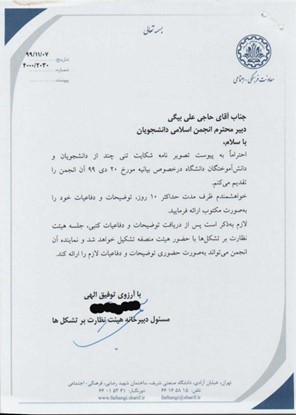 |
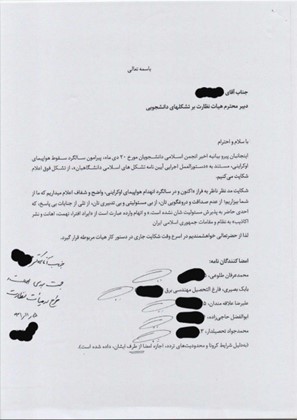 |
Resources:
https://twitter.com/Amirhoseinbeygi/status/1354359413797249024
https://twitter.com/Amirhoseinbeygi/status/1285301495429238789
- 42. Pouria Gozarabadi
From Tehran, Pouria attended the protests, and the charge is unknown.
Current Detention Status: Released on bail.
Resource:
Pouria Gozarabadi - Accused of Supporting Dissident Groups — Iran Prison Atlas (united4iran.org)
- 43. Masoud Hokm Abadi
Movie producer, artist, and manager of Teatrkade Channel from Mashhad, he was arrested for refusing to attend the Fajr Festival in protest of downing the Ukrainian plane. He was sentenced to two years in prison due to “Propaganda against the state - Art. 500 IPC and Insulting the Leader or the Founder of the Islamic Republic of Iran - Art. 514 IPC.”
Current Detention Status: Released, Sentence Confirmed.
Resources:
Masoud Hokm Abadi - Artist or Writer — Iran Prison Atlas (united4iran.org)
- 44. Mehdi Mahmoudian
A political activist and human rights activist from Tehran, attended the protests, and was sentenced to five years in prison due to “Propaganda against the state - Art. 500 IPC and Assembling and colluding to act against national security - Art. 610 IPC.” Four years of his sentence was due to his candle vigil invitation in commemoration of the victims of flight PS752. Elham Zolfaghari, Mehdi Mahmoudian's wife, published an official document from the judiciary on Twitter, writing that her husband's accusation was unreliable, and his arrest was illegal. Zolfaghari has posted the judiciary's official document with IRGC's complaint to the state news agency "IRNA" reporters. The Prosecutor appointed a bail for him. But Mr. Mahmoudian was arrested for failing to produce it. A complaint from the IRGC and a post on Twitter was the reason for filing this case.
Before his arrest a threatening audio file was published. According to BBC Persian, which has access to this audio file, an interrogator from the IRGC intelligence office called Mahmoudian and threatened him to remove his candle vigil invitation, otherwise he would be taken to the notorious Evin prison.
Current Detention Status: Released, Convicted by Court.
Resources:
Mehdi Mahmoudian - Pro-democracy Activist — Iran Prison Atlas (united4iran.org)
فایل صوتی تماس بازجوی سپاه با مهدی محمودیان: خودم میبرمت اوین و از خجالتت در میام - BBC News فارسی
- 45. Koroush Bagheri
From Tehran, attended the protests, and was sentenced to two years in prison and 40 lashes due to “Propaganda against the state - Art. 500 IPC and Insulting the Leader or the Founder of the Islamic Republic of Iran - Art. 514 IPC.” He was taken to Branch 15 of Tehran Revolutionary Court. Judge Salavati has questioned him about "changing religion" in Zoroastrianism. According to information provided by an informed source to IPA, Judge Salavati also questioned him about "insulting Ali Khamenei," but Mr. Bagheri denied the accusation of insulting. According to IPA’s research, Mr. Bagheri has not changed his religion and has only supported Iran's ancient religion. The judge also charged him with "collaborating with foreign governments.”
Current Detention Status: Released, Sentence completed.
Resource:
Koroush Bagheri - Digital Activism — Iran Prison Atlas (united4iran.org)
Kourosh Bagheri | Journalism is not a Crime - Supporting Journalists in Iran
- 46. Farideh Veysi
From Dehgolan, Farideh attended the protests, and charge is unknown.
Current Detention Status: Released on bail, Sentence Suspended.
Resource:
Farideh Veysi - Civic Activist — Iran Prison Atlas (united4iran.org)
- 47. Rob Macaire
The British ambassador to Iran, was arrested during the gathering in memory of flight PS752 victims that was held in front of the University of Amirkabir in Tehran. He was released after a few hours.
48. Rakhshan Bani - Etemad
A film Director and movie producer, he was arrested due to his candle vigil invitation in commemoration of the victims of flight PS752. He was released after a few hours.
- 49. Mohammad Amin Hosseini
A law student who attended the protest and was arrested. The details of his sentence are unclear.
- 50. Mohammad Esmaeili
A student at the University of Tehran, attended the protest and was arrested. The details of his sentence are unclear.
- 51. Moslem Soleimani
- 52. Arshad Atabak
- 53. Xaniar Ahmadpour
According to the Kurdistan human rights network, these three students were arrested on January 15 at the University of Kurdistan by the security forces following a gathering of students at the university to protest the downing of the Ukrainian airliner. Moslem Soleimani, secretary of the Islamic Association of the university, and Arshad Atabak, secretary of the university's Ahoura Association, were released on bail, and Xaniar Ahmadpour's release was made the day after due to his inability to provide bail.
The students had been beaten by security forces while in detention and had no contact with their families during their detention, raising concerns about their fate.
Resources:
https://kurdistanhumanrights.org/fa/?p=11611
https://kurdistanhumanrights.org/fa/?p=11537
https://kurdistanhumanrights.org/fa/?p=11472
- 54. Siavash Hayati
- 55. Ashkan Vaalizadeh
- 56. Salah Gharibi
- 57. Pezhman Amiri
- 58. Nabi Tardast
On January 12, a protest was held at Razi University in Kermanshah, during which at least five students were arrested by security forces. Siavash Hayati, a graduate student in political science and spokesperson for the Yarsan civil society, was beaten and insulted while in detention and bruises were seen on his body. On January 15, Siavash Hayati was released on bail. However, Nabi Tardast, another student arrested at the university, remains in detention and no detailed information has been provided about his condition.
Resources:
https://kurdistanhumanrights.org/fa/?p=11472
http://kurdistanhumanrights.net/fa/?p=11400
- 59. Shiva Ahmadi Sianavi
- 60. Zahra Moradi
- 61. Pedram Hooshyarian
- 62. Maria Saedpanah
- 63. Zahra Saedpanah
- 64. Abdollah Amini Nabi Kandi
- 65. Leila Hosseini
- 66. Yones Fekri
- 67. Mohammad Sina Mirzaei
- 68. Seyed Ghazi Hosseini
- 69. Sarvar Shahabi
Eleven Sanandaji citizens who attended the funeral of two of the victims of the Ukrainian airliner, Arvin Morattab and Aida Farzaneh, demanded the prosecution of the perpetrators and were arrested by police intelligence, and summoned to the revolutionary and criminal court of Sanandaj according to their indictment.
The charges include “Insulting the Leader or the Founder of the Islamic Republic of Iran - Art. 514 IPC, and Assembling and colluding to act against national security - Art. 610 IPC.” and “disrupting public order”.
These eleven citizens were identified by CCTV cameras during the funeral. They were released on bail after two weeks detention temporarily until the proceedings were completed.
Resource:
- 70. Ziauddin Nabavi
- 71. Amir Hossein Ali Bakhshi
- 72. Ali Haghighat Javan
Attended the protest and were charged due to “Assembling and colluding to act against national security - Art. 610 IPC.” and “propaganda against the state.” Shortly before the publication of this report, the court has sentenced Mr. Nabavi to one year in prison, Mr. Bakhshi to four months in prison, and Mr. Haghighat Javan to pay financial punishment in trade for three months imprisonment due to “propaganda against the state”. The court has dropped the charge of “Assembling and colluding to act against national security” for all three of them.
Additionally, Mr. Nabavi received supplementary sentences, which included a two-year ban from leaving the country, providing service to Behesht-e-Zahra Cemetery and veterans’ facilities, and mandatory participation in emotional management classes. Mr. Nabavi made an appeal for reconsideration of his sentences. However, his appeal was rejected without further investigation. His sentences including the supplementary ones were all confirmed.
Current Detention Status: Convicted by court
Resources:
محاکمه ۳ دانشجو به اتهام سوگواری برای سرنگونی هواپیمای اوکراینی! (aftabnews.ir)
Other than the prison sentences for protesters, a number of university students, including 15 students at Mohaghegh Ardabili University, were suspended from their studies.
Appendix G – Intelligence from Operator of an ADU
The following information is based on a conversation with an ADU operator in the Army after the downing of PS752. To protect the identity of this individual, his name will not be revealed in this report.
The operator said, in his experience, sometimes he sees flights that deviate from their usual paths. In this case, defence units’ operators must report this immediately using a wireless system, and not phone calls, so the ATC center contacts the pilot, and asks them to get back to the safe corridor. This line of communication with the center is online 24/7. If the plane doesn't follow the ATC center's instructions, air defence can shoot it down per their protocol.
“John Doe” confirmed that ADUs' radar systems can see squawk codes of civilian passenger flights. Air Defence personnel can touch the plane’s symbol on their radar screen and see their code and all the planes' information.
On January 8th everyone was on high alert at John Doe’s air defence sector and their commander announced that it is a "3-C situation” (in Farsi: 3-ث) which is the war situation. John Doe says it means even that the enemy may have entered the country in this situation.
John Doe said in this so-called "3-C situation" the sky must have been closed but surprisingly he was seeing passenger flights passing through the safe corridors just like nothing had happened and everything was normal.
Per John Doe, General Hajizadeh has said that the operator was informed of a cruise missile attack. John Doe believes whoever, in the defence network, had falsely informed the operator about cruise missiles, must be held accountable for it.
According to John Doe, IADS structure obviously has a hierarchy. It starts from the lowest level (operator) to the higher ranks with a more sophisticated data/command center, ADOC with lots of monitoring measures and radars that have been shown on Iran's national TV multiple times. ADOC is the place where high ranking commanders are stationed and their responsibility is to monitor the radars and determine level of military readiness or start of wars, etc.
There are multiple layers in the chain of command but in general there are three fundamental levels: (lowest) first “Command Post” (CP), the second, “SOC”, and the third “ADOC”.
An air defence system crew reports to its CP, and normally won’t shoot without that CP’s confirmation. CP reports to SOC, where at least 20 people are monitoring 20 radar screens from at least 20 long range regional radars. There are about four SOC centers in the country (N, S, E, W). People in a SOC are trained on how to work with the data that they see and interpret radars and give orders to CP.
According to John Doe, the defence system and chain of command in Artesh are more or less like those of other modern nations' international defence standards.
When the IRGC was expanding its air defence capabilities, some inspectors from IRGC visited Artesh systems and copied how the systems and chain of command works in Artesh. IRGC just changed the names of CP, SOC, ADOC, etc. to some Iranian terms but the structure was the same.
John Doe said everyone thinks the IRGC and Artesh were integrated under command of Khatam-al-Anbiya Air Defence Base but as a matter of fact that wasn’t the case meaning that IRGC was doing its own military activities without coordination with Artesh (although the head of KAADB is from Artesh).
John Doe believes the Tor-M1 unit that shot down PS752 was located near the airport without coordination with Artesh and ADOC.
He refers to General Hajizadeh who said the Tor-M1 Operator was notified of cruise missiles and concludes “if that is a true statement” from the General then the SOC is guilty. Because SOC saw it is not a cruise missile.
John Doe confirms that he was also notified that US war planes were on the border of Iran around an hour prior to the downing of PS752.
The responsibility of people at SOC is very sensitive, because even after all the training and education, they spend at least one year as an observer in SOC without being allowed to make any critical decisions or orders. A basic mistake in detection that misidentifies a cruise missile for a civilian airliner is very unlikely for these people.
As for the Tor-M1, John Doe confirms that finding the true north "doesn't require special expertise.". It is the most basic action. Such a mistake is not rational.”
Appendix H – HESA Iran-140 Project and Sepahan Flight 5915
The Iran-140 was a license-built version of the Antonov An-140, assembled by HESA (Iran Aircraft Manufacturing Industrial Company) in Shahin-Shahr, Iran, from complete knock-down kits supplied by the Antonov Bureau in Kiev, Ukraine.
Due to the aging fleet of Fokker-100 and Boeing-727 aircrafts in Iran, HESA planned to manufacture a “national aircraft” that can fill the gap and respond to the increasing need of regional aviation in Iran. The initial contract was signed in 1996 between HESA (under supervision of the Ministry of Defence and Armed Forces Logistics of Iran) and Antonov Company.
The engine types used on Iran-140 were Klimov TV3-117VMA-SBM1 with 2000 hp converted from originally helicopter Turboshaft to Turboprop engines that were not suitable for most of Iran’s Hot-and-High airports due to an EEC (Electronic Engine Control) environmental qualification limitation of 35 degrees of Celsius. Such temperature limitation on EEC and FCS (Fuel control System) had a direct impact on the engine performance that was known to HESA and CAO.IRI (Civil Aviation Organization of Islamic Republic of Iran) during their certification flight test campaign.
Such system reliability issues contributed to multiple FTV (Flight Test Vehicle) crashes causing the cancellation of all orders from Safiran and Iran Police Forces. However, HESA created Sepahan airline and sold aircraft to “HESA-owned” Sepahan and did not admit the HESA Iran-140 project failure. The Iranian civil aviation organization issued a type and supplemental type certificate for operation of An-140 in Iran despite all known technical issues. The IR CAO, with limited technical knowledge and resources about the An-140 and no experience or history of substantiating a passenger airplane, decided to authorize the newly named Iran-140 to fly in Iran. This resulted is crashes and deaths until the former president of Iran, decided to revoke the operation of An-140s in 2014.
Sepahan Flight 5915
Sepahan Airlines Flight 5915 was a scheduled domestic passenger flight from Iranian capital Tehran Mehrabad International Airport to Tabas, South Khorasan Province, Iran. On August 10, 2014, the HESA Iran-140 twin turboprop serving the flight crashed shortly after takeoff from Mehrabad International Airport, killing 40 passengers and six crew on board.
Survivors recalled that the right engine of the aircraft malfunctioned during its take-off. Analysis on the aircraft's logbook revealed that numerous errors and failures had been recorded on the right engine:
● In April 2014, at least 2 engine failures were recorded.
● On April 23 and April 24, while en route to Bandar Abbas, the right engine failed during the aircraft's cruising stage.
● On April 28, the engine failure warning light was illuminated for a short time.
● On April 29, during the inspection on both engines, a corrosion on the left engine's compressor blade was discovered by ground crews.
● Just 3 days before the crash, on August 7, during its flight from Tabriz to Isfahan, a violent shaking was recorded on the right engine. The FDR recorded this shaking, and the warning alarm was triggered. A sensor replacement was conducted to eliminate the problem. However, after the replacement there was a difference in the shaking of the right engine and the left engine, which was deemed by investigators as unreliable.
Further investigation revealed that the right engine failure was caused by a malfunction on the aircraft's Fuel Control System (FCS) and aircraft's Electronic Engine Control (EEC) known as SAU-2000 (Russian САУ-2000). The SAU-2000 didn't work as expected in which the system caused a 17 second delay on the feathering of the aircraft (known issues for HESA and CAO). Investigations showed the temperature in the EEC bay reached 40 degrees of Celsius. Also, reports on previous studies on the Antonov An-140's SAU-2000 system revealed that there had been some modifications on the software of the system due to the fact that previous occurrences revealed that the system had caused numerous engine failures with a rate that was above the acceptable level. The modifications were not effective as the failure rate was not reduced to an acceptable level.
Although the malfunctions of EEC and FCS (Fuel Control System) as well as the limitation of operating temperature limitations (35 degrees of Celsius) of these systems were completely known for IR CAO, but CAO was considering the aircraft airworthy under heavy influence of HESA and the Ministry of Defence and Armed Forces Logistics.
On the day of Sepahan Airlines Flight 5915 crash, HESA and the Ministry of Defence and Armed Forces Logistics of Iran prevented all domestic media including the Islamic Republic of Iran Broadcasting from naming the airline and the airplane involved in the crash. Finally, in the afternoon or the crash day, the crashed airplane was named as an “Antonov 140” but not “IrAn-140” in the news.
The deadly An-140 program is another example of Iran’s civil aviation authority being influenced by the Ministry of Defence and Armed Forces Logistics of Iran (as a military entity) and heavily controlled by the IRGC. Can the same group, responsible for violating international civil aviation organization standards in aircraft substantiation, be expected to be trusted with the investigation of PS759?
Appendix I – List of Individuals Referenced in the Text
| Name | Position on/after January 8, 2020 | Rank | Current Position |
|---|---|---|
| Abdul Rahim Mousavi | Commander in Chief of Army | Army General | No Change |
| Abdolreza Pourshasb | Deputy of Khatam-al-Anbiya Headquarter | Army General | No Change |
| Abdolreza Rahmani Fazli | Interior Minister | |
| Abolfazl Mousavi Byouki | Deputy Chairman of the Civil Commission of the Iranian Parliament at the time | |
| Abolfazl Shekarchi | Spokesperson of Armed Forces | IRGC General | No Change |
| Agnes Callamard | UN Special Rapporteur | Secretary General of Amnesty International |
| Ahmad Kazemi | Commander of IRGC Air Forces | IRGC General | No Change |
| Ahmad Zargar | Judge and executive of the Tehran Revolutionary Court (Branch 36) | |
| Alexander Lukashenko | Dictator of Belarus | |
| Alexander Ruvin | The head of Ukrainian forensic team | |
| Ali Abdollahi Aliabadi | Deputy coordinator of Military joint chiefs of staff | IRGC General | No Change |
| Ali Abedzadeh | Head of CAO.IRI | Removed |
| Ali Bagheri Kani | Head of High Council of Human Rights in Iran's Judiciary | Deputy Minister of Foreign Affairs |
| Ali Larijani | Speaker of the Parliament | Former IRGC commander | Removed |
| Ali Rabiei | Spokesperson of the Government | |
| Ali Rezvani | Journalist- Interrogator | |
| Ali Rostami | Previous IKA Airport manager | |
| Ali Shamkhani | Chairman of Supreme National Security Council | IRGC General | No Change |
| Alireza Sabahifard | Commander of Army Air Defence Force | Army commander | No Change |
| Alireza Tangsiri | Commander of IRGC Navy Force | IRGC General | No Change |
| Amir Esmaeilzadeh | Commander of the Bushehr Defence Centre | Army commander |
| Amir Hatami | Minister of Defence | Army General | Removed |
| Amirali Hajizadeh | Aerospace Commander | IRGC General | No Change |
| Arash Khodaei | Head of PS752 Investigation team - Successor to Hassan Rezaeifar | |
| Christiaan Triebert | Journalist in the New York Times' Visual Investigation Team and former Senior Investigator with investigative group Bellingcat | |
| Dmytro Kuleba | Ukraine's foreign minister | |
| Donald Trump | President of USA | |
| Ebrahim Hatami | Deputy prosecutor | |
| Esmail Qaani | Commander of IRGC Quds Force | IRGC General | No change |
| Farhad Parvaresh | I.R Rep in ICAO | |
| Farzad Esmaili | Commander of Khatam-al-Anbiya 2011-2018 | Army commander | No change |
| Gholam Abbas Torki | Iran’s Former Military Prosecutor of Tehran | Deputy of General Inspection Office |
| Gholam Hossein Esmaeili | Judiciary spokesperson | |
| Hamid Baeidi Nejad | I.R Ambassador in UK | |
| Hasan Norouzi | Parliament member | Clergyman |
| Hassan Rezaeifar | Head of AAIB | |
| Hassan Rouhani | Then President | Clergyman |
| Hesamuddin Ashena | President's Consultant | |
| Hossein Ashtari | Head of Enforcement Police | IRGC General | No change |
| Hossein Salami | Commander in chief of IRGC | IRGC General | No change |
| Hossein Shariatmadari | Editor in Chief of Kayhan Newspaper | IRGC commander | No change |
| Hossein Taeb | Head of IRGC Intelligence Organization | Clergyman | No change |
| Houshang Shahbazi | Former Pilot and Flight Engineer of IranAir | Captain |
| Ebrahim Raisi | Head of Judiciary | Clergyman | President |
| Imam Mahdi | The twelfth Imam in Shia's beliefs | |
| Javad Karimi Ghodoosi | Parliament member | IRGC commander | No change |
| Javad Soleimani | A survivor of PS752 | |
| Justin Trudeau | Prime Minister of Canada | |
| Karlo Kopp | Defence Analyst of think tank Air Power Australia | |
| Laaya Joneidi | Vice President of Legal Affairs | Lawyer |
| Manouchehr Moradi | I.R Ambassador in Ukraine | |
| Mansour Sattari | Commander of Army Air Forces | Army General | No change |
| Marc Garneau | Canada’s Minister of Transport | Canada’s Minister of Foreign Affairs |
| Michael O'leary | CEO of Ryan Air | |
| Michael Page | Deputy Middle East director at Human Rights Watch | |
| Mike Mihajlovic | Military Expert, Author, and Former Canadian Armed Forces Officer | |
| Milad Sadeghi | Aviation and aerospace legal rights researcher | |
| Mohammad Bagher Nobakht | Head of Plan and Budget Organization | |
| Mohammad Eslami | Iran’s Minister of roads and urban development | Civil Engineer | Head of Atomic Energy Organization of Iran |
| Mohammad Hossein Bagheri | Chief of Staff for the Armed Forces | IRGC General | No change |
| Mohammad Javad Jamali Nobandegani | Parliament member | Medical doctor |
| Mohammad Javad Zarif | Minister of Foreign Affairs | Removed |
| Mohammad Mehdi Karbalaie | IKA Manager | IRGC commander | No change |
| Mohammad Pakpoor | Commander of IRGC Ground Force | IRGC General | No change |
| Mohammad Shahriari | Head of the criminal court of Tehran | |
| Mohammad Reza Naghdi | Deputy Coordinator of IRGC | IRGC General | No change |
| Mohammad Reza Norouzpour | Head of IRNA News Agency | |
| Mohsen Baharvand | Deputy of Foreign Affairs | Ambassador in the UK |
| Mojtaba Zonnour | Chief of National Security Commission in Iran’s Parliament | Clergyman |
| Nasser Seraj | Military Prosecutor of Tehran- Successor of Torki | |
| Oleg. I. Sukharevsky | Professor in Kharkiv National Force University, Author | |
| Qader Rahimzadeh | Deputy commander of Khatam-al-Anbiya | Army commander | No change |
| Ralph Goodale | Special Advisor of Prime Minister of Canada | |
| Ruhollah Khomeini | First Supreme Leader of I.R. Iran | Clergyman |
| Sadegh Arabzadeh | Lead Investigator of PS752 in Tehran’s Military Court | |
| Saeed Jalili | Supreme Leader's representative in SNSC | |
| Saeed Khatibzadeh | Spokesperson of Ministry of Foreign Affairs | |
| Saeed Ohadi | Head of the Foundation of Martyrs and Veterans | Civil Engineer |
| Salvatore Sciacchitano | President of ICAO | |
| Sayyed Abbas Salehi | Minister of Culture and Islamic Guidance | Clergyman |
| Sayyed Ali Khamenei | Supreme Leader | Clergyman | No Change |
| Sayyed Hossein Naghavi Hosseini | Then Spokesperson of Parliament’s National Security Commission | |
| Sayyed Mahmoud Alavi | Iran’s Minister of Intelligence | Clergyman |
| Shokoufeh Habibzadeh | Shargh newspaper's reporter | Reporter |
| Shokrollah Bahrami | Head of Judicial Organization of Armed Forces | Clergyman |
| Touraj Dehghani Zangeneh | Head of CAO | Pilot |
| Yadollah Asgari | "trusted" attorney of the Islamic Republic of Iran | Lawyer |
Appendix J – Inspection Report of Electronic Devices
REFERENCES
- ↑ Joshua Berlinger, Mohammed Tawfeeq, Barbara Starr, Shirzad Bozorgmehr, & Frederik Pleitgen. (2019). Iran shoots down US drone aircraft, raising tensions further in Strait of Hormuz. CNN
- ↑ Rory Jones, Vivian Salama, & Aresu Eqbali. (2019). Trump says downing of u. S. Drone may have been unintentional. Wall Street Journal
- ↑ C. Horowitz Michael, E. Kreps Sarah, & Fuhrman Matthew. (2019). Analysis | Yes, Iran shot down a U.S. drone. Here’s why you (Still) don’t need to worry. Washington Post.
- ↑ Barbara Starr. (2020/12/24). US says Iranian acked militias 'almost certainly' behind recent rocket attack near US embassy in Baghdad. CNN
- ↑ Zachary Cohen, Hamdi Alkhshali, Kareem Khadder, & Angela Dewan. (2020/01/04). US drone strike ordered by Trump kills top Iranian commander in Baghdad. CNN
- ↑ J. Burns William & Jake Sullivan. (2020/01/06). Soleimani’s ultimate revenge. The Atlantic.
- ↑ Qasem Soleimani: Stampede kills 50 mourners at burial in Iran. (2020/01/07). BBC News.
- ↑ Iran Parliament unanimously ratifies ‘harsh revenge’ motion. (2020/01/07). Mehr News Agency.
- ↑ Turak Natasha. (2020/01/07). Cyberattack and proxy violence warnings as Iran threatens 'nightmare' revenge against US. CNBC
- ↑ City Imam Khomeini Airport. (2020/01/01). Mohammad Mahdi Karbalaei appointed as the board's chairman at IKAC. mam Khomeini Airport City.
- ↑ تجمع کفنپوشان منتقم در فرودگاه امام (Video). (2020/01/07). Mashregh News.
- ↑ Denmark had six hours' warning of Iranian attack on Iraqi bases: TV. (2020/01/10). Reuters.
- ↑ 13.0 13.1 CBS (60 Minutes). (2021). Never before seen video of the attack on Al Asad Airbase (Video).
- ↑ Iran missile attack: Did Tehran intentionally avoid US casualties? (2020/01/08). BBC News.
- ↑ 752AFV. (2021). Iran TV interview with Hajizadeh (Video). Youtube.
- ↑ 16.0 16.1 16.2 16.3 16.4 16.5 Ashley Burke & Nahayat Tizhoosh. (2020/07/03). Iran dumps Flight 752 investigator after he suggests Tehran kept airspace open to conceal 'imminent' attack. CBC News.
- ↑ Top Iranian general: Strikes on US bases were just start of big operation. (2020/01/10). Times of Israel.
- ↑ رد شایعات درباره دلایل غیرطبیعی سقوط هواپیما. نقص فنی، علت اصلی سانحه بود. (2020/01/08). ISNA.
- ↑ ماجرای اصابت موشک به هواپیمای اوکراینی چیست؟ ادعای رسانههای غربی و تکذیب ایران+عکس. (2020/01/09). Aftab News.
- ↑ عابدزاده: امکان انفجار هواپیمای اوکراینی بر اثر شلیک موشک از لحاظ فنی وجود ندارد. (2020/01/09). IRNA.
- ↑ 21.0 21.1 The Sun. (2020). Iran plane crash - Donald Trump says 'I have my suspicions' as shot down theory emerges (Video). Youtube.
- ↑ Ryan Flanagan & Ben Cousins. (2020/01/09). Intelligence indicates Flight PS752 was shot down by Iran: Trudeau. CTV News.
- ↑ بیانیه سخنگوی دولت درباره سقوط هواپیما و عملیات روانی آمریکا. (2020/01/10). Mehr News Agency.
- ↑ پرواز ۷۵۲: روایت یک فاجعه. (2020/04/20). BBC News فارسی.
- ↑ اطلاعیه ستادکل نیروهای مسلح درباره سقوط هواپیمای اوکراینی. (2020/01/11). Islamic Republic of Iran News Network.
- ↑ Fassihi Farnaz. (2020). Anatomy of a Lie: How Iran Covered Up the Downing of an Airliner. The New York Times.
- ↑ 27.0 27.1 27.2 27.3 27.4 Global Affairs Canada. (2020). Factual analysis: The downing of Ukraine international airlines flight PS752. Government of Canada.
- ↑ NBC News. (2020). Iran's FM Mohammad Javad Zarif: ‘We Were Very Close To A War’ (Video). Youtube.
- ↑ هیئت اوکراینی در تهران: نمیپذیریم که در ازای لاپوشانی حقیقت، پول دریافت کنیم. (2021/10/18/). Radio Farda.
- ↑ آخرین وضعیت پرداخت غرامت جانباختگان هواپیمای اوکراینی. (2021/01). Alef News Agency.
- ↑ Mike Blanchfield. (2020/05/04). Iran chief's link to 1988 massacre raises obstacles in crash probe: Cotler. CBC News.
- ↑ Daniel Kwasi Adjekum. (2020/02/12). Here's how airplane crash investigations work, according to an aviation safety expert. The Conversation.
- ↑ 33.0 33.1 Leonid Kanfer. (2021/01). The documentary film by Leonid Kanfer "The Mystery of the Death of Romeo" (Video).
- ↑ Pan Am flight 103. (1988). Encyclopedia Britannica.
- ↑ Black box recovered in deadly Ethiopian Airlines crash, and other top stories (Video). (2019). CityNews.
- ↑ Jr. R. W. Apple. (1985). Second 'black box' is recovered from atlantic in air india crash. The New York Times.
- ↑ Malaysia Airlines MH17 crash: Black boxes recovered from the wreckage. (2014). The Economic Times.
- ↑ 752AFV. (2021). PS752 Blackbox (Video). Youtube.
- ↑ Rory Jones & Aresu Eqbali. (2020/01/21). Iran’s flip flop over black boxes raises concerns on crash investigation. Wall Street Journal.
- ↑ جعبه سیاه هواپیمای اوکراینی را تحویل نمیدهیم! . (2020/02/15). Kayhan London.
- ↑ وزیر دفاع: جعبه سیاه هواپیمایاوکراینی آسیب دیده است. (2020/02/19). Tabnak.
- ↑ Minister of Transport advocates for Safer Skies at ICAO Council to improve aviation safety near or over conflict zones. (2020/03/11/). Transport Canada.
- ↑ Berthiaume Lee. (2020/04/12). Canada asks Iran to delay download of Flight 752 black boxes due to COVID-19. CTV News.
- ↑ تصمیم ایران در مورد جعبه سیاه هواپیمای اوکراینی اعلام شد. (2020/06/22). Hamshahri Online.
- ↑ Burke Ashley. (2020). Audio from Flight PS752's cockpit downloaded this morning, says TSB. CBC News.
- ↑ The Associated Press. (2020/08/23). Iran retrieves data, cockpit conversations from Ukraine Flight 752 black boxes. CBC News.
- ↑ ICAO: Frequently Asked Questions. How is it decided which States will participate in an aircraft Accident Investigation? (2016). ICAO.
- ↑ [ICAO. (2015). Manual of Aircraft Accident and Incident Investigation. Doc 9756 AN/965. Part I Organization and Planning. In: International Civil Aviation Organization Montréal.]
- ↑ مشاور وزیر راه مدیرعامل شهر فرودگاهی امام شد. (2019/12/21). Tasnim News Agency.
- ↑ Marine Industries Group. (2019).
- ↑ فایل صوتی ظریف؛ قاسم سلیمانی مانع دیپلماسی بود. (2021/04/25). Radio Farda.
- ↑ دو انتصاب جدید در صنعت هوانوردی کشور. (2020/08/05). IRNA.
- ↑ Shokoufeh Habibzadeh. (2020). مدرك جعلي آقاي رئيس.
- ↑ Tom Vanden Brook, Chris Woodyard, & John Bacon. (2020/01/10). Iran plane crash: U.S., Canada say intel shows Ukraine jet downed by Iranian missile. USA Today.
- ↑ 55.0 55.1 55.2 PS752 downing: Ukraine releases intercepted tower communications proving Iran was aware of missile launch all along. (2020/02/02). Ukrainian Independent Information Agency.
- ↑ یاسوج سقوط هواپیمای تهران ؛ مجلس سازمان هواپیمایی کشوری و شرکت آسمان را مقصر دانست. (2020/05/18). BBC News فارسی.
- ↑ 752AFV. (2020). 752AFV Petition #2: do not fly over iran airspace.
- ↑ 58.0 58.1 Kathy Fox. (2021/03/18/). Release of Iran's final safety investigation report into the downing of PS752. Transportation Safety Board of Canada.
- ↑ Lufthansa to resume flights from Frankfurt to Tehran this month. (2021/04/02). Reuters.
- ↑ Airspace of Iran. (2021). European Union Aviation Safety Agency.
- ↑ Leader appoints new commander of Khatam Al Anbia Air defence Base. (2019/05/29). Isna News Agency.
- ↑ 62.0 62.1 62.2 752AFV. (2021). Air Defence Operation Cente Part 1 (Video). Youtube.
- ↑ 752AFV. (2021). Amir Ali Hajizadeh's contradictory statements about air defence system (Video). Youtube.
- ↑ 752AFV. (2021). Air Defence Operation Center Part 3 (Video). Youtube.
- ↑ 752AFV. (2021). Air Defence Operation Center Part 2 (Video). Youtube.
- ↑ جانشین قرارگاه پدافند هوایی خاتم الانبیاء (ص): همه تحرکات هوایی منطقه را زیر نظر داریم. (2019/09/17). Student News Network.
- ↑ سردار حاجیزاده: ایران جزو ۱۰ کشور اول در حوزه رادار است. (2020/10/06). Tasnim News Agency.
- ↑ فرمانده نیروی پدافند هوایی ارتش: هر پرنده با هر کاربردی را شناسایی می کنیم. (2021/09/01). ISNA.
- ↑ 752AFV. (2021/08). The association’s statement: principal culprits of the ps752 downing protected by “prohibition of prosecution order”.
- ↑ نخستین سیستم یکپارچه پدافند هوایی ایران آغاز به کار کرد. (2015/09/04). BBC News فارسی.
- ↑ 71.0 71.1 71.2 Mike S. Mihajlovic. (2020). Jetliner Down: Tor-M1 Missile System Which Downed Ukrainian Flight PS752. UNICORN Publishing Group.
- ↑ Jean Christophe Peuch. (2006). Missile systems deal with iran confirmed. RadioFreeEurope/RadioLiberty.
- ↑ 752AFV. (2021). Tor M1 System (Video). Youtube.
- ↑ 74.0 74.1 74.2 74.3 Oleg I. Sukharevsky. (2014). Electromagnetic Wave Scattering by Aerial and Ground Radar Objects (1st ed.). CRC Press.
- ↑ 75.0 75.1 Kopp Carlo. (2009). 9K330/9K331/9K332 Tor M/M1/M2 Self Propelled Air Defence System / SA 15 Gauntlet / Cамоходный Зенитный Ракетный Комплекс 9К330/9К331//9K332 (APA TR 2009 0705).
- ↑ Tor-M1. (2021).
- ↑ 752AFV. (2021). Copy of IRIB Interview with Torki (Video). Youtube.
- ↑ 752AFV. (2021). Amir Ali Hajizadeh speaking about downing of Flight #PS752 (Video). Youtube.
- ↑ 752AFV. (2021). General Hossein Salami speaking about the downing of Flight PS752 (Video). Youtube.
- ↑ Dennis Romero & Yuliya Talmazan. (2020/01/06). Trump threatens attacks on 52 sites if Iran retaliates for Soleimani killing. NBC News.
- ↑ حاجیزاده: میخواستیم ۴۰۰ نقطه را بزنیم، منظور ترامپ از «نقطه فرهنگی» زدن بیت رهبری بود. (2020/04/24). Iran International.
- ↑ 82.0 82.1 Hoffmann Christiane. (2020/01/24/). "It's a Disaster for Europe To Be So Subservient to the U.S". Der Spiegel.
- ↑ توضیحات شمخانی درخصوص علت تاخیر در اعلام دلیل سقوط هواپیما (Video). (2020/01/13). Student News Network.
- ↑ 84.00 84.01 84.02 84.03 84.04 84.05 84.06 84.07 84.08 84.09 84.10 84.11 84.12 84.13 84.14 ایران دفتر بررسی سوانح و حوادث هوایی ج ا. (2021/03/15). بررسی سانحه پرواز PS752 گزارش نهایی. Mehr News Agency.
- ↑ 752AFV. (2021). Part of Ali Abdollahi's speech on IRIB NEWS (Video). Youtube.
- ↑ 86.0 86.1 86.2 86.3 بررسی سانحه سقوط هواپیمای اوکراینی با حضور وزیر راه / سیستم پدافندی جدید در شناسایی هواپیما خطا کرده است. (2020/01/12). Islamic Consultative Assembly News Agency.
- ↑ 87.0 87.1 Head of IRGC Aerospace Division accepts responsibility for plane crash. (2020/01/11). Iran Press.
- ↑ 88.0 88.1 اطلاعیه ستادکل نیروهای مسلح درباره سقوط هواپیمای مسافربری اوکراین. (2020/01). IRNA.
- ↑ Tony Pallone. (2017). Tomahawk Missiles: Everything You Need to Know. Engineering360.
- ↑ 90.0 90.1 Appendices of the AAIB’s Final Report. (2021). ICO.IR.
- ↑ فیلم کامل سخنان فرمانده کل سپاه درباره سقوط هواپیمای مسافربری اوکراینی (Video). (2020/01/12). Aparat.
- ↑ واکنش سخنگوی کمیسیون امنیت ملی به حادثه سقوط بوئینگ۷۳۷: مگر کفتر بازی است که میگویید اشتباه فردی؟ (Video). (2020/01/12). Khabaronline News Agency.
- ↑ نقوی حسینی: قطعا خرابکاری و نفوذ درماجرای سقوط هواپیمای اوکراینی بوده/ مصاحبهام برای برائت سپاه بود. (2020/01/13). Iran Online.
- ↑ برنامه گفتگوی ویژه خبری شبکه۲ | برسی علل سقوط ه.اوکراینی س.عبداللهی معاونت هماهنگ.ستاد کل ۱۳۹۸/۱۰/۲۴ (Video). (2020). Youtube.
- ↑ Norman Polmar & Thomas B. Allen. (2016/02/21). Naval Weapon of Choice. Naval History Magazine, 30.
- ↑ Tomahawk cruise missile. (2021). US Navy Office of Information.
- ↑ جزئیات مهم جلسه کمیسیون امنیت ملی مجلس درباره سقوط هواپیمای اوکراینی/ ذوالنوری: فرضیه حمله سایبری منتفی است. (2020/01/19). Khabaronline News Agency.
- ↑ در مورد کریمی قدوسی در ویکی تابناک بیشتر بخوانید. (2021). TABNAK.
- ↑ Javad Karimi Ghodousi. (2020/01/21). ناگفته های سقوط هواپیمای اوکراینی (Video). Aparat.
- ↑ تشریح حادثه هواپیمای اوکراینی از زبان آقای کریمی قدوسی. (2020/01/23). Tebyan.
- ↑ 101.0 101.1 101.2 101.3 101.4 101.5 PS752 Accident Investigation, FACTUAL REPORT. (2020/06). CAO.IR.
- ↑ 102.0 102.1 Christiaan Triebert (@trbrtc). (2020/01/10).
- ↑ Jeremy Bogaisky. (2020/01/15). If Iranian Troops Really Thought Ukraine Flight 752 Was A Cruise Missile, They Made A ‘Hail Mary’ Shot. Forbes.
- ↑ Automatic Dependent Surveillance Broadcast (ADS B). (2019). National Business Aviation Association.
- ↑ 105.0 105.1 105.2 Ian Petchenik. (2020). Ukrainian flight PS752 shot down shortly after take off from Tehran. Flightradar24 Blog.
- ↑ Magnetic Declination in Tehran, Iran. (2021).
- ↑ 107.0 107.1 107.2 107.3 107.4 107.5 Mandate of the Special Rapporteur on extrajudicial, summary or arbitrary executions. (2020/12/24). United Nations High Commissioner for Human Rights (OHCHR).
- ↑ 752AFV. (2021). Downing of Flight PS752 Report from Iran TV (Video). Youtube.
- ↑ 109.0 109.1 جزئیات تازه از سانحه هواپیمای اوکراینی از زبان دادستان نظامی تهران. (2020/06/29). IRNA.
- ↑ از شلیک کروز تا شلیک پدافند. (2020/01/11). IRNA.
- ↑ آیا سپاه «تور ام ۲» ایرانی را میسازد?.07/10/2019 Mashregh News.
- ↑ Lauren Leatherby, Denise Lu, Anjali Singhvi, James Glanz, & Niraj Chokshi. (2020). Flights In and Out of Tehran Continued After Missile Strikes and Plane Crash. The New York Times.
- ↑ Аналітика, безпека, економіка, міжнародна політика, культура. Зміст має значення! The Ukrainian Week.
- ↑ Ukraine: recordings show iran knew jetliner hit by missile. (2020/02/03). VOA.
- ↑ Iran plane downing: Tehran ends co operation with Ukraine. (2020/02/03). BBC News.
- ↑ Administration Federal Aviation. (2021). Section 5. Radar Separation. In FAA Order JO 7110.65Z - Air Traffic Control. Federal Aviation Administration.
- ↑ Colamosca Brian. (2003). A Brief History of the Reduced Vertical Separation Minimum (RVSM). International Civil Aviation Organization.
- ↑ Tyler Whiting. (2020/04/27). GPS celebrates 25th year of operation United States Space Force.
- ↑ Yaghoub Fazeli. (2020/05/27). Passengers of downed Ukrainian plane in ‘state of panic’ before attack: Official. Al Arabiya English.
- ↑ 120.0 120.1 120.2 120.3 120.4 120.5 120.6 Iran: Ukraine Airline Victims’ Families Harassed, Abused. (2021/05/27). HRW.
- ↑ Michael Page. (2019). HRW.
- ↑ 122.0 122.1 Zia Nabavi (@ZiaNabavi1). (2021/04/03).Twitter.
- ↑ 752AFV. (2021). Cleaning and cover up the site where flight PS752 crashed, before investigation (Video). Youtube.
- ↑ 752AFV. (2021). IRGC officers ransacking the belongings of the passengers of flight PS752, looking for valuabales (Video). Youtube.
- ↑ Ukrainian aviation investigation head suggests PS752 passengers were out of their seats. (2020/05/20). bne IntelliNews.
- ↑ Search area expanded as divers look for Lion Air plane black boxes. (2018). SBS News.
- ↑ 752AFV. (2021). Harassment of the families from the first days.
- ↑ Zimonjic Peter, Burke Ashley, & Everson Kristen. (2020/10/28). Family members of PS752 victims report receiving threats for speaking out against Iranian regime. CBC News.
- ↑ 129.0 129.1 روحانی: بر محاکمه مسببین حادثه هواپیمای اوکراینی اصرار داریم. (2021/01/07). Hamshahri Online.
- ↑ دادستان نظامی تهران ابعاد جدیدی از سقوط هواپیمای اوکراینی را تشریح کرد. (2021/01/07). IRNA.
- ↑ 752AFV. (2021). The families of the victims of Flight PS752 gathered at the Tehran Military Court. (Video). YouTube.
- ↑ Global Affairs Canada. (2021). Canada confirms receipt of iran’s accident investigation final report on downing of ukraine international airlines flight 752. Government of Canada.
- ↑ Ukraine rejects Iran's final report on downing of flight PS752. (2021/03/17). BBC News.
- ↑ صدور کیفرخواست برای ۱۰ نفر در پرونده هواپیمای اوکراینی. (2021/04/06). ISNA.
- ↑ PS752Justice (@PS752Justice). (2021/05/01). ابلاغیه دادسرای نظامی به خانواده های شاکی در ایران Instagram.
- ↑ اعتراضها به سرنگونی هواپیمای مسافربری توسط سپاه، به شهرهای مختلف کشیده شد. (2020/01/12). Radio Farda.
- ↑ Scores injured as security forces use unlawful force to crush protests in iran. (2020). Amnesty International.
- ↑ بازداشت ۳۰ نفر در تجمعات چند روز اخیر. (2020/01/14). ISNA.
- ↑ World Report 2021: Rights Trends in Iran. (2021/01/13). Human Rights Watch.
- ↑ محاکمه ۳ دانشجو به اتهام سوگواری برای سرنگونی هواپیمای اوکراینی! (2021/04/05). Aftab News.
- ↑ 141.0 141.1 Iranian Student Imprisoned for Protesting Downing of Ukrainian Plane. (2020/09/28). Iran Human Rights Monitor.
- ↑ Roghayeh Bigdeli - Arrested in Relation to Demonstrations. (2020/01/11). Iran Prison Atlas.
- ↑ افزایش محکومیت رقیه بیگدلی در پی عدم معرفی جهت اجرای حکم تبعید. (2021). هرانا.
- ↑ MASOUD HOKM ABADI. (2020). اطلس زندانهای ایران.
- ↑ 145.0 145.1 ۴۱ سال زندان برای ۲۷ معترض به شلیک سپاه به هواپیمای اوکراینی. (2021/01/08). BBC News فارسی.
- ↑ Hossein Massoumi (@HosseinMassoumi). (2021/01/26). Twitter.
- ↑ فیلم/ اشاره رهبر انقلاب به شهدای هواپیمای اوکراینی (Video). (2021/01/09). Mashregh News.
- ↑ جانباختگان سانحه هواپیمای اوکراینی شهید محسوب میشوند. (2020/01/14). IRNA.
- ↑ رهبر ایران از شلیک سپاه به هواپیمای اوکراینی عذرخواهی نکرد. (2020/01/17). BBC News فارسی.
- ↑ 752AFV. (2020/07/19). Video of the first days from IRIB, shows #PS752 blackbox getting opened in Iran’s CAO which includes FDR and CVR (Video)Facebook.
- ↑ وزیر دفاع ایران: جعبه سیاه هواپیمای اوکراینی آسیب دیده است. (2020/02/19). Deutsche Welle.
- ↑ Iran Foreign Minister Zarif: Full interview with NBC News’ Richard Engel (Video). (2020/02/14). NBC News.
- ↑ Ashley Burke. (2020/03/11). Iran's COVID 19 crisis delaying planned transfer of Flight 752's black boxes to Europe. CBC News.
- ↑ کانادا دانلود جعبههای سیاه هواپیمای اوکراینی را بهتعویق انداخت. (2020/04/12). IRNA.
- ↑ از سرگیری مذاکرات برای آغاز پروازهای اروپایی به ایران. (2020/05/08). ISNA.
- ↑ ۱۲۷ جانباخته هواپیمای اوکراینی شهید اعلام شدند. (2021/01/03). Mashregh News.
- ↑ Khamenei orders Iran unrest victims treated as 'martyrs'. (2019). France 24.
- ↑ Anna Raskaya. (2020/04/15). پیشنهاد محرمانه ایران به اوکراین بر سر پرواز ۷۵۲. Radio Farda.
- ↑ دور سوم مذاکره ایران و اوکراین با موضوع تعیین غرامت. (2020/11/22). Mehr News Agency.
- ↑ Бондар Андрей. (2020/11/08). "UIA tragedy near Tehran": Yenin spoke about the progress of the investigation. Replyua.net.
- ↑ واحد شمارش بی مسوولیتی در ایران هواپیماست. (2020/07/22). Independent Persian.
- ↑ ««سقوط هواپیما» معیار خامنهای برای مرگ بیماران کووید۱۹: کرونا را جدی بگیرید؛ فکر کنید هر دو روز یکبار یک هواپیما سقوط کند! (2020/09/21). Kayhan London.
- ↑ Mahdi Khazali (@mahdi_khazali). (2021/08/22). Twitter.
- ↑ فراخوان طراحی یادمان جان باختگان هواپیمای مسافربری اوکراین. (2020/03/06). سازمان زیباسازی شهر تهران.
- ↑ دادگاه سینما رکس - قسمت 1 (Video). (2016). Youtube.
- ↑ VOA. (2013). سینما رکس را چه کسانی آتش زدند؟ (Video). Youtube.
- ↑ آیا سینما رکس آبادان و مسجد جامع کرمان را به دستورخمینی آتش زدند؟ (Video). (2018). Youtube.
- ↑ سرنگونی ایرباس؛ جنایتی عمدی یا سهوی؟. (2017/10). Mehr News Agency.
- ↑ Seyed Davood Aghaee. (2013). چالش های حقوقی فراروی ایران و آمریکا بر سر پرونده ایرباس. فصلنامه مطالعات روابط بین الملل, 6(22), 9-34.
- ↑ Iran Air flight 655. (1988). Encyclopedia Britannica.
- ↑ US missile shoot down - iran air flight 655 documentary (Video). (2016). Youtube.
- ↑ پردهبرداری از ۱۰ قرارگاه منطقهای نیروی زمینی سپاه. (2020/03/27). Radio Farda.
- ↑ ۱۷ سرلشکر جمهوری اسلامی ایران را بشناسید + عکس. (2019/04/22). Mizan Online News Agency.
- ↑ Mark MacKinnon & Steven Chase. (2021/04/16). Ukraine now says it believes Iran intentionally shot down Flight 752. The Globe Mail.
- ↑ حافظه تاریخی (@hafezeh_tarikhi). (2019/06/04). Twitter.
- ↑ حفظ جمهوری اسلامی و اجب است یا جان امام معصوم علیه السلام ؟/ اسلام، قائم به شخص امام نیست؛ بلکه قائم به اصل امامت است. (2018/09). Hawzah News.
- ↑ تشکیل زنجیره انسانی در اطراف نیروگاه بوشهر. (2015/02/14). Khabaronline News Agency.
- ↑ Haque Adil Ahmad. (2020). Human Shielding (by Omission) in Iran.
- ↑ Faramarz Davar. (2020/04/27). The Guards Used Khamenei's Audience as a Human Shield. IranWire.
- ↑ 752AFV. (2020). یک کلام از هواپیمای عزیزان ما که خودشان به آن شلیک کردند نگفت (Video).
- ↑ Raskaya Anna. (2020/04/14). Exclusive: Iran Pushing Ukraine Not To Take Action For Downed Plane. Radio Farda.
- ↑ The Associated Press. (2020/03/11). Iran sends downed Ukrainian passenger jet's black box to France for analysis. CBC News.
- ↑ Mark MacKinnon. (2020). Iran agrees to send flight recorders from downed Ukrainian airliner to Kyiv. The Globe Mail.
- ↑ 752AFV. (2021/05/20). Ontario court rules shoot down of ps752 an intentional act of terrorism. 752AFV.
- ↑ 185.0 185.1 Ashley Burke & Nahayat Tizhoosh. (2021/05/21). Iran condemns Ontario court's ruling that destruction of Flight PS752 was a terrorist act. CBC News.
- ↑ International Court of Justice.
- ↑ Universal Jurisdiction Law Practice in Canada. (2020). Trial International.
- ↑ Attack on PS752: Iran violated multiple human rights obligations - UN experts. (2021/02/23). United Nations Human Rights.
- ↑ Iran says U.N. investigator lacks authority to comment on downing of Ukrainian plane. (2021/02/25). Reuters
- ↑ Sarah Teich & Daniel Eisen. (2021). Protecting innocents in combat. Canadian Coalition Against Terror, Macdonald Laurier Institute.
- ↑ Belarus plane: Ryanair boss says pilot had no choice but to l in Minsk. (2021/06/15). BBC News.
